The key to packing in all the highlights that this Yosemite day trip itinerary has to offer is to start your day early. Plan on arriving at a park entrance station by 7AM.
An early arrival will help you avoid time-wasting, long lines at the fee stations and allow for ample time to pack in as much fun to your Yosemite day trip as possible.
Note: This itinerary is designed for people coming in from the west side of the park via highways 120, 140, or 41. If you are coming from the Eastern Sierras, I suggest you focus your itinerary on the many Yosemite attractions off Tioga Road.
When Should I Take My Yosemite Day Trip?

The best time of year to visit Yosemite and see its waterfalls at peak flow is late spring and early summer. In addition to flowing falls, you will also be able to enjoy longer days, so you will get the most out of your Yosemite day trip.
The downside to visiting during late spring and early summer is that it can be crowded, especially on weekends. Stay ahead of the crowds by arriving as early as possible, but expect that you will be sharing this magical place with the masses.
If you are crowd averse, consider taking your Yosemite day trip during the early fall. The weather is still warm, the days are still relatively long, and the crowds are low.
The main downside to visiting during the early fall is that many waterfalls can be dried up (like showstopper Yosemite Falls) or running at a trickle.
Late fall and winter in Yosemite are both gorgeous, but road closures are frequent due to weather. Glacier Point and Tioga Road are typically closed from the first significant snowfall through at least Memorial Day.
Reservation System for 2024 in Yosemite National Park
Yosemite National Park recently announced that will require reservations for select dates April through October, 2024 in order to decrease overcrowding in the park.
From April 13 through June 30, a reservation is required from 5am – 4pm on Saturdays, Sundays, as well as May 27and June 19, which are government holidays.
From July 1 through August 16, a reservation is required from 5am – 4pm daily.
From August 17 through October 27, a reservation is required from 5am – 4pm on Saturdays, Sundays, as well as September 2 and October 14, which are government holidays.
Reservations are also required in February during “Firefall season” when Horsetail Fall can glow orange when it’s backlit by sunset, which can make it appear to be on fire. These dates are February 10 -11, 17 – 19, and 24 – 25 in 2024.
Reservations will begin being released on January 5 at 8am and be available in advance. Some afternoon reservations and full-day reservations will be released one week in advance of the date as well.
What Should I Bring on My Yosemite Day Trip?
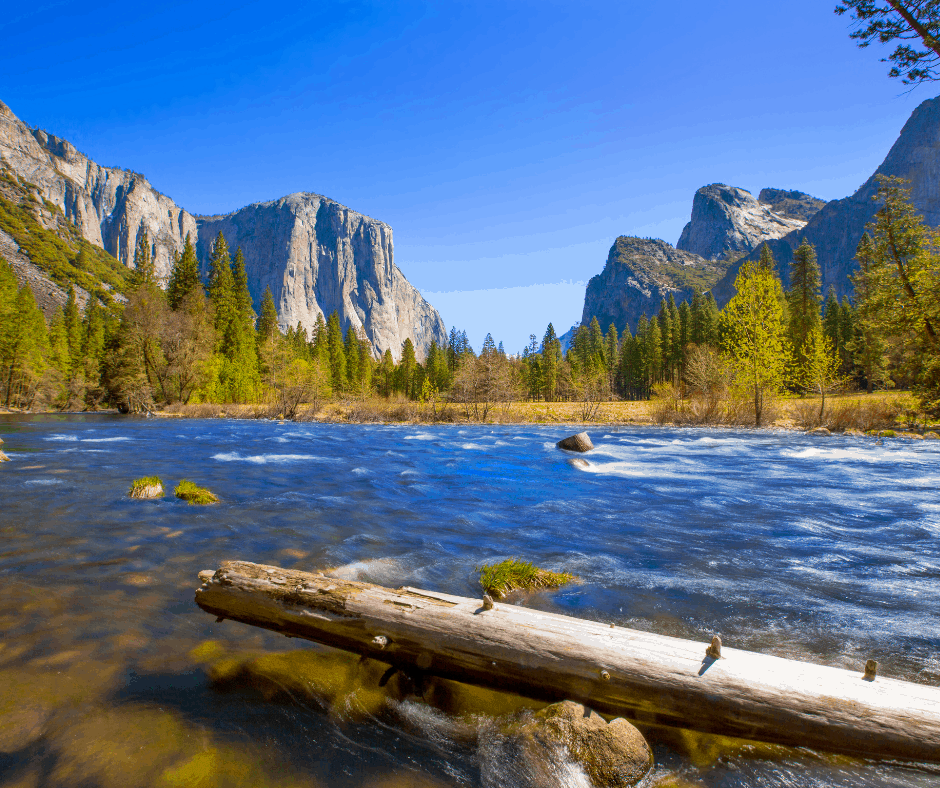
Since you are planning on arriving early in the morning, I suggest you pack a breakfast. I would also be sure to have plenty of snacks in your daypack, as well as a reusable water bottle. Sturdy, comfortable shoes are a must.
There are several places to eat inside of Yosemite Valley, so you don’t need to pack lunch of you don’t want to. Other essentials for your daypack include sunscreen, a small first aid kit, sunglasses, a hat, a backup phone battery, and a camera.
The weather in Yosemite can vary, so be sure to check the forecast and be prepared to layer. A lightweight rain jacket is always good to have on hand, especially if the spray from the waterfalls is intense or there is potential for rain in the forecast.
Ready to visit more California national parks? Check out this Joshua Tree Day Trip Itinerary.
Itinerary for One Day in Yosemite National Park
1. Visit a Sequoia Grove
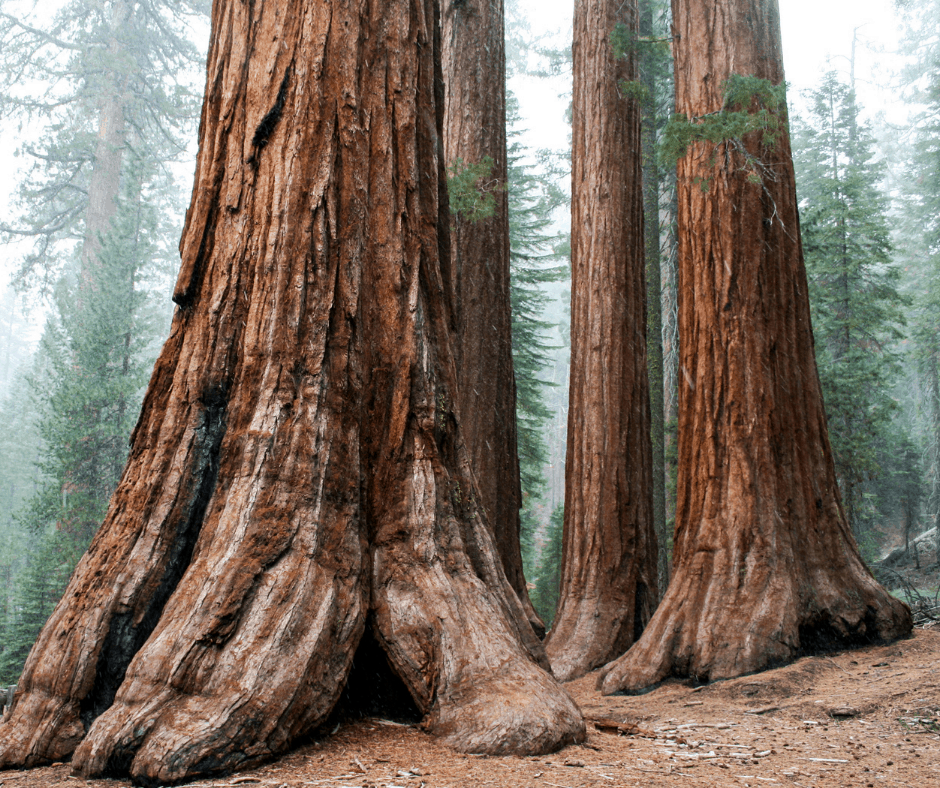
Yosemite is home to some of the largest trees on the planet, and has three different giant sequoia groves. Stopping to walk through one is a must, especially if you have never seen a sequoia in person before.
If you are coming from Southern California, you will likely use the entrance on Hwy 41. Just two miles from that entrance is Mariposa Grove. It is the largest and most accessible sequoia grove in the park.
There are a few different trails in this grove, but since you are short on time, I suggest hitting the highlights- Fallen Monarch, Grizzly Giant, and the California Tunnel Tree.
If you are entering the park from Northern California, you are likely going to use the Hwy 120 entrance. Merced Grove and Tuolumne Grove are both off this highway.
Unlike Mariposa Grove, these groves require that you take a short hike to see the sequoias. Both hikes lose 500 feet in elevation on the way to the sequoia groves. The hike to Merced Grove is 1.5 miles and the hike to Tuolumne Grove is a mile.
Both trails are wide and well-maintained. They are a great way to get the blood flowing in the morning before you head into Yosemite Valley.
Note: There are no sequoia groves off Highway 140. I suggest you visit Tuolumne Grove, which is the closest to that entrance.
2. Take in the Yosemite Valley at Tunnel View
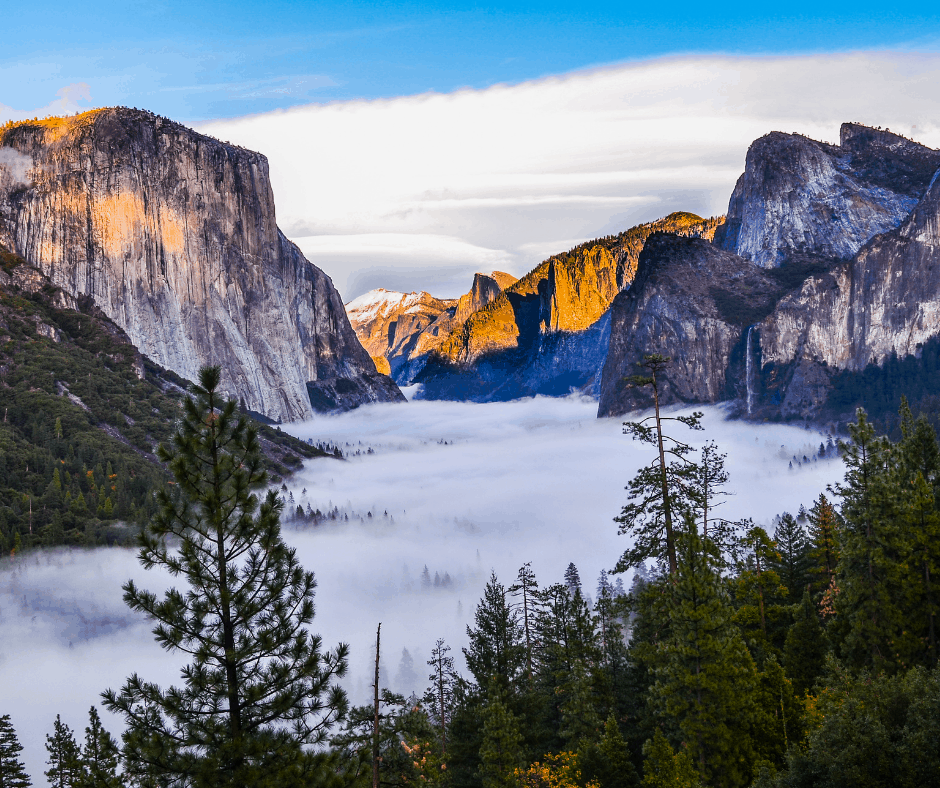
The next stop on your Yosemite day trip should be Tunnel View. This roadside pullout has some of the best views of the Yosemite Valley.
From Tunnel View you can see many of the Valley’s superstars including Bridalveil Fall, El Capitan, and Half Dome. This is the spot to get the perfect Yosemite Valley photo.
If you are coming into the park from Hwy 41, you will pass through a mile-long tunnel and see the famed pull-off shortly thereafter.
If you are coming from Hwy 120 or 140, follow the signs for Bridalveil Fall. The parking lots for Tunnel View will be just before you enter the tunnel. There are lots on either side of the road.
3. Stop and Admire Bridalveil Fall
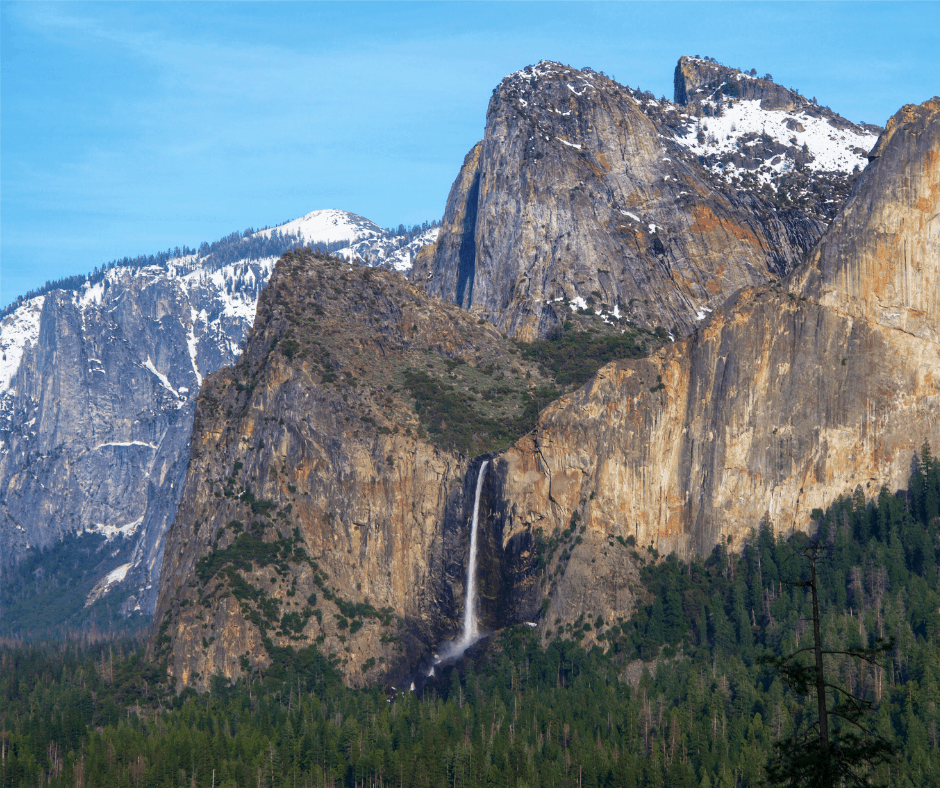
After stopping to admire those Valley views, hop back in the car for a very short jaunt over to the Bridalview Fall parking lot. From the lot is it a short, quarter-mile walk to the base of this 620-foot waterfall.
The trail is paved and this waterfall runs year round. You will be able to feel the spray from the falls when you are close to the base, so prepare to get a little wet.
4. Park and Peruse the Visitor Center and Surrounding Museums
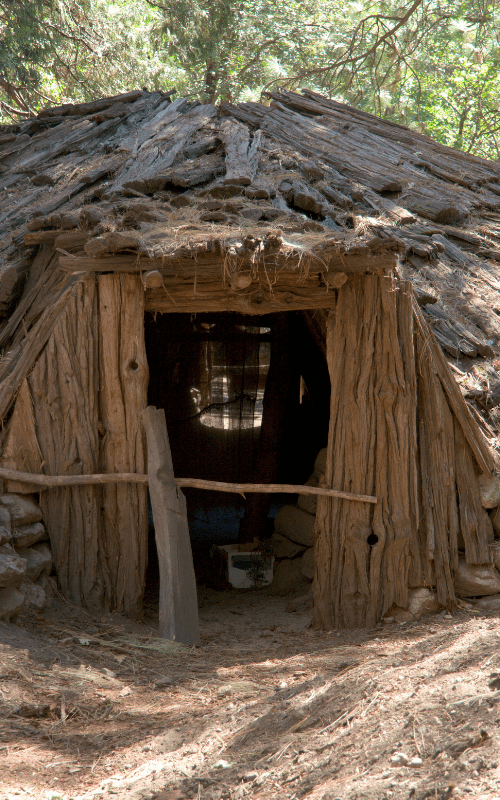
Parking can be a a challenge in Yosemite Valley during the high season, so prepare to park your car and leave it until you are ready to leave the Valley.
Thankfully, it is easy to explore the Valley via YART, Yosemite Valley’s free shuttle, as well as on foot or on bike.
I suggest parking in the lot closest to the visitor center (hopefully you arrived early!). Do not leave any traces of food in your car! Bear sightings are common and bears are well known for breaking into cars for food.
I always like to check out a National Park Visitor Center early in my visit to gain the latest information about special programs and closures, grab a Junior Ranger booklet for my kids, and quickly check out the exhibits.
The visitor center is also where I get my National Park Passport booklet stamped and pick up a patch for my National Park collection. There is also a park movie playing in the visitor center’s theater which is usually worth watching.
Next door to the visitor center is the Yosemite Valley Museum and the outdoor Indian Village of the Ahwahnee. These free museums focus on the original inhabitants of the Yosemite Valley.
It is worth your time to walk through the recreated village to see a variety of Miwok dwellings like the Chief’s House, a sweatlodge, a couple different bark houses and a Miwok cabin.
The Ansel Adams Gallery is also near the visitor center. It is a good place to walk through if you are interested in the famous photographer’s work.
5. Embark on a Tour of Yosemite Valley
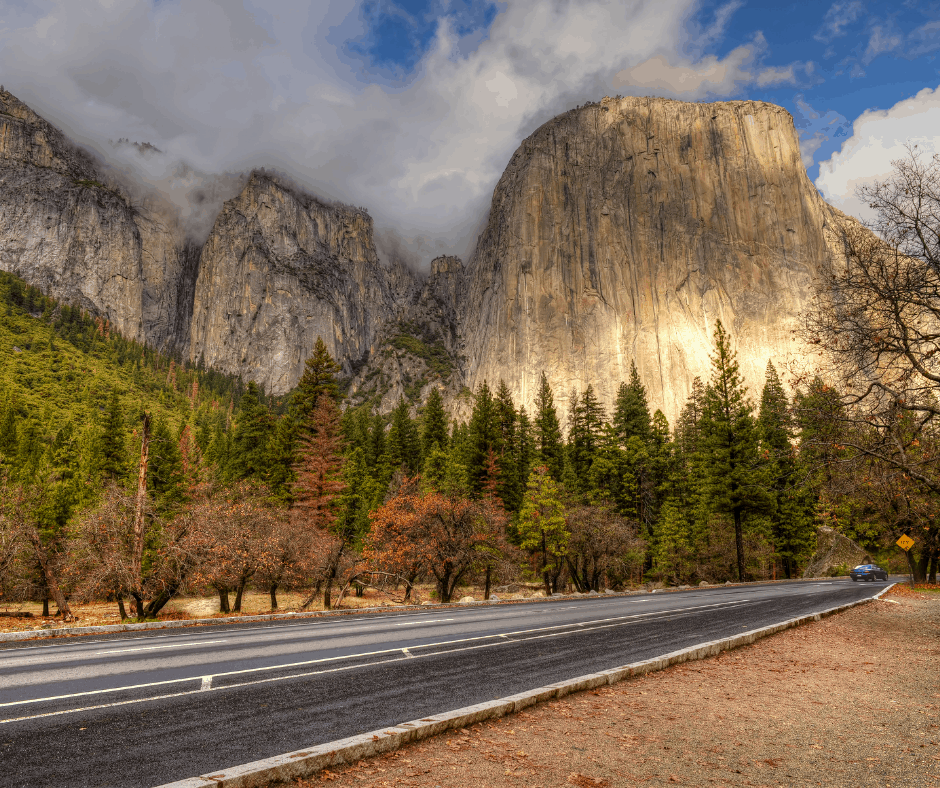
If you want to take tour led by the experts themselves, then definitely sign up for the Yosemite Valley Floor Tour at the Yosemite Valley Lodge.
You can call (209) 372-1240 for tour availability and times for the day you are visiting, but usually the first tour is at 10AM, so try to get on that one! Tours cost $38 for adults and $28 for children.
Tours are led by Yosemite park rangers in open air trams. They provide you with a great overview of the Valley as well as plenty of history and fun facts. The open air tram allows you opportunities to get some great photos along the way.
Highlights of the tram tour include Yosemite Falls, Half Dome, El Capitan, and some sites you might have already see like Tunnel View and Bridalveil Fall. Still, the overlap is worth your time because you will get lots of great information about the sites.
6. Bike the Yosemite Valley
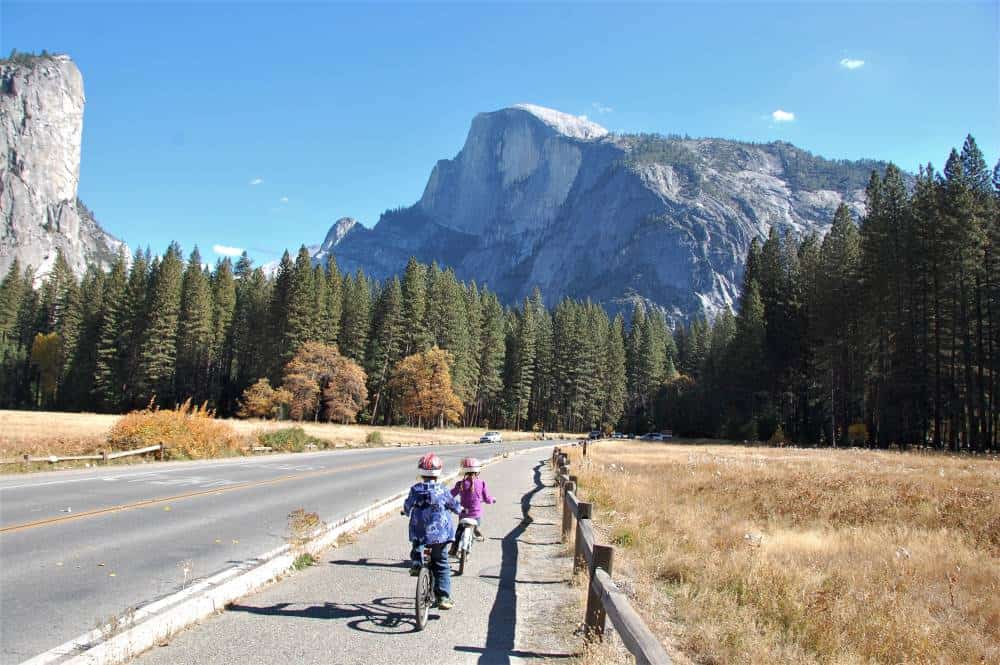
If the Yosemite Valley Tour is not available or sitting in an open air tram for two hours is not your thing, maybe biking around Yosemite is more your speed.
Biking around the Yosemite Valley is quite easy, since the terrain is mostly flat and the paths are wide and plentiful. You can bring your own bikes or rent them at Curry Village or the Yosemite Valley Lodge. Bike rentals are typically available late May through mid-October.
On a Yosemite day trip I prefer to rent bikes from Yosemite Valley Lodge because the walk from the visitor center parking to the bike rental stand isn’t too far and you can take time to see Yosemite Falls along the way.
There are 12 miles of paved trails that loop around the Valley Floor. On these trails it is easy to cover the 7-mile length of the Valley in a short period of time, all while taking in meadows, granite monoliths, and the meandering Merced River.
Be sure to hit the highlights- watch rock climbers scale El Capitan, enjoy views from Sentinel Bridge, keep your eyes peeled for wildlife in the meadows and along the river, and make time to stand near the base of Yosemite Falls.
Note: Bikes are not allowed on dirt trails.
7. Take the Hike to the Vernal Falls Footbridge
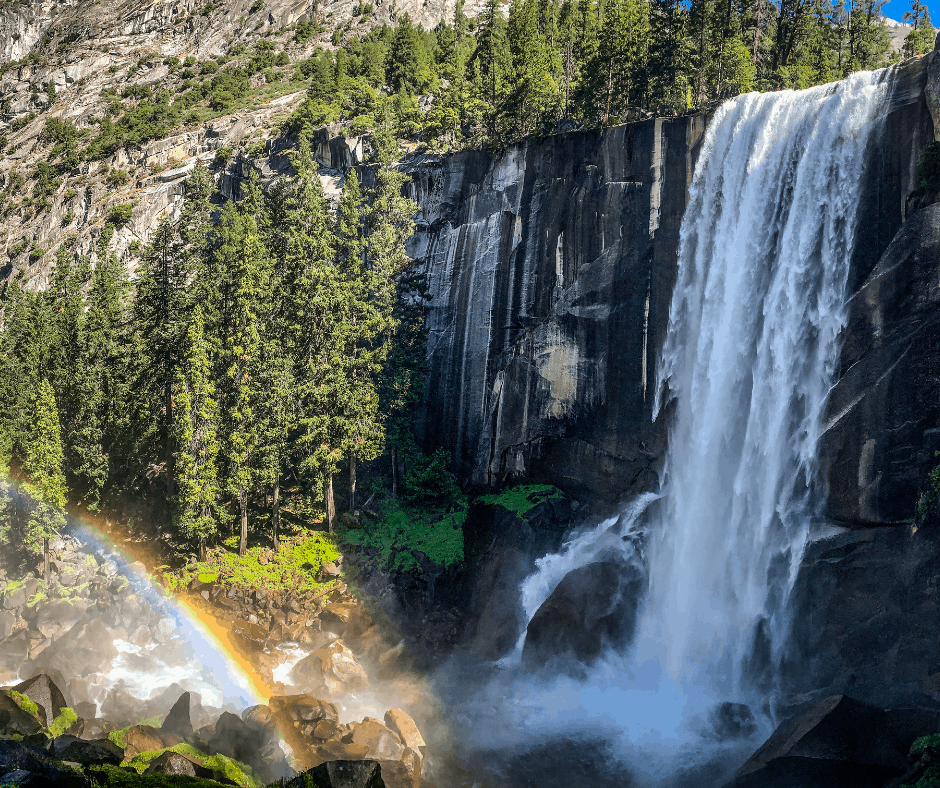
The Mist Trail is one of the most popular trails in all of Yosemite because it is the route to Vernal Falls, Nevada Falls, and Half Dome.
Since you only have one day in Yosemite, you won’t have time to make the 5.4-mile round trip hike to Nevada Falls or the 15-mile trek to the top of Half Dome, but you will be able to make the 1.6-mile hike to the Vernal Falls footbridge.
The hike is mostly uphill on the way to the footbridge and is considered moderate, but shouldn’t be hard for anyone moderately in shape.
From the bridge you will have a nice view of Vernal Falls, especially during peak flow. You can continue uphill another .4 miles to get a view from the top of Vernal Fall. Expect to get wet from the fall’s mist as you climb the stone steps (this is how the mist trail got its name).
Love to hike? Here are 16 Easy Hikes in Yosemite National Park.
8. Take a Break on the Ahwahnee Patio
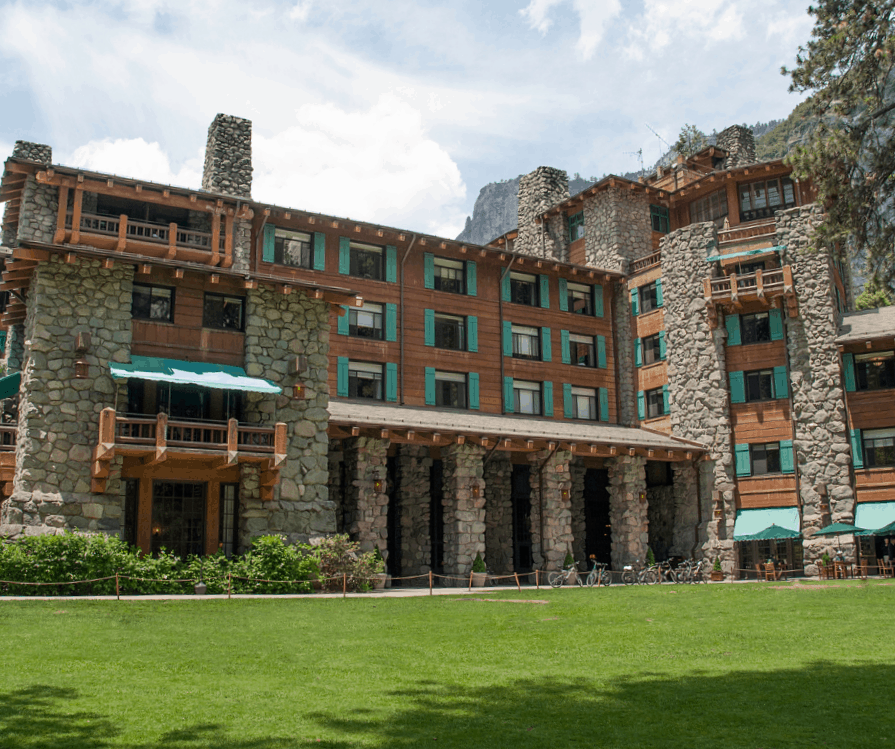
The Ahwahnee Hotel is probably the most famous of all the National Park lodges. This grand hotel was used by Stephen Mather, the first National Park director, to lure the rich and important so they would visit the incredible Yosemite Valley and see why it was worth funding.
The patio area of the Ahwahnee has lovely views and a sprawling grass lawn where wildlife sightings are common- I once saw a bobcat! It is a great place to sip on a cocktail or eat a sandwich.
If you are closer to Curry Village when you are ready for a break, the Curry Village Pizza Patio & Bar is a good spot to relax and enjoy pizza or a salad washed down with a beer.
9. See Yosemite Valley from above at Glacier Point

Your time in Yosemite Valley has come to an end, but there is still more to see!
Glacier Point sits high above Yosemite Valley at 7,200 feet in elevation, and offers incredible views of the High Sierras, Half Dome, and the Yosemite Valley floor 3,200 feet below.
You will reach Glacier Point by heading out of Yosemite Valley, following Wawona Road through the tunnel, and then taking a left turn onto Glacier Point Road. The entire route is 32 miles, but expect it will take an hour to get there.
Glacier Point is extremely popular and you may have to wait for a parking spot, but be patient because the views are worth it! So is the ice cream from the seasonal ice cream stand.
The walk from the parking lot to Glacier Point is nothing more than a quarter mile round trip. If you want to stretch your legs and have time before the sun sets, consider taking the hike up to the top of Sentinel Dome which is nearby. The views are spectacular and it is a great way to end your epic Yosemite Day trip.
Note: The road to Glacier Point is closed from the first significant snowfall (typically early November) through mid-May, typically. Check road conditions if you are visiting during the shoulder seasons.
]]>Most people spend their time in the Yosemite Valley, but the park is huge! Areas like the high country of Tioga Pass and the sequoia groves of South Yosemite should be be included on your hiking itinerary. Here are my 16 favorite easy hikes in Yosemite.
Yosemite is one of 75 California Landmarks to See Before You Die.
Important to know: Yosemite National Park recently announced that will require reservations for select dates April through October, 2024 in order to decrease overcrowding in the park.
From April 13 through June 30, a reservation is required from 5am – 4pm on Saturdays, Sundays, as well as May 27and June 19, which are government holidays.
From July 1 through August 16, a reservation is required from 5am – 4pm daily.
From August 17 through October 27, a reservation is required from 5am – 4pm on Saturdays, Sundays, as well as September 2 and October 14, which are government holidays.
Reservations are also required in February during “Firefall season” when Horsetail Fall can glow orange when it’s backlit by sunset, which can make it appear to be on fire. These dates are February 10 -11, 17 – 19, and 24 – 25 in 2024.
Reservations will begin being released on January 5 at 8am and be available in advance. Some afternoon reservations and full-day reservations will be released one week in advance of the date as well.
Easy Hikes in Yosemite Valley
1. Lower Yosemite Falls
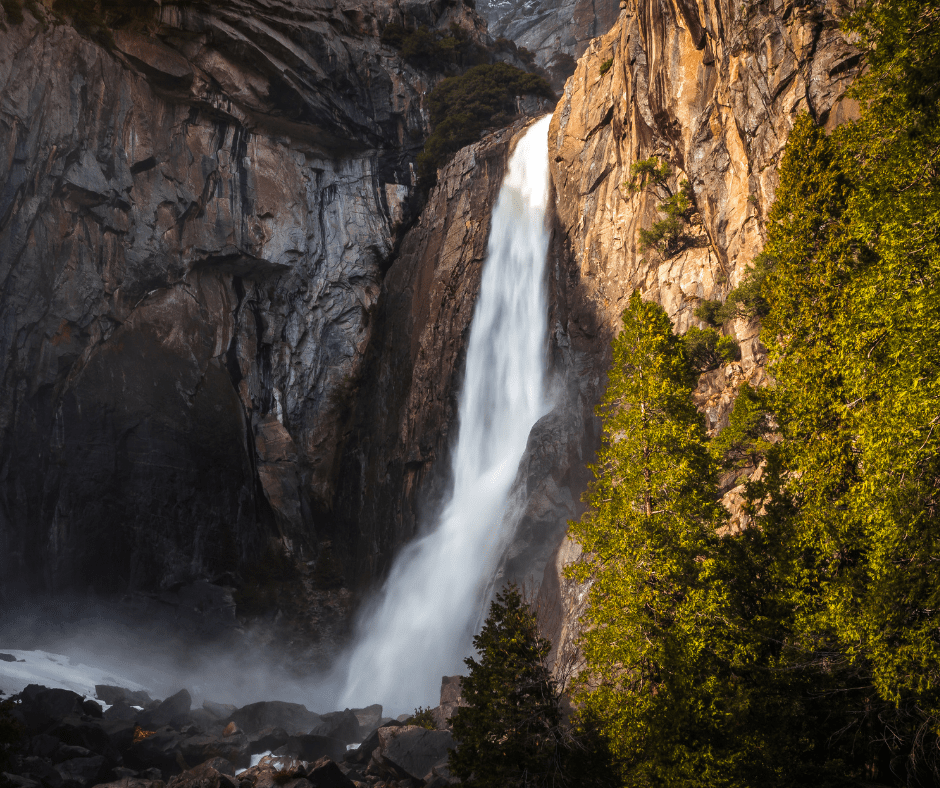
Distance: 1 mile round trip
Elevation Change: 50 feet
There’s a reason that the walk to the base of Yosemite Falls is one of the most popular hikes in Yosemite National Park. The walk to Lower Yosemite Falls is almost entirely flat and the entire loop is paved. Plus, the view from the base of the falls is amazing!
Lower Yosemite Falls are especially impressive during the spring snowmelt. During this time, the waterfall is raging, and the spray close to the falls on the bridge is constant.
Yosemite Falls can completely disappear (or be nothing but a trickle) from late summer until the rain starts again in mid to late fall.
You can reach Yosemite Falls on the Yosemite Valley shuttle by getting off at shuttle stop 6. Here is a map of the free Yosemite Valley Shuttle service.
2. Bridalveil Fall

Distance: 1/2 mile round trip
Elevation Change: 80 feet
The walk to Bridalveil Fall is one of the easiest hikes in all of Yosemite Valley. It is a short, quarter-mile jaunt to the base of this 620-foot waterfall.
The trail is paved and this waterfall runs year round. You will usually be able to feel the spray from the falls when you are close to the base which is quite refreshing on a warm day.
Bridalveil Fall is often one of first stops people make as they are driving into Yosemite Valley. Park your car for a quick pitstop before heading into the main part of Yosemite Valley. There is no shuttle service to the waterfall.
3. Mirror Lake
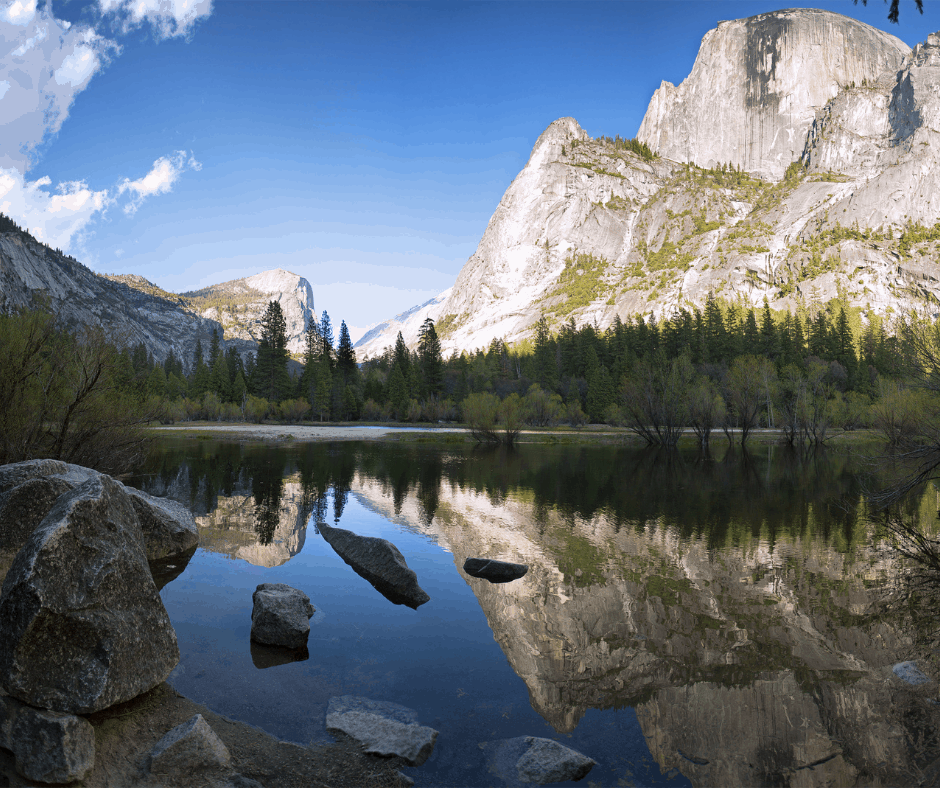
Distance: 2 miles round trip
Elevation Change: 100 feet
Mirror Lake is a lovely place to enjoy in the spring and early summer when it is most full. During the snowmelt, you can gaze at the lake and enjoy the reflection of the surrounding granite cliffs. By late summer, it is very small and not much to look at.
The trail to Mirror Lake is a popular family hike. Mirror Lake is accessed via a paved road, making this a a great trail for strollers and bikes. You can access the Mirror Lake Trail via shuttle stop 17.
The elevation gain is slight until the final quarter mile when it heads steeply uphill. Many families ride bikes the first 3/4 of a mile and then walk the final stretch.
You can extend your hike to 5 miles by taking the loop follows Tenaya Creek, crosses two bridges and returns to Mirror Lake.
4. Cooks Meadow
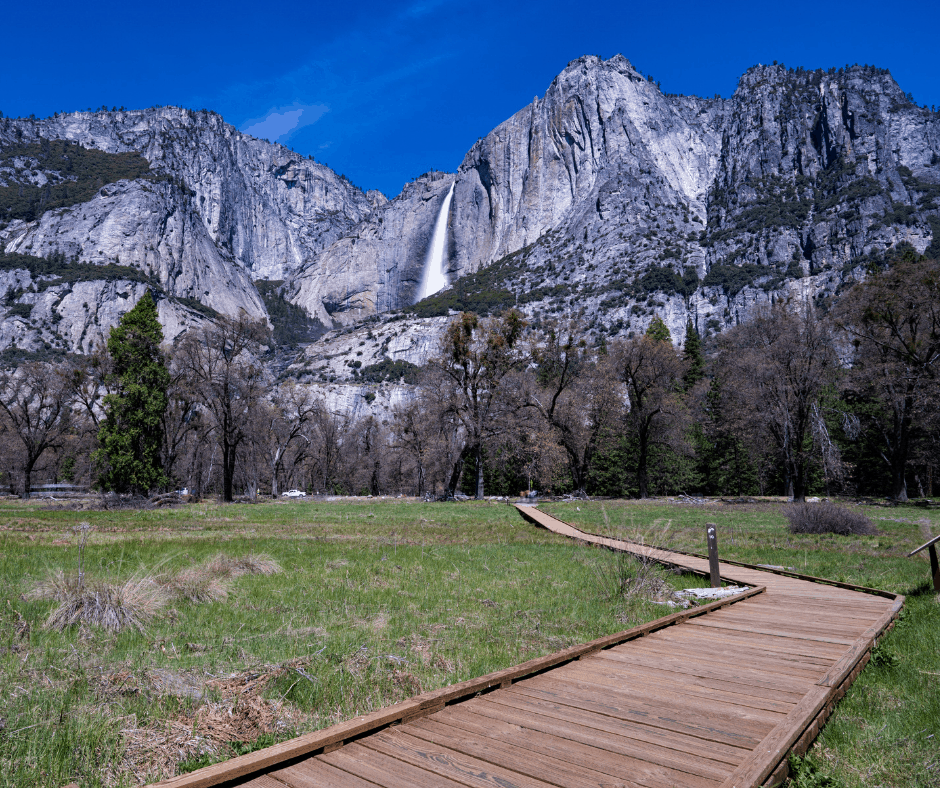
Distance: 1 mile round trip
Elevation Change: Minimal
Cooks Meadow is a wonderful place to take some great shots of the Yosemite Valley, especially during the “golden hour”. It is a simple, flat 1-mile loop with great views of Valley stunners like Half Dome and Yosemite Falls.
The path is paved in some sections and a boardwalk in others. It can be accessed via the Sentinel Bridge Parking Area at shuttle stop 11 or via shuttle stop 6 across the street from the Lower Yosemite falls trailhead.
I suggest combing this trail with the Sentinel Meadow Trail for a 2.25-mile loop. On this loop you will have the chance to cross two bridges over the Merced River and get some exceptional pictures.
Note: This is also a great loop to bike. Bring your own or rent from the stand near Yosemite Valley Lodge.
5. Mist Trail to Vernal Fall Footbridge

Distance: 1.6 miles round trip
Elevation Change: 400 feet
This the most difficult of the easy hikes in Yosemite Valley. It isn’t a particularly long hike, but it is uphill on the way to the falls.
The Mist Trail is very popular, as people heading to Vernal Fall, Nevada Fall, and points further all use this trail. Still, the hike uphill is worth the effort because the view of Vernal Fall from the footbridge is incredible.
You can continue uphill another .4 miles to get a view from the top of Vernal Fall. Expect to get wet from the fall’s mist as you climb the stone steps (this is how the mist trail got its name).
The Mist Trail can be accessed on Yosemite Valley shuttle stop 16.
Easy Hikes in Yosemite Near Glacier Point
7. Glacier Point Trail

Distance: 1/3 mile round trip
Elevation Change: Minimal
This is much more of walk from than the parking lot than a hike, but it is certainly something you won’t want to miss. Glacier Point is located high about the Yosemite Valley, and the views are mesmerizing.
Gazing down at Curry Village 3200 feet below, the cars in the parking lot look like ants! You can take in the entire valley from up here, as well as High Sierras.
El Capitan looks small from Glacier Point and Half Dome is near eye level, instead of towering above.
8. Sentinel Dome
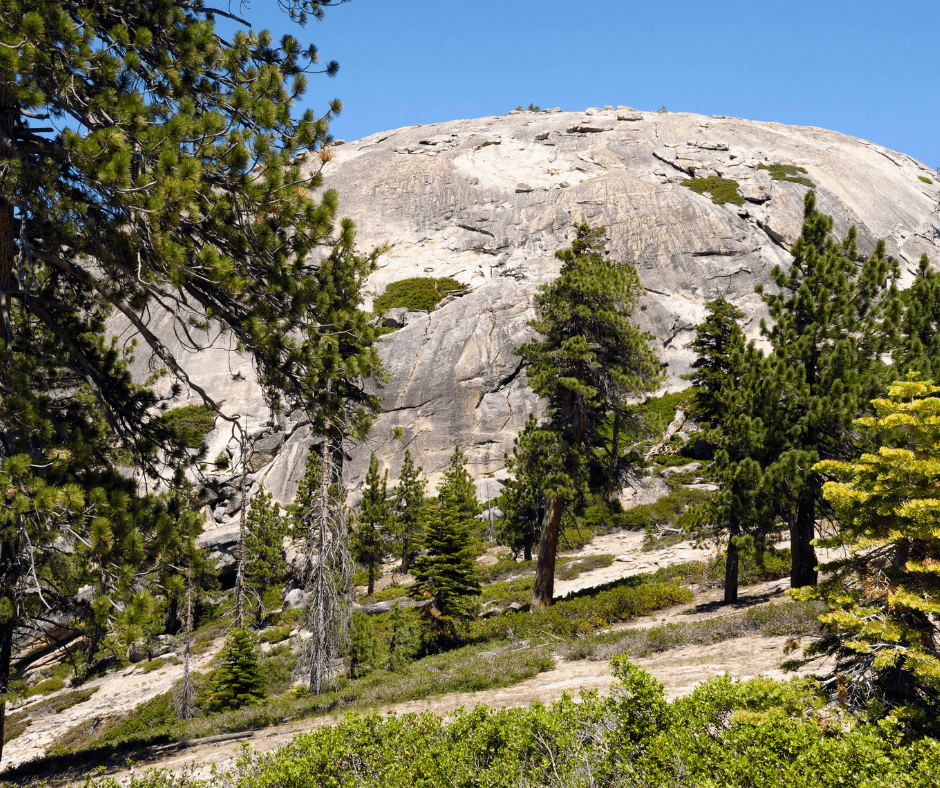
Distance: 1.8 miles round trip
Elevation Change: 400 feet
The climb to the top of Sentinel Dome gives you great views of the Yosemite Valley, Half Dome, and the High Sierras as well, but the perspective is different and crowds are far fewer.
Most of the trail is on exposed granite, which can be slippery during rain. But when its is dry, it is a breeze to walk on. Walking up the side of the dome is fun, and the 360-degree views are wonderful.
9. Taft Point
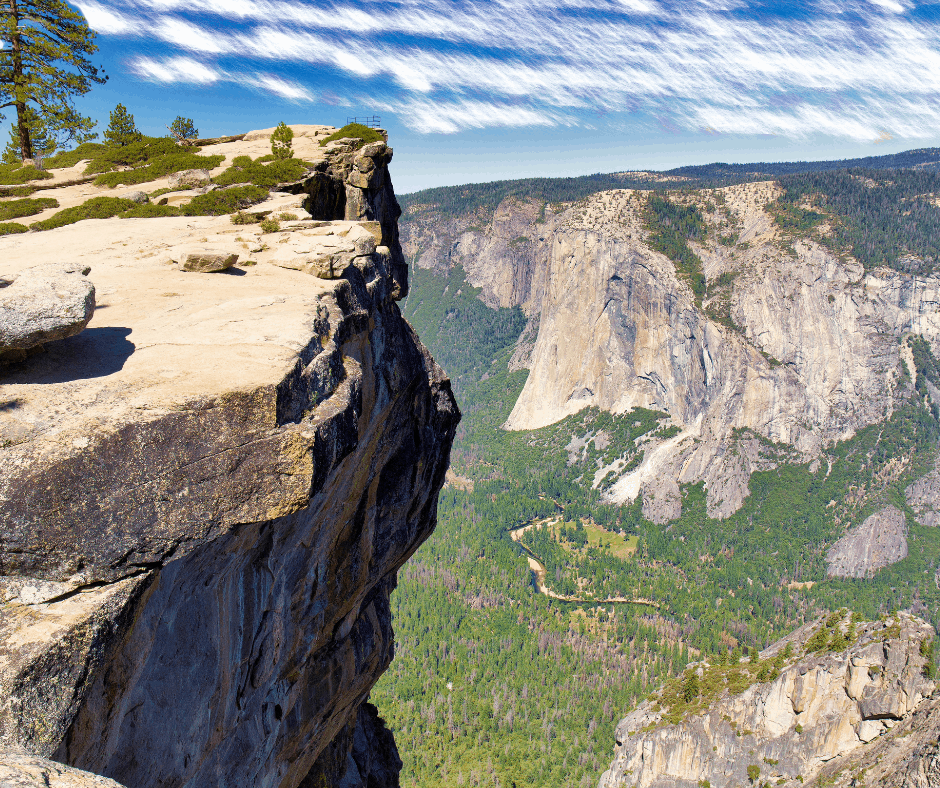
Distance: 2.2 miles round trip
Elevation Change: 200 feet
Have you ever seen photos of people standing on a granite cliff fissure with the Yosemite Valley thousands of feet below? These heart-stopping photos are taken near Taft Point.
This hike isn’t for those who are easily freaked out by people standing near cliff’s edges (like me), but you can get some pretty amazing photos if you are brave enough to walk out to cliff’s edge.
The trail meanders through a meadow as it makes it way to the Point. There is a railing at Taft Point, but not the surrounding edges. This is the place to go to enjoy views of the southern portion of Yosemite Valley, including Yosemite Falls and El Capitan.
Easy Hikes in Yosemite in Tioga Pass
The Tioga Pass area is quite different from the Yosemite Valley; this is High Sierra territory. Tioga Pass is typically open from around Memorial day until October, contingent on snowfall.
There are far fewer people in this part of the park and several lovely hikes to enjoy. Pack mosquito repellant because those buggers are vicious, especially near standing water.
10. Tuolumne Grove
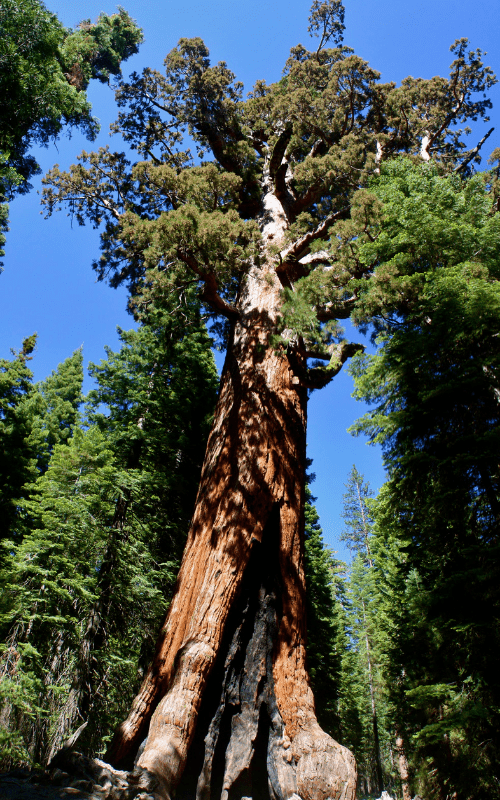
Distance: 2.5 Miles round trip
Elevation Change: 400 feet
Not long after you turn onto Tioga Road coming from the Yosemite Valley (as well as the south and west sides), you will see a pull off for the Tuolumne Grove of giant sequoias.
Unlike most hikes in Yosemite this one heads downhill first, which means the huffing and puffing are done on the return. Still, the trail is wide and smooth and not overly steep.
Standing beneath the some of the largest trees on the planet is worth a little uphill jaunt on the way back. There is a large parking lot near the trailhead.
11. Tenaya Lake
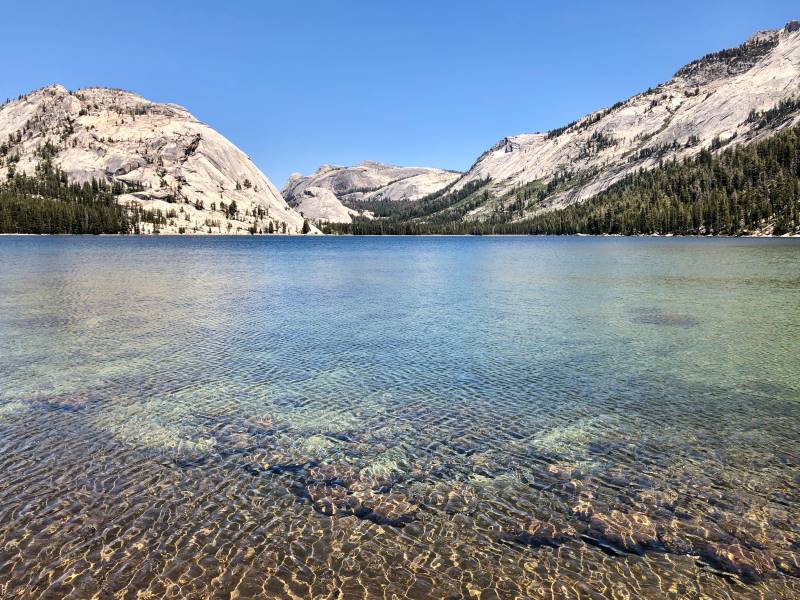
Distance: 2.5 miles for the full loop around the lake
Elevation Change: Minimal
Tenaya Lake is a lovely High Sierra lake at 8150′ in elevation. One of its shores hugs Tioga Road. There are several different places to park near the lake as well as picnic benches.
It a popular place for sunbathing and splashing in the water during the peak of the summer, but the weather is always considerably cooler than it is on the valley floor.
There is a trail that loops Tenaya Lake. The full loop is 2.5 miles but you can make this hike as long or short as you would like. The lake is the main attraction.
If you choose to do the full loop you will need to cross the lakes inlet and outlet which can be easy in the late summer but might involve getting your feet wet in the earlier part of the summer.
12. Tuolumne River Cascades via Pothole Dome
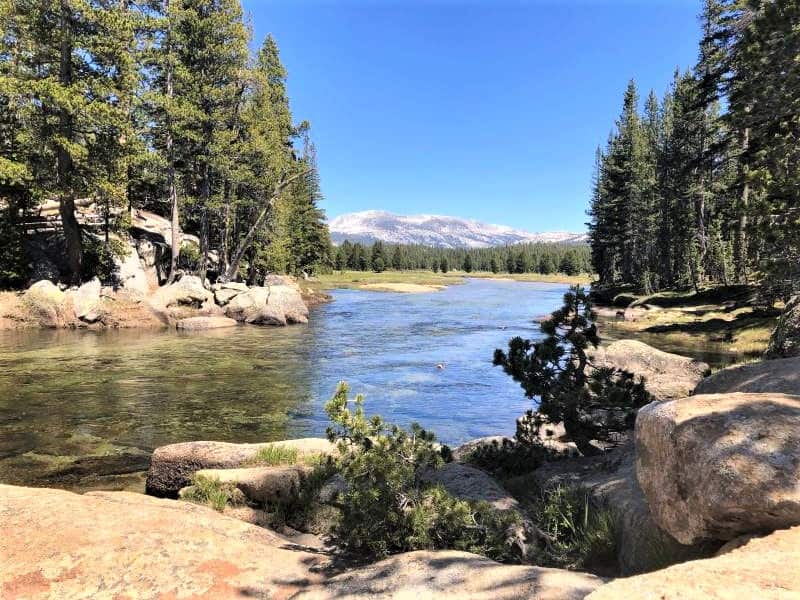
Distance: 2.4 miles round trip
Elevation Change: Minimal
I hate using the term “hidden gem” but this trail truly is. It is not a trail that is listed on brochures provided by the park and it is largely overlooked.
The trail begins at the parking area near Pothole Dome and heads along the road towards the Dome until you reach the base. Many people start climbing up the dome from there.
You can certainly climb the dome- the views are wonderful- but it is a bit steep and doesn’t really fall the “easy category”. But to enjoy this hike, keep following the trail as it goes past the granite dome and hugs the edge of Tuolumne Meadows, winding in and out of the forest.
After a little more than a mile you will reach the Tuolumne River which is picture perfect, especially during the snowmelt. You can continue to follow the creek for quite a while by scrambling on the granite that hugs the river and the occasional path.
Or you can just sit and enjoy the cascades for a while. River’s edge is an ideal place for a picnic.
13. Tuolumne Meadow to Soda Springs
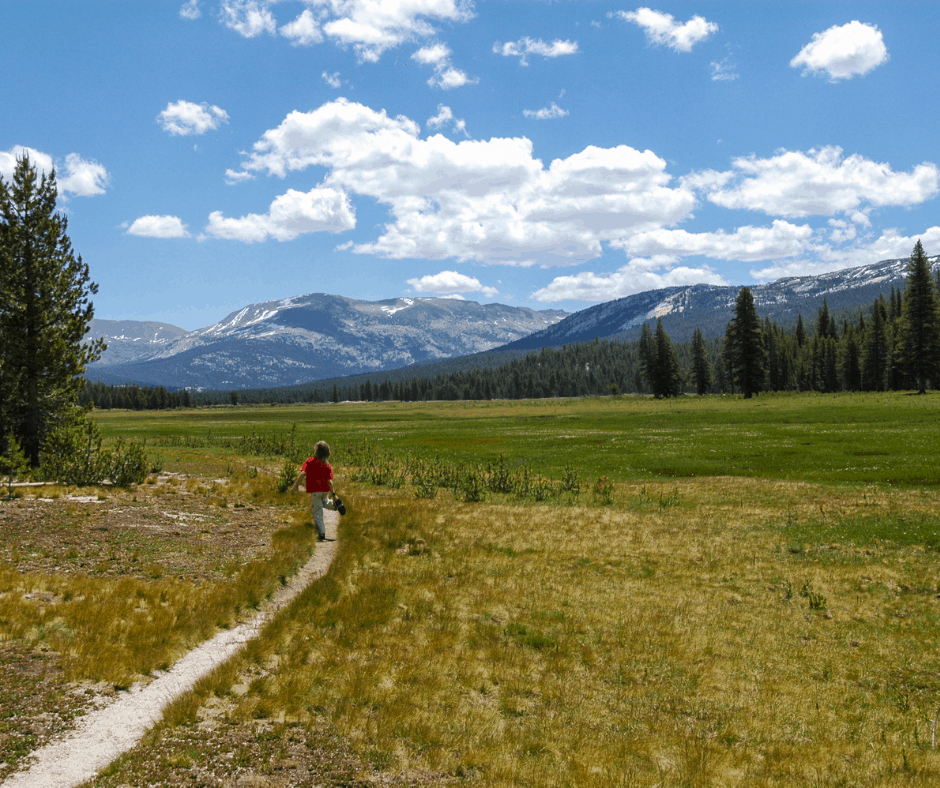
Distance: 1.6 miles round trip
Elevation Change: Minimal
Tuolumne Meadows is an exceptionally beautiful place during the early summer when this expansive meadow is a carpet of green and wildflowers.
This hike can begin at two different spots, either the parking area alongside Tioga Road in front of Tuolumne Meadow or from the parking lot near the Lembert Dome trailhead.
Both routes ultimately reach Soda Springs, a carbonated spring with a reddish tinge, and Parson’s Lodge, a 100-year-old stone building that houses some small exhibits and provides refuge from sudden storms.
Easy Hikes in South Yosemite
South Yosemite is a popular spot to enjoy sequoia trees, cabin stays, and the popular Yosemite Mountain Sugar Pine Railroad, but it also has some nice hikes.
14. Mariposa Grove

Distance: 0.3 miles on the Big Tree Loop, 2 miles on the Giant Grizzly Loop
Elevation Change: Minimal on the Big Tree Loop and 300 feet on the Giant Grizzly Loop.
The Mariposa Grove of Giant Sequoias is located just two miles from Yosemite’s southern entrance. There are about 500 sequoia trees in this grove.
If you are in a big hurry and just want to see the famed Fallen Giant, a massive sequoia that fell long ago, take the Big Tree Loop.
But to really see more of the highlights, you want to make your way to the massive Grizzly Giant tree and the California Tunnel Tree, which you can walk through.
If you take the full loop it is 2 miles. But you can shorten it by hiking out and back to the Grizzly Giant, past the Fallen Giant and California Tunnel Tree and will end up with a 1.6-mile hike.
15. Wawona Meadow Loop
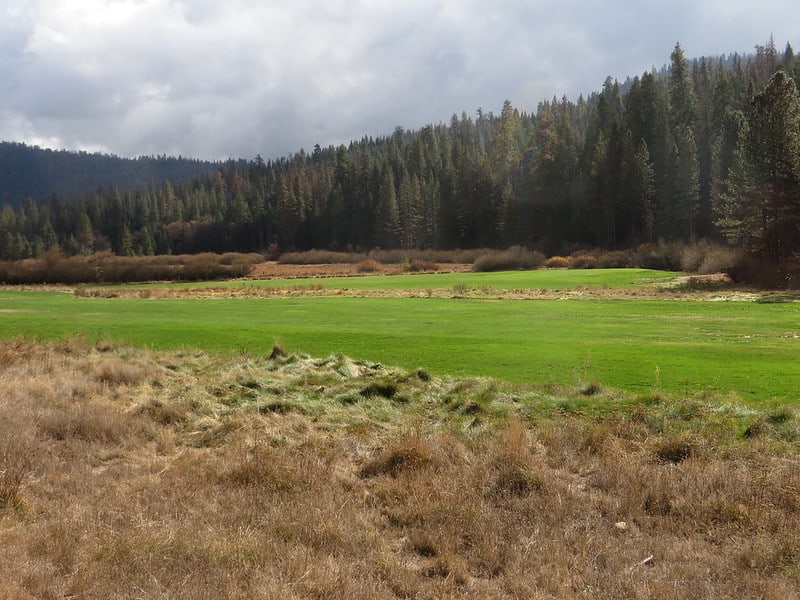
Distance: 3.5 mile loop
Elevation Change: Minimal
The Wawona Meadow Loop trail is a great place to enjoy a nature walk because there are plenty of things to discover right along the trail.
During the spring and early summer, there are wildflowers aplenty. There are also streams to explore, and animal tracks to identify.
You might even bump into a few of Wawona’s horses – they share this path with hikers during the summer.
16. First Cascades of the Chilnualna Falls Trail
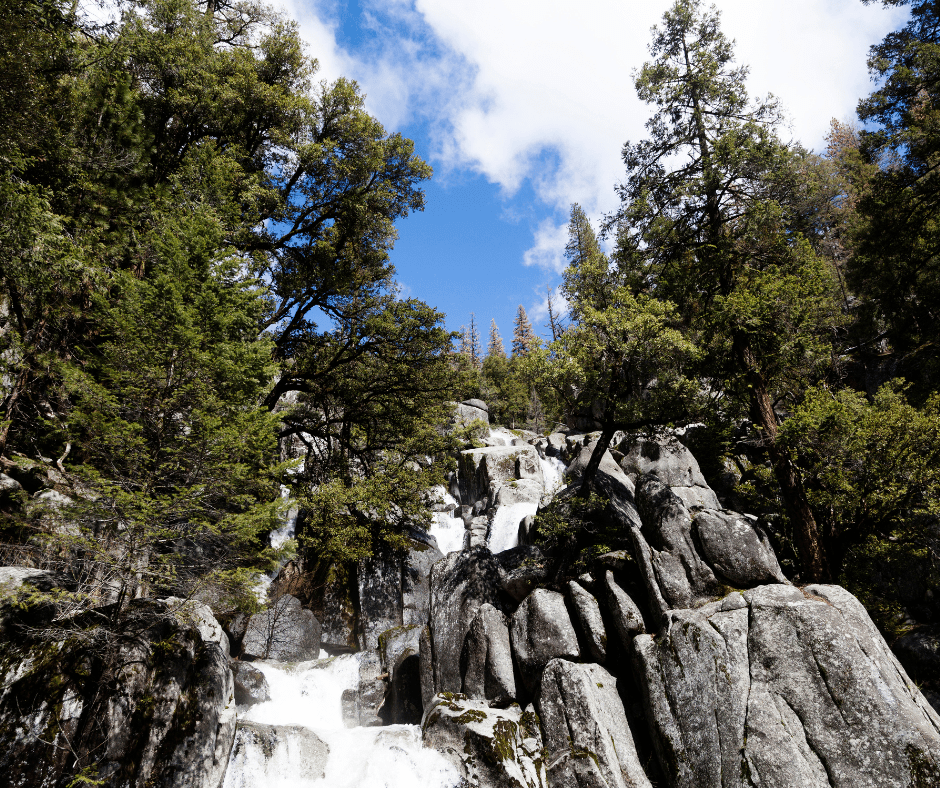
Distance: 1/2 mile round trip
Elevation Gain: About 200 feet
The full Chilnualna Falls Trail is about 8.2 miles round trip and is a wonderful day hike, but certainly doesn’t fall into the easy category.
Luckily, there is still a nice option on this trail for a short but sweet trek to some small cascades. The trail forks at the trailhead- left is for horses and right is for hikers only. Take the right for and you will come across some nice cascades.
If you want to make it into a longer hike, hike another mile and a half up the trail until it rejoins the river. This is a good spot to have lunch before heading back down the hill.
As with most falls and rivers in Yosemite, Chilnaulna runs faster and harder during the spring and early summer.
]]>From the rugged Channel Islands to the desert parks of the Mojave to the peaks of the High Sierra, here aer 12 parks that remind us why we live in the Golden State.
National Parks Near Los Angeles
Santa Monica Mountains National Recreation Area
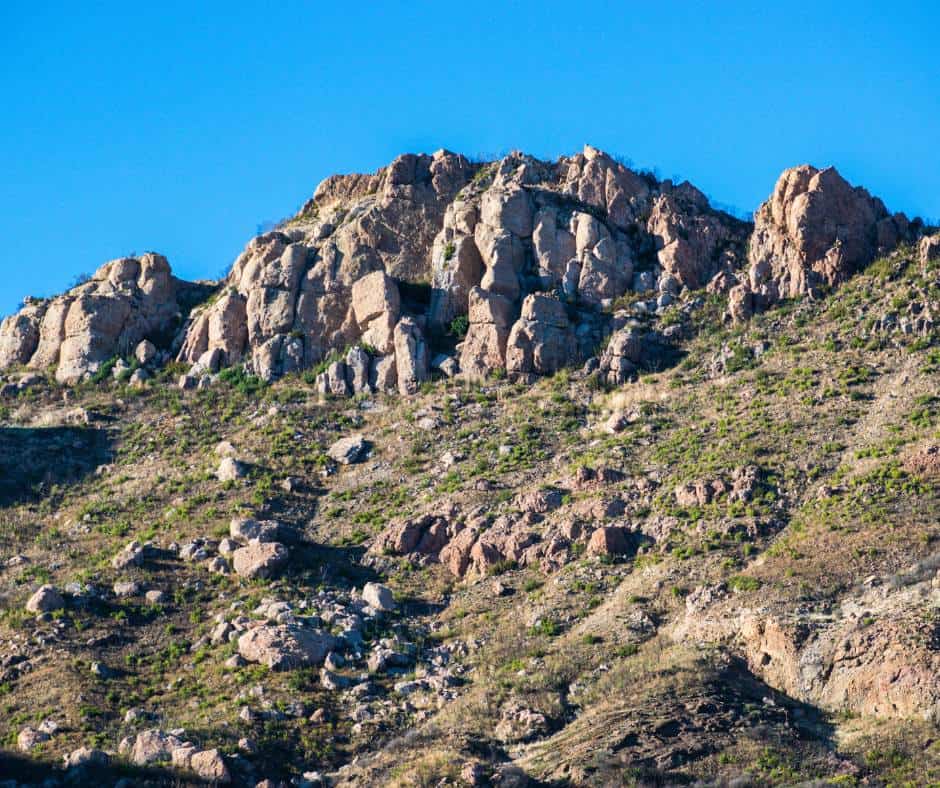
Distance from Los Angeles: Some of the park is within city limits!
The closest national park to Los Angeles is the Santa Monica Mountains National Recreation Area. This national parks covers over 150,000 acres, making it one of the largest urban parks in the world.
Unlike many national park units, it encompasses a variety of destinations like Franklin Canyon, Paramount Ranch, Solstice Canyon, and Circle X Ranch. It also works in collaboration with many of the surrounding state parks and beaches like Point Mugu State Park, Malibu Creek State Park, Will Rogers State Park and Leo Carillo State Park.
The beaches along the coastline that falls under the national recreation area near Malibu are perfect for swimming, sunbathing, and surfing. Point Mugu and Zuma Beach are two popular spots where you can catch some waves or sunnbathe, while Leo Carillo is a fun place to go tide pooling
There are over 500 miles of trails inside the Santa Monica Mountains National Recreation Area and the Backbone Trail is perhaps the most impressive of them all.
This 67-mile trail traverses the entire park and offers incredible views of the Santa Monica Mountains and the Pacific Ocean. Most people choose to pick a segment of the trail to enjoy. It is especially colorful in the spring when the hills are green and wildflowers are in bloom.
The Split Rock Trail (3.5 miles RT) and the Solstice Canyon Trail (2.1 mile RT) are two more popular trails that we recommend, especially if you want to hike with your dog. Split Rock is at the Circle X Ranch while the Solstice Canyon Trail leads hikers to a waterfall and ruins of an old cabin.
2. Channel Islands National Park
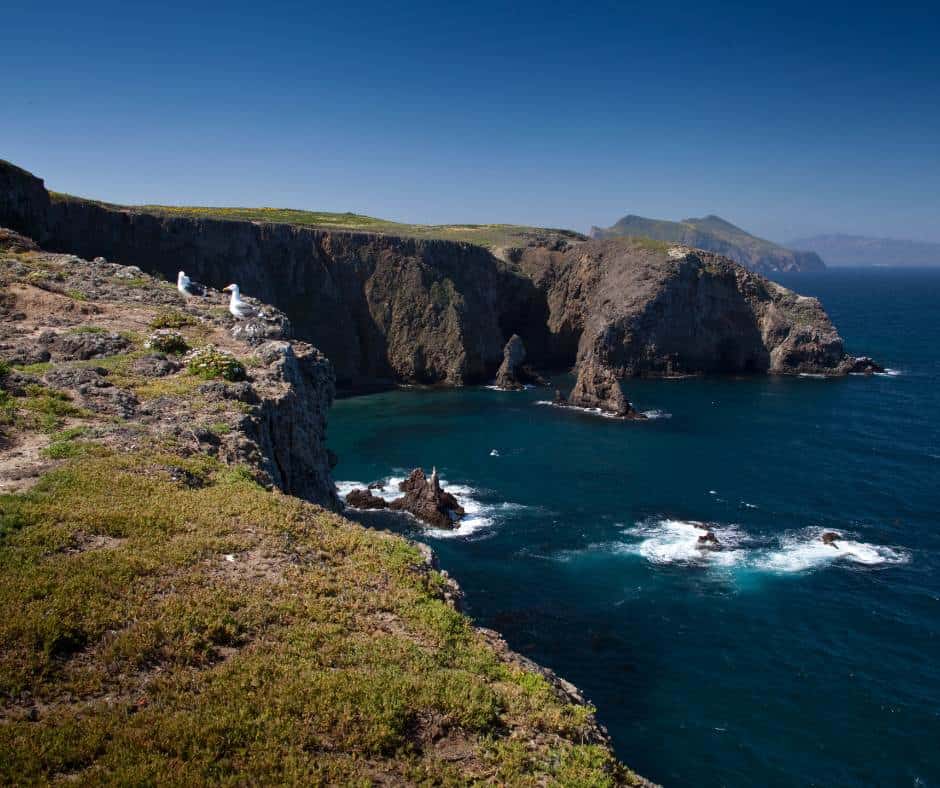
Distance from Los Angeles: 65 miles (About 90 minutes with traffic)
The Channel Islands National Park Visitor Center in Ventura is only about 90 minutes from LA, but this national park is still one of the least visited in the West. Only about 400,000 people take a boat trip out to one of the five islands that make up this special place.
Skipping this national park is a mistake, especially if you are wondering what the California coast might have been like generations ago. Of the five islands, Anacapa and Santa Cruz Islands are the most visited and can easily be done as a day trip..
In order to visit you will need to book a trip with Island Packers, the park’s authorized concessionaire. This boat ferry company has several different options, including itineraries that are suited for campers.
Sea kayaking is one of the best things to do at Channel Islands National Park. Santa Cruz Island is the most popular place for sea kayaking because of its incredible sea caves, which are some of the largest in the world. Painted Cave off Santa Cruz Island is about 1,215 feet in length and up to 160 feet in some points. Santa Barbara Adventure Company offers great sea kayaking tours.
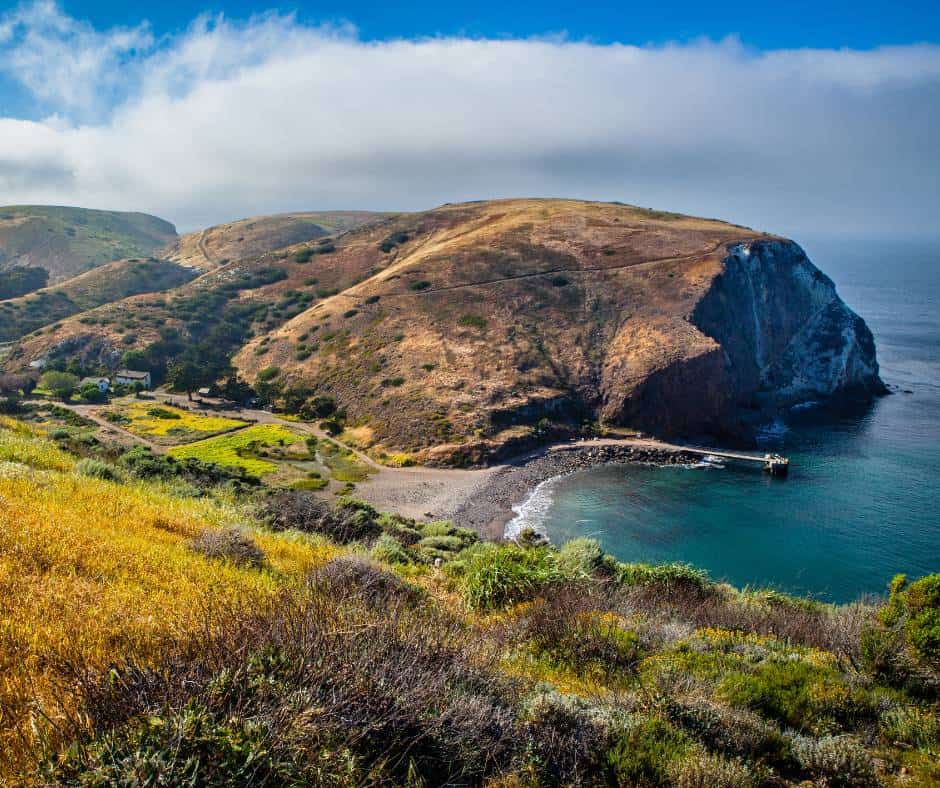
Scorpion Anchorage, on the eastern end of Santa Cruz Island, is home to a cluster of sea caves that can be explored by kayak or boat tour. These caves vary in size and shape, and some have openings large enough to allow boats to enter. The caves provide a chance to observe marine life and experience the natural wonders of the island’s coastline.
Snorkeling is another activity at Channel Islands. The water is cold, so wetsuits are highly encouraged. The kelp forests surrounding the islands are amazing and full of sea life.
The waters around Scorpion Anchorage provide excellent snorkeling opportunities. You can explore the kelp forests and rocky reefs, encountering a variety of marine life such as colorful fish, sea stars, anemones, and maybe even some playful sea lions.
Frenchy’s Cove, located near the landing area at Anacapa Island, is a popular spot for snorkelers. You can explore the kelp forests and swim alongside fish and other marine life. The nearby Arch Rock is also a beautiful area to snorkel around.
Hikers will want to visit during wildflower season in the spring. The bright yellow brilliant yellow coreopsis flowers are showstoppers. Keep your eyes out for the tiny Channel Island fox which stands at just a foot tall and weighs only 4-5lbs.
Spend the night: If you want to stay the night on one of the Channel Islands, you will have to camp and it is pack in, pack out. If you would rather spend the night close to Ventura Harbor and get an early start for a day trip, check out the Holiday Inn Express which is right on the harbor and walking distance to Island Packers.
Joshua Tree National Park

Distance from Los Angeles: 130 miles, about 2.5 hours
Joshua Tree National Park is one of the best national parks near Los Angeles to visit in the spring. After a rainy winter he desert comes to life with a riot of color, with blooming cacti, desert marigold and primrose, and mojave aster among the flowers you will encounter.
Of course, Joshua Tree is a special place to visit in the fall and winter as well (I would avoid the sweltering summers). With its towering boulder piles and iconic namesake trees, and plethora of hiking trails, it is a park you will find yourself returning to again and again.
Joshua Tree National Park is where two different deserts- the Mojave high desert and the Colorado low desert- meet, offering two distinct desert environments to explore. Most of the most iconic and popular activities are in the high desert portion of the park, like rock climbing and bouldering.
With over 800 miles of trails inside the park, visitors can choose from easy nature walks to more strenuous hikes up rocky terrain. Here are a few of our favorites:
- The trail to Barker Dam is a 1.1-mile loop trail with plenty of boulders to climb on, prehistoric rock art, and even the occassional appearance by desert bighorn sheep.
- If you want more of a challenge, hike the 1.5-mile trail to the top of Ryan Mountain. It gains 1,000 feet in elevation in that short distance, but the 360-degree views of the park from the 5,461′ summit are worth the effort.
- The Arch Rock Nature Trail is a short, easy 0.5-mile loop located near the White Tank Campground. The trail leads to a natural arch known as Arch Rock, which is formed by wind and water erosion. There is also a boulder shaped like a heart nearby.
- The Split Rock Loop Trail is a 2-mile loop that takes you through a diverse desert landscape. It winds through unique rock formations and offers an up-close look at Joshua trees, ocotillos, and other desert flora.
More attractions inside Joshua Tree that you won’t want to miss include Skull Rock, taking the ranger-guided Keys Ranch tour, bouldering in Hidden Valley, and the sprawling vistas at Keys View.
Check out our epic Joshua Tree National Park day trip itinerary.
Spend the night: All accommodations inside the national park are campgrounds. If you prefer four walls, you can choose to stay at one of the many hotels and resorts in the Palm Springs area or go my preferred route and book a funky home in Joshua Tree via VRBO. There are some really cool options!
Cabrillo National Monument
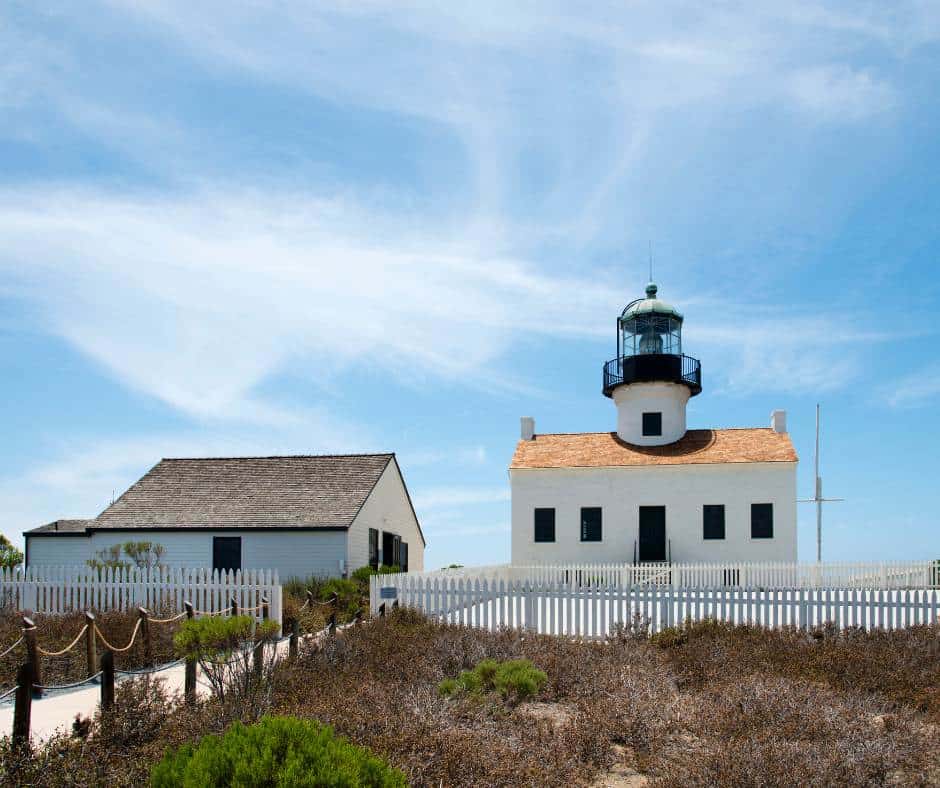
Distance from Los Angeles: 125 miles, about 2.5 hours
Located in San Diego on the southern tip of the Point Loma Peninsula is Cabrillo National Monument, a place to experience the natural beauty and history of the region.
This historic site commemorates the arrival of Juan Rodriguez Cabrillo, the first European to set foot on the West Coast of the United States in 1542. There is a statue as well as a museum with exhibits explaining the history of the region, including the Kumeyaay people who have lived in the area for thousands of years. But wait, there’s more!
The monument is also home to Old Point Loma Lighthouse, one of the eight original lighthouses built on the West Coast. It operated from from 1855 to 1891 helping ships enter the San Diego Bay.
There are also some natural attractions to enjoy at this park. Tidepooling is very popular at low tide, and visitors can see a wide variety of sea life, including anemones, crabs, and starfish. Gray whales can also be spotted just off Point Loma from December through March during the migration to and from their birthing grounds off the coast of Mexico.
There are also several hiking trails that lead visitors through the park’s diverse landscape. The Bayside Trail is a great option if you are looking for sweeping views of the bay and downtown San Diego. It is an easy, 2.5-mile trail and there are several interpretive panels that provide information about the local history, marine life, and the unique ecosystems of the area.
Spend the night: There are so many great lodging options in San Diego. I love the location and suite-style rooms at the Embassy Suites in downtown San Diego. If you are looking for a more resort-style stay, check out Paradise Point Resort on Mission Bay.
Carrizo Plain National Monument
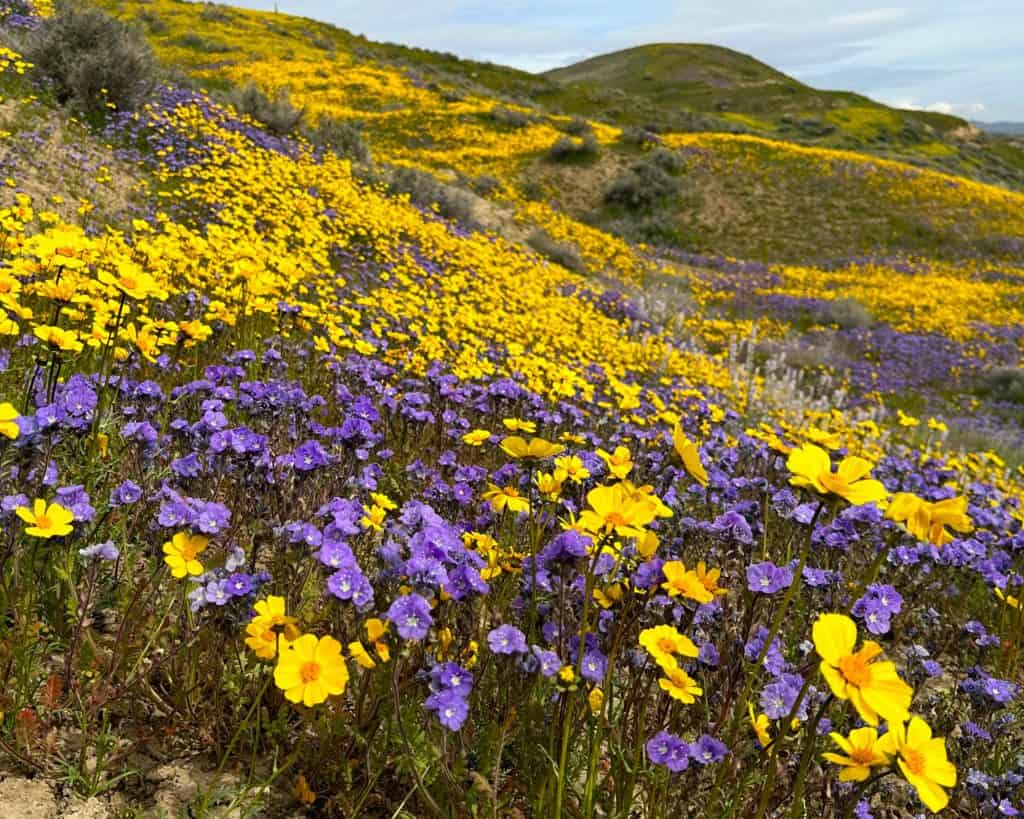
Distance from Los Angeles: 150 miles, three hours
After all the rain we received this past winter, I knew it was time to make the journey out to Carrizo Plain National Monument, known for its incredible wildflower displays. The park is quite remote, but getting there was easy. It is just over the Grapevine from LA metro.
The park is located in the rolling hills that separate the Central Valley from the coast and protects the largest native grassland left in the state of California. The main road through the park is partially paved, but we had zero issues navigating the dirt portion of the road in our Tesla.
The wildflowers here definitely live up to the hype and I was impressed by the sheer diversity of flower types. Color tends to peak in late March through April and include yellow daisies, owl’s clover, goldfields, coreopsis, baby blue eyes, tidy tips, poppies, and phacelia.
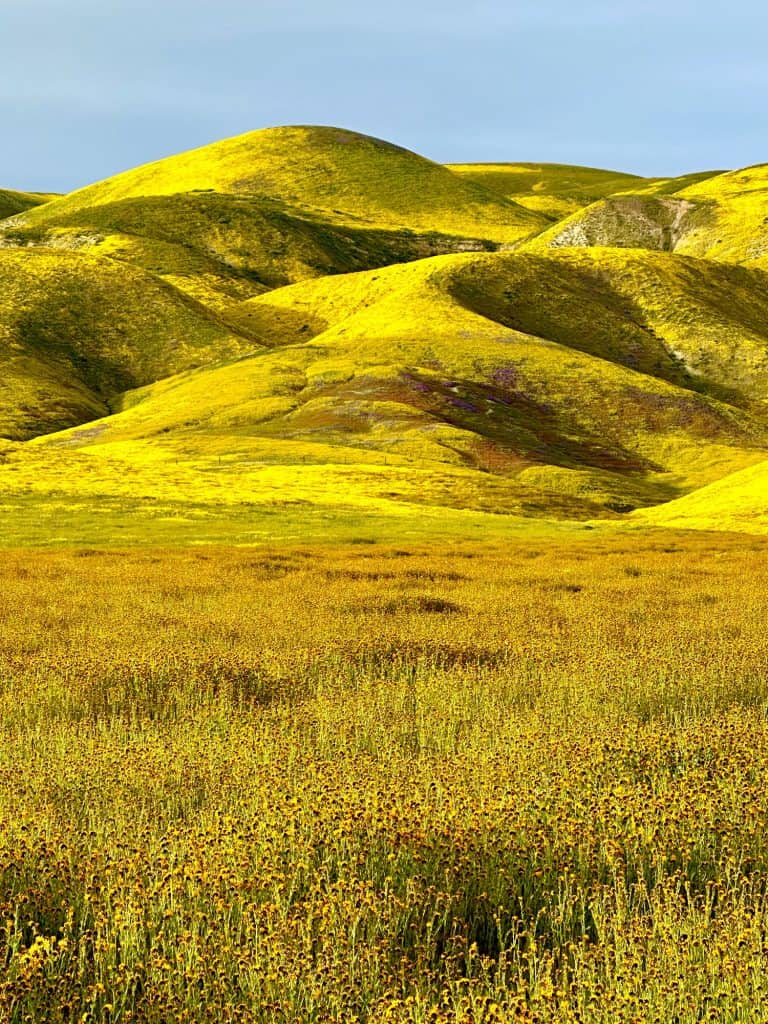
If you have a four-wheel drive vehicle you will want to definitely take some of the other dirt roads throughout the park including Caliente Ridge, Shell Creek Road, and Seven Mile Road to see even more blooms.
While most people who visit the park tend to do more driving tours than hiking, there are some great trails to enjoy. The Caliente Ridge Trail provides stunning views of the surrounding hills and valleys rom above. If you want to walk on the famed San Andreas Fault, take the 1.3-mile Wallace Creek Trail.
Take time to visit Soda Lake, which reflects the wildflowers on its waters. You can also visit Painted Rock, an ancient Native American site with pictographs and petroglyphs. Visitors can take a guided tour of the site to learn more about its history and cultural significance.
Carrizo Plain National Monument is one of the few places in Califoria where you have a chance of spotting pronghorn antelope. They were once the most common big game animal in California’s Central Valley, but overhunting during the Gold Rush era and agricultural development drastically reduced their range and numbers. There are also elk inside the park.
Spend the night: If you want to stay inside the park, you need to camp and there are very limited services. We chose to spend the night at the Best Western Plus in Taft, a small oil town that offers some of the closest lodging to the park. Rooms were clean and breakfast was included.
Mojave National Preserve
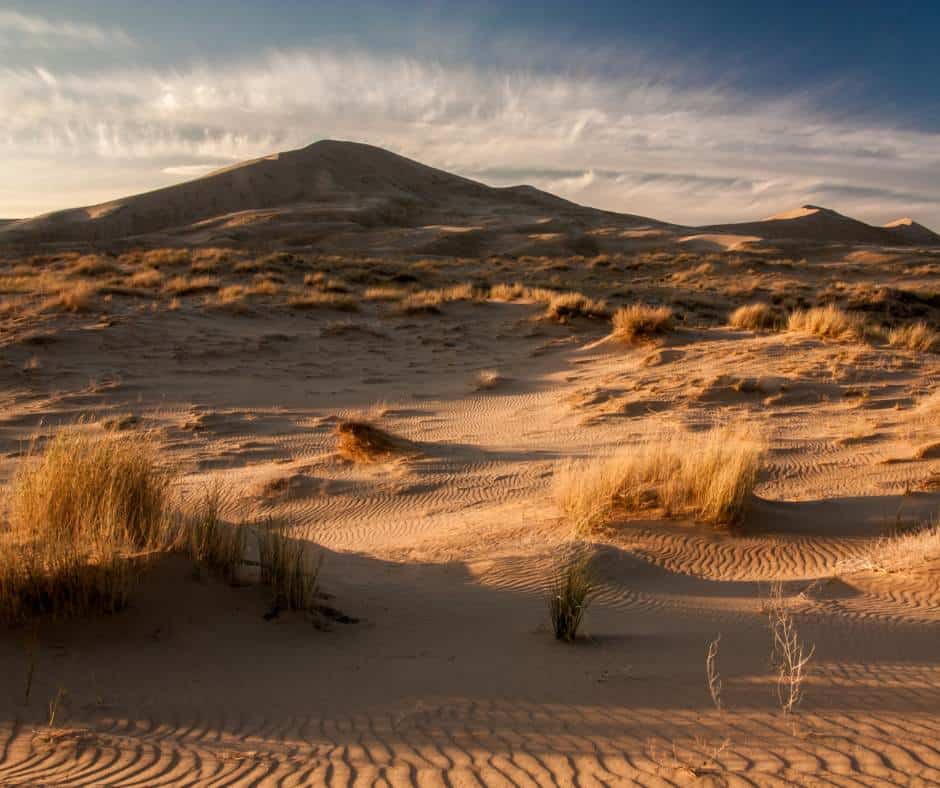
Distance from Los Angeles: 194 miles, about three hours
Mojave National Preserve protects over a million acres of the Mojave Desert in between Interstate 15 and Interstate 40, close to the California/Arizona border.
The park is home to Kelso Dunes, some of the largest sand dunes in the country. These massive dunes rise 600 feet above the desert floor. There is a three-mile trail around the dunes, but we think it is far more fun to just climb, slide, snowboard, or even roll down the dunes.
You can also make the dunes “sing”. They make a deep sound when a large amount of sand is pushed off the top of the dunes in hot weather. This is best accomplished with a group in synch with one another.
Another great spot to visit inside the preserve is Mitchell Caverns. The park service offer guided tours of an underground cave system. Visitors can explore the unique rock formations and learn about the geological history of the area.
Here are 25 awesome caves in California to explore.
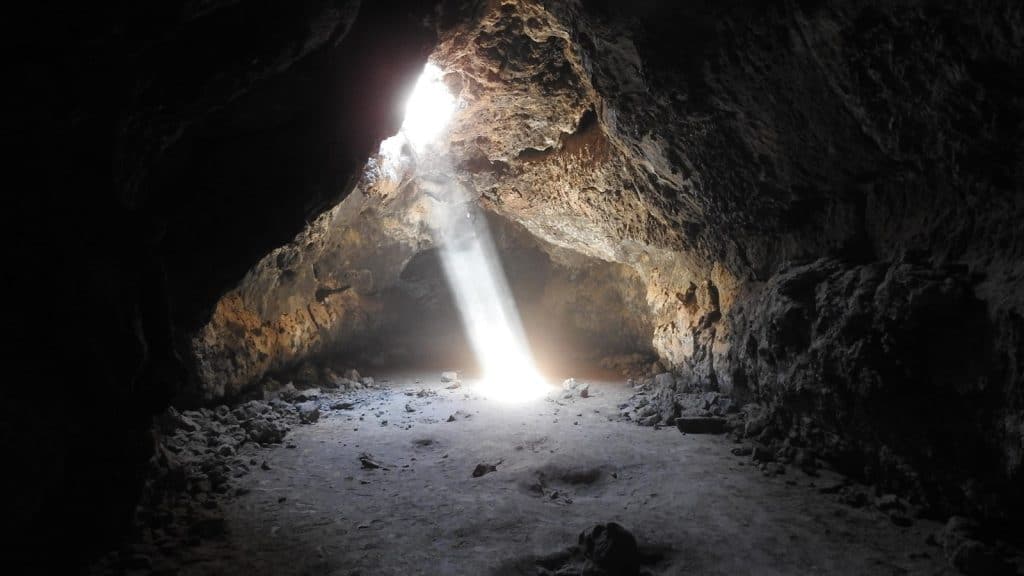
You will also want to check the park’s lava tube. It was created by molten lava 27,000 years ago. There is a beam of light that shines into the lava tube at certain times of day (usually early afternoon in the summer), begging to be photographed.
If you are a hiker who enjoys a bit of adventure, check out the the 1.5-mile Hole-in-the-Wall Rings Trail where you can use the rock-mounted ringbolts to climb into the rocky amphitheater at the bottom of Banshee Canyon.
As you can imagine, Mojave National Preserve can get very hot in the summer, so winter and shoulder season visits are the most enjoyable.
Castle Mountains National Monument
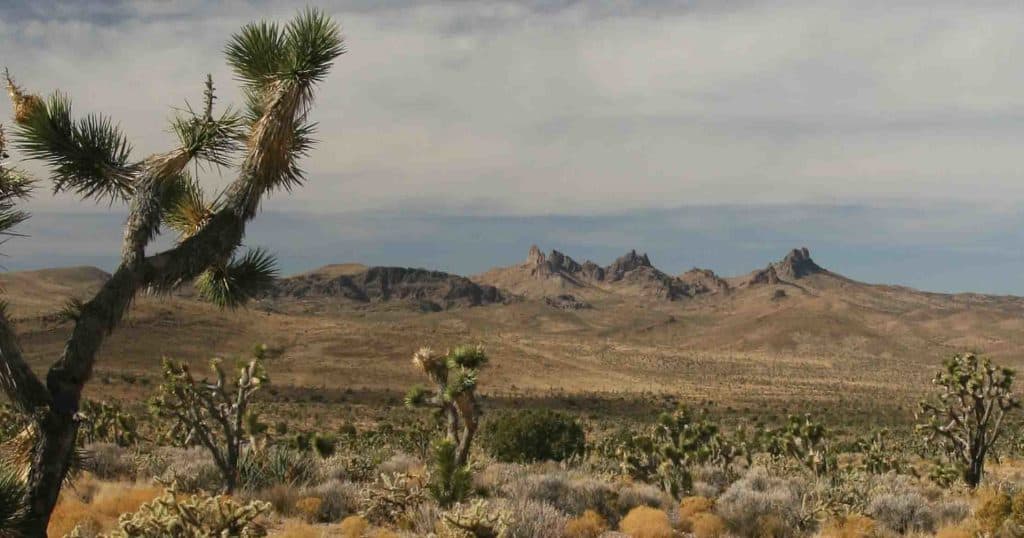
Distance from Los Angeles: 250 miles, about 4.5 hours
Castle Mountains National Monument is likely a national park you haven’t about yet. It established in 2016, is located two hours east of Barstow. It protects 21,000 acres of desert northwest of the Colorado River in between Interstates 15 and 40; basically the small section of desert that Mojave National Preserve didn’t previously protect.
The park is home to Joshua trees, rare desert grasslands, seasonal desert wildflowers, and even pinyon-juniper forest at the highest elevations. It also protects the habitat for a variety of wildife including for desert bighorn sheep, mountain lions, bobcats, golden eagles, gila monsters, and desert tortoise.
This park is only accessible by dirt roads, so a four-wheel-drive, high clearance vehicle is recommended. There are no maintained trails and you are welcome to hike where you want. There are abandoned mines and ghost towns to explore like the Hart Mine, the Oro Belle Mine, and the restored Hart Homestead, which provides a glimpse into life in the desert in the early 1900s.
Another one of the highlights of the monument is the Castle Mountains themselves, which offer stunning views of the surrounding desert landscape. The Castle Mountains are a popular destination for hikers and provide a challenging but rewarding hike to the summit.
Here is a good article on visiting this remote national monument.
Spend the night: This national monument is close to Lake Havasu so staying in Bullhead CIty is your best bet.
Death Valley National Park
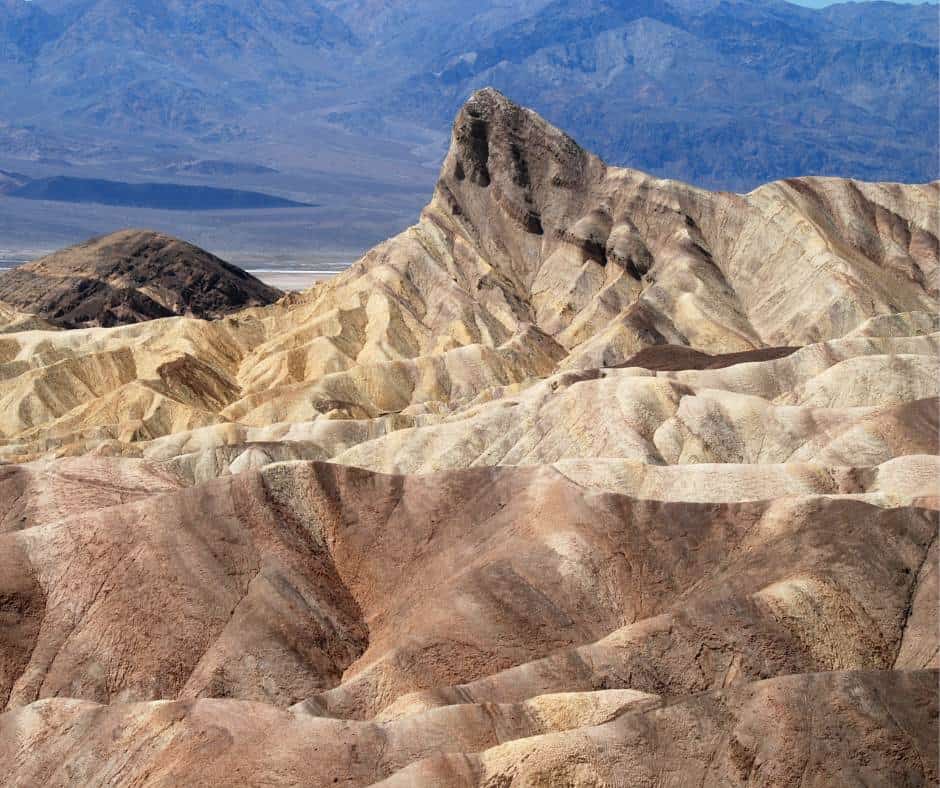
Distance from Los Angeles: 250 miles, about 4.5 hours
You have likely driven past the exit to Death Valley several times on your trek towards Vegas on Interstate 15, but have you ever actually taken the time to visit? If you haven’t, you should! Don’t get turned off by the word “death” in the name. Or the news reports of 120+ degree temps during heat waves in July. This place is special!
Death Valley National Park is 3,422,024 acres in size, making it the largest national park outside of Alaska. And while Death Valley is well known for its fiery summer temperatures which can exceed 130 degrees during a heat wave, it is a delightful and scenic place to visit during the winter, late fall, and early spring when the weather is mild.
This is a park of stark contrast. Badwater Basin, the lowest spot in North America at -282 feet, is impressively offset by Telescope Peak looming 11,331 feet above just 15 miles away.
It is home to rare fish that can survive swimming in a spring-fed creek that warms up to 90 degrees in the summer, sand dunes that will knock your socks off, dark skies where you can see the Milky Wave, and lots of great canyons to explore.
And despite the ominous name, there is actually lots of wildlife in this park. Here are 24 animals in Death Valley that you may encounter on your visit.
Unlike most national parks, you aren’t required to stay on marked trails while you explore. As a matter of fact, many places don’t have trails at all! We love to explore Golden Canyon, Sidewinder Canyon, and Mosaic Canyon. Other park destinations you don’t want to miss include Zabriski Point, Artist’s Drive, and the Devil’s Golf Course.
Spend the night: Death Valley is huge so staying inside the park will help you spend a couple days exploring. The Ranch at Death Valley is a great place for families with activities like shuffleboard, swimming, and horseback rides, on site. The Furnace Creek visitor center is just steps away. The Inn at Death Valley is a more upscale option that will appeal to couples and golfers.
Sequoia National Park
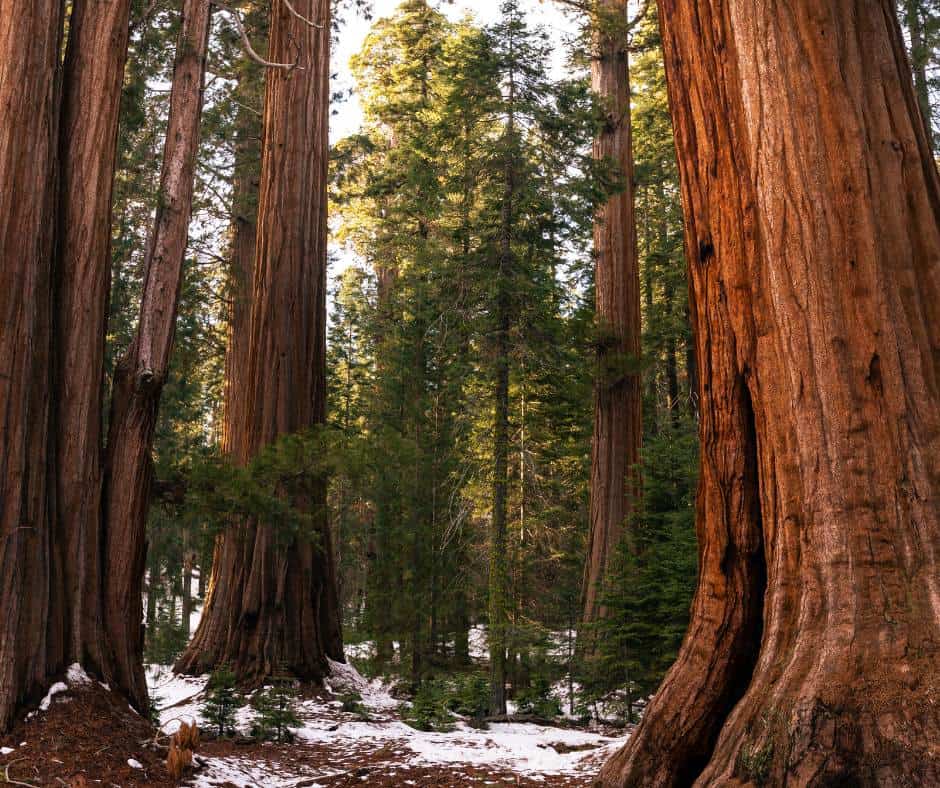
Distance from Los Angeles: 225 miles, about 4.5 hours
In my opinion, Sequoia National Park is a little underrated. It sits in the shadow of Yosemite which is just down the road, but I prefer a visit to Sequoia in the summer over Yosemite because it is far less crowded and still has plenty of incredible scenery to offer beyond its namesake trees (which are reason enough to visit).
One of the main attractions in Sequoia National Park is the General Sherman Tree, the largest known living single-stem tree on earth. Visitors can hike through the Giant Forest, which has more than 8,000 sequoia trees. The further you hike away from General Sherman, the fewer people you will encounter.
If you haven’t stood at the base of a sequoia tree, make it a priority. Pictures just can’t do these behemoths justice. The trees are simply magical, and feel like they are the brainchild of a fantasy writer. They are unlike anything else in nature.
Beyond the impressive trees, this park is filled with great hiking and plenty of epic Sierra Nevada scenery. Don’t miss the trail to Tokopah Falls which follows the refreshingly cold Marble Fork of the Kaweah River. The trailhead starts at the Lodgepole Campground and we have seen black bears either in the campground or on the trail on every visit.
Another popular attraction is Moro Rock, a granite dome that offers sweeping views of the surrounding landscape, including the Great Western Divide. If you are a backpacker, head to Mineral King and enjoy some of the most magical trails in the High Sierra.
Sequoia National Park is also home to Crystal Cave, which is open for cave tours seasonally. The tours are popular, and it is recommended that you purchase tickets two months in advance of your visit. It is a 1/2-mile walk down the hill to the Crystal Cave entrance. Be sure to bring a sweatshirt because it is a constant 50 degrees inside the cave.
Important Note: Sequoia National Park was heavily impacted by the extreme winter weather this year combined with the massive fire that hit the area in 2021. Crystal Cave for the 2023 season due to damage to the road and trails but is expected to open in 2024. The Mineral King area is also closed in 2023 due to road damge.
Spend the night: I really enjoyed our stay at the centrally located Wuksachi Lodge inside the park. Camping at Lodgepole Campground is a geat option as well.
Kings Canyon National Park
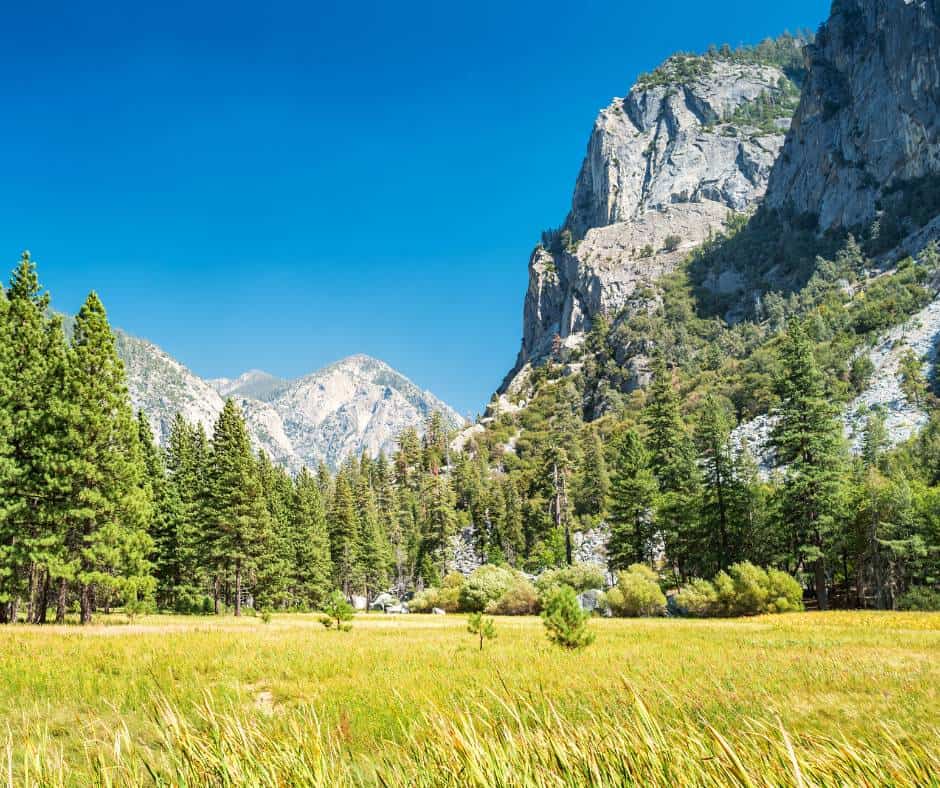
Distance from Los Angeles: 250 miles, 4.5-5 hours
The sister park to Sequoia is King Canyon, a national park that in many ways, feels like two distinct parks. It is home to Grant Grove, an impressive Sequoia Grove that is home to the General Grant tree, the second largest sequoia in the world. This grove also houses the Fallen Monarch, a fallen sequoia that is cool to walk through and explore.
This portion of park is at 6,500 feet in elevation and heavily forested. The other portion of the park is Kings Canyon itself, which accessed via a winding mountain road that ends in a valley that gives Yosemite Valley a run for its money.
Be sure to make a stop at Boyden Cave on your way to or from the valley. This marble cave is located deep in Kings Canyon and is open for tours.
Kings Canyon’s Cedar Grove (4,600′) is certainly less crowded than Yosemite, and has beautiful granite peaks and sprawling meadows to enjoy. We especially love hiking the Zumwalt Meadow loop, stopping to see Sheep’s Creek Cascade, and playing in the Kings River on warm summer days.
Horseback riding is a fun way to enjoy Kings Canyon as well. Trail rides along the Kings River are offered at the Cedar Grove Pack Station.
Spend the night: If you are wanting to stay up near Grant Grove, John Muir Lodge is a good motel option. We have also stayed in the Grant Grove camp cabins which are super basic and essentially camping with four walls. Down in Cedar Grove, the only lodging is the super basic Cedar Grove Lodge or a few different campgrounds.
Pinnacles National Park
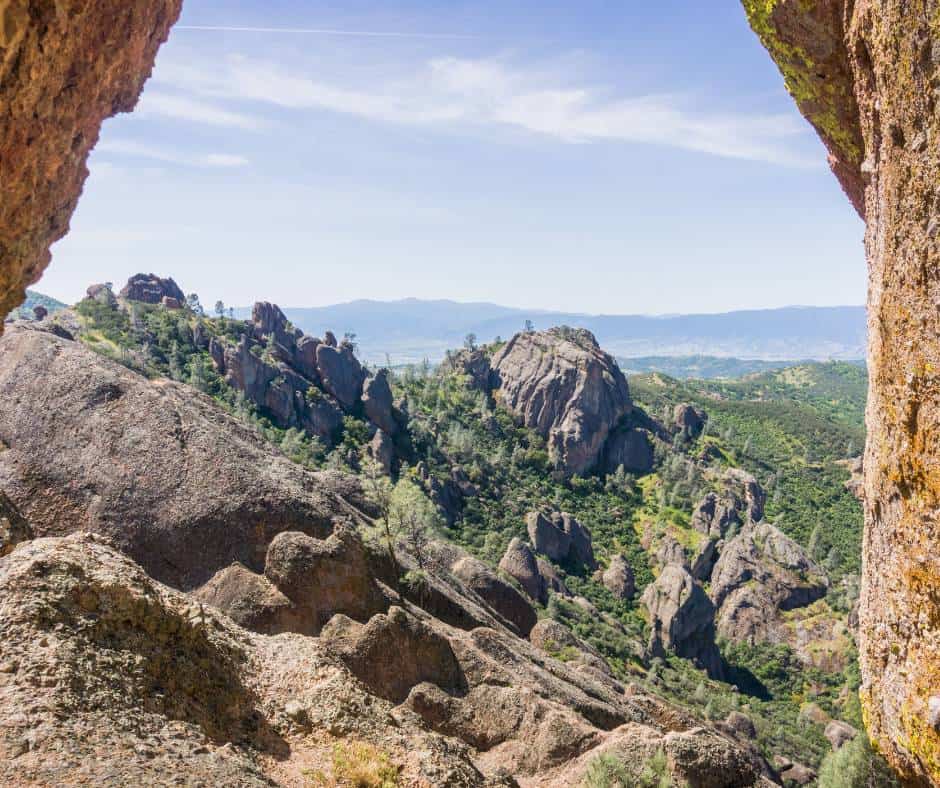
Distance from Los Angeles: 270 miles, about 5 hours
Pinnacles National Park is the newest national park in California, and while it doesn’t have the some wow factor that the Sierra parks have, it is still definitely worth a visit
Pinnacles is great thanks to its known for its four “C’s” – caves,climbing, camping, and condors.
There are two sides of the park, the west and east entrance, and there is no road that goes through the park connecting the two. If you want to explore both sides of the park on the same visit, you will have to go back to Hwy 101 and go around.
On the east side of the park, the Bear Gulch area is home to large talus caves that are formed by massive boulders. These caves are really fun to explore- bring a flashlight or head lamp- and will lead you up to Bear Gulch Reservoir. They are closed seasonally when bats are roosting, so check the park website before heading out becase they are definitely a park highlight.
If you are on the west side of the park, which is closer to the Bay Area, the 2.4-mile Balconies Cave loop is another cool talus cave to explore. As with the Bear Gulch Cave, flashlights or headlamps are necessary.
The High Peaks Trail is the premier hiking trail inside the park. It is a challenging 5.5-mile loop trail that takes you through the dramatic rock formations and rugged peaks of the eastern section of the park. Parts of the trail require the use of handrails or staircases carved into the rock.
As you hike the hills of Pinnacles, keep your eyes out for the rare California condor. There are only about 300 of these birds living in the wild so spotting one of these massive raptors is quite a treat. Some climbing and hiking routes can be closed during their nesting season.
Spend the night: The only lodging inside of Pinnacles is a campground that has tent sites, RV sites, and tent cabins.
Yosemite National Park
Distance from Los Angeles: 280 miles, about 5 hours to southern entrance
Yosemite National Park is the most popular park in California for good reason- it is truly one of the most places on the planet. Yosemite Valley is home to towering waterfalls, remarkable granite features like Half Dome and El Capitan, abundant wildlife, and pristine meadows.
Read about all the animals in Yosemite you might encounter.
Still, the Yosemite Valley can become a bit of a circus during the height of the summer. There are just too many people for my taste. I prefer to visit this portion of the park in the spring or fall.
If you do visit in the summer, you will find fewer people when you hikea couple miles or visit some of the other portions of the park.
Yosemite is home to three Sequoia groves and plenty of high Sierra backcountry to explore. You will definitely want to make time to explore Tioga Pass which has some great trails and cooler weather. Hetch Hetchy is another less-visited-but-still-worthy spot where you can hike near a reservoir to a waterfall.
Given the size and scope of Yosemite, I suggest that you plan on spend at least two to three full days exploring the park. But, I also know that sometimes schedules won’t allow for that which is why I put together this Yosemite in One Day itinerary if you are short on time.
There are so many great day hikes in Yosemite National Park that you won’t want to miss. They include trails to gushing waterfalls, verdant green meadows, and crystal clear waterways. Here are the 16 best easy hikes in Yosemite National Park.
]]>Here are 25 animals you may encounter while in Death Valley National Park. Some of these animals are more elusive than others, but all of them call this desert park home. This is not an exhaustive list of animals that are seen in the park. There are several more rodents, birds, reptiles, and insects that call it home as well.
25 Animals in Death Valley
Coyote
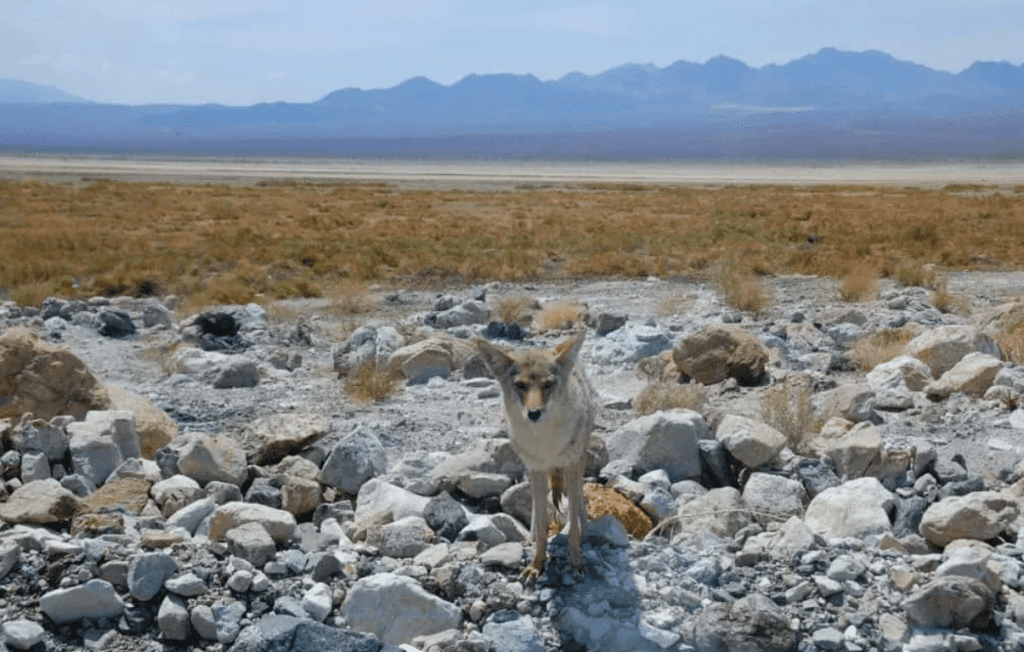
Coyotes are a common sight in Death Valley National Park which is no surprise since they are one of the most adaptable and widespread mammals in North America. Coyotes can be found all throughout the park and are highly intelligent and resourceful.
are opportunistic feeders which means they will eat just about anything incluing small mammals, insects, prickly pear fruit, carrion and whatever humans leave behind at picnic spots and campsites.
The coyote in the photo above actually ran alongside our car while we were driving on Badwater Road. It was clear that it had previous success with roadside begging because it was completely unafraid of our vehicle.
Feeding coyotes is dangerous for many reasons. 1. The park’s coyotes can become dependent on humans for food. 2. It can lead to human/animal encounters that lead to human injury from an overly aggressive or hungry wild animal 3. The practice of running up to cars will surely lead to more coyotes being hit and killed by vehicles inside the park.
Coyotes are most active during the early morning and late evening hours, and are often heard howling at night, but as you can see from the photo above, they have no qualms about showing their faces in braod daylight if the possibility of food is involved.
Like birds of prey? Here are all the different hawks in Southern California.
Desert Tortoise
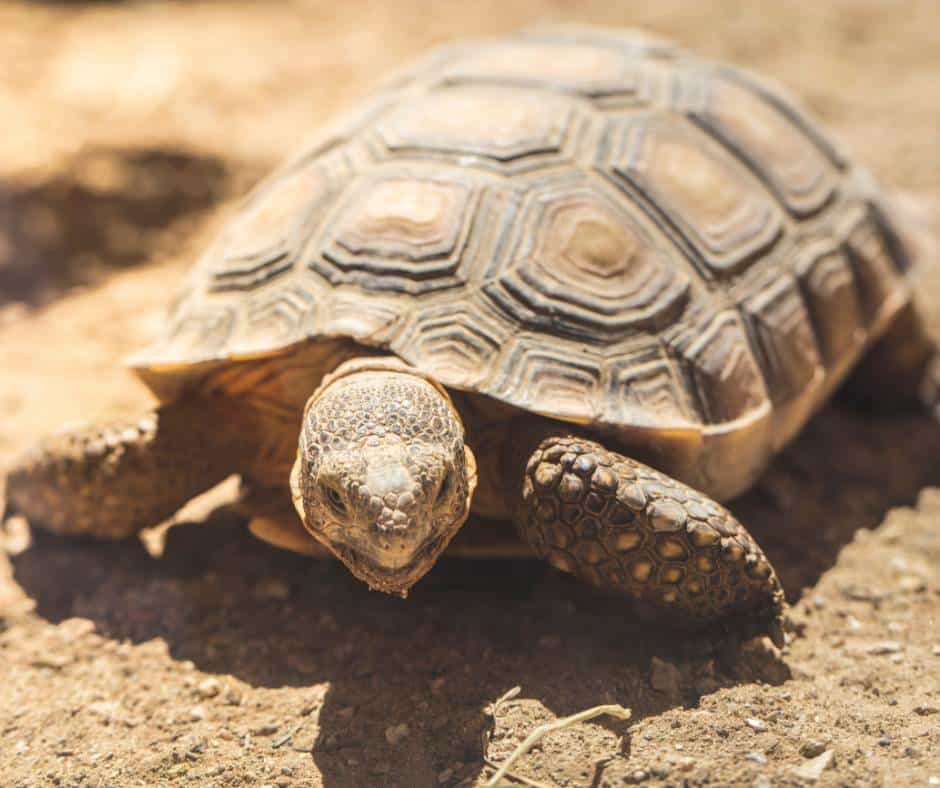
The desert tortoise is a species of turtle that is native to the Mojave and Sonoran deserts of North America, including Death Valley National Park. These tortoises are known for their long lifespan, and many live to be up to 100 years old!
Desert tortoises are listed as a “threatened species” under the Endangered Species Act, and populations in Death Valley National Park have been impacted by habitat loss, disease, and human disturbance. To help protect the desert tortoise and its habitat, the National Park Service has implemented a number of measures, including monitoring populations, enforcing strict regulations on human activity in tortoise habitat areas, and working to control the spread of diseases that can impact the tortoises.
The desert tortoise spends most of their lives in burrows and are completely inactive from November through February. For the rest of the year they do come out for a short period each day to eat, avoiding excessive highs and lows in temperature since they are unable to regular their body temperature on their own.
They are especially active on warm, overcast days. If it rains, the tortoises will also come out to drink water that has gathered in small pools. The desert can go through extended periods of drought, and theses reptiles have developed an adaptation that allows them to store water in their bladders.
Since desert tortoises are soil-colored and rather small (2-15 inches in length), they can be quite hard to spot. They can be found in rocky areas, canyons, and washes where they seek out shelter from the hot sun and access to water sources. They are primarily herbivores, feeding on a variety of plants, including grasses, cacti, and wildflowers.
Visitors to Death Valley National Park may be able to see desert tortoises in the wild, but it’s important to remember that they are a protected species and it is illegal to touch or disturb them. Some of the most common places to see desert tortoises in Death Valley National Park include:
- Mesquite Flat Sand Dunes where tortoises often seek shelter under the brush and cacti that grow in and around the dunes.
- Scotty’s Castle: the historic site located in the northern part of the park is a popular spot for visitors to see tortoises crossing the road or basking in the sun on nearby rocks.
- Titus Canyon: Visitors may spot tortoises near the creek bed or along the canyon walls.
- Wildrose Canyon: This remote canyon is home to a small population of desert tortoises which live in the rocky terrain and among the desert vegetation.
Desert Bighorn Sheep
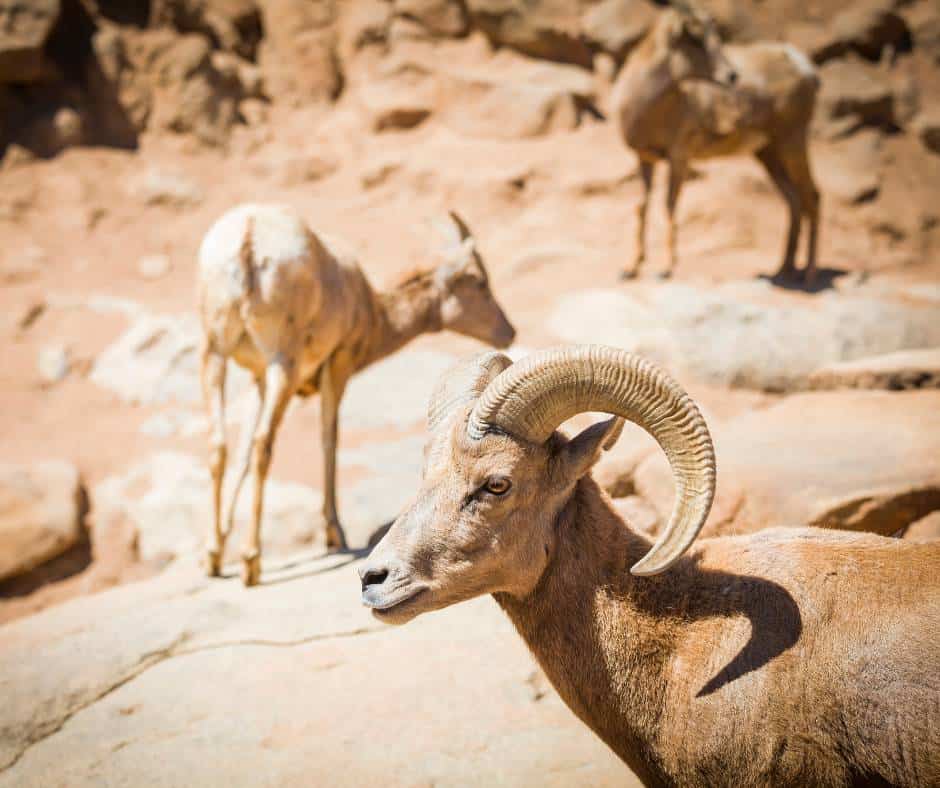
Desert bighorn sheep are one of the most iconic animals that call Death Valley National Park home. These magnificent animals are well adapted to the harsh desert environment and are known for their impressive climbing abilities and keen senses.
Bighorn sheep are most often found in the mountains and canyons throughout the park, where they seek out areas with rocky terrain and water sources. It is especially important for them to drink water during the brutal summers, and these sheep are known to drink gallons at a time before leaving a water source.
They are primarily herbivores, feeding on a variety of plants, including cactus, shrubs, and grasses. Their complex digestive system allows them to eat plants like mesquite which many other herbivores mightnot be able to digest.
Bighorn sheep are known for their impressive horns, which can weigh up to 30 pounds in males and are used for defense and dominance displays during mating season. Males can weigh up to 250 pounds, while females are generally smaller, weighing around 125 pounds.
Bighorn sheep stick to rocky terrain where their agility can help them escape predators, such as coyotes, who are looking to snag a lamb. Lambs have a 50% chance of surviving their first year of life but if they do, they often live 10-15 years.
Visitors to Death Valley National Park can often catch a glimpse of bighorn sheep from a distance, but it is important to remember to give them plenty of space and not disturb them in their natural habitat.
They are most commonly seen in the higher elevations of the park such the Panamint Range, the Cottonwood Mountains, and the Grapevine Mountains. You may also spot them in canyons like Wildrose Canyon, Emigrant Canyon, Titus Canyon, and Grapevine Canyon.
Mule Deer

Mule deer are a common sight in Death Valley National Park’s higher elevations where there is more vegetation and water sources such as the Panamint, Cottonwood, and Grapevine Mountains These large, graceful animals are named for their long ears, which resemble those of a mule.
Mule deer are herbivores, feeding on a variety of vegetation including grasses, shrubs, and wildflowers. They are active throughout the day, but tend to be most active during the early morning and late afternoon hours.
Mule deer are occasionally seen in the area around Furnace Creek, particularly in the early morning or late afternoon hours when they are most active. They are also sometimes spotted around Scotty’s Castle where deer may be seen crossing the road or grazing in nearby meadows.
Death Valley is one of 12 national parks within a days drive of San Diego.
Desert Kangaroo Rats
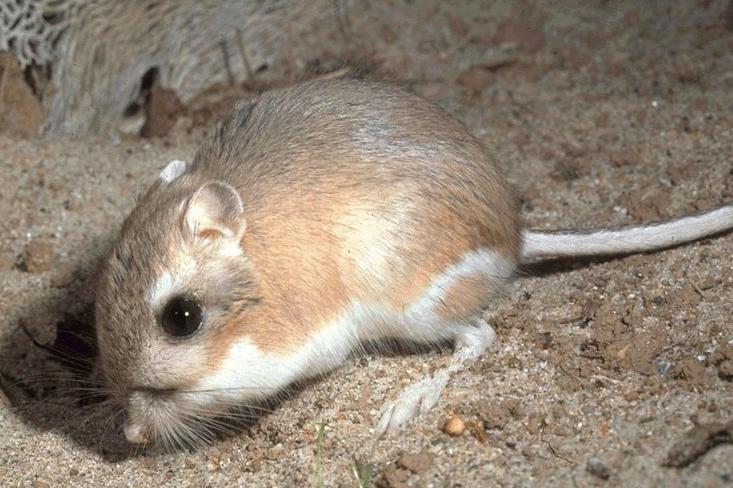
The desert kangaroo rat is a small rodent that is native to the deserts of Death Valley National Park. These rats have adapted to the harsh desert environment and are able to survive on very little water, obtaining most of their moisture from the seeds and plants that they eat.
Desert kangaroo rats are primarily active at night, when the temperatures are cooler. They have large hind legs that are adapted for jumping, and are able to cover long distances in search of food and water. They are also known for their ability to avoid predators, using their sharp senses to detect and evade danger.
Visitors to Death Valley National Park may be able to spot desert kangaroo rats at night, particularly in areas where there is vegetation and a source of water. They may also be seen darting across the desert floor, as they move between burrows and feeding grounds.
Chuckwallla
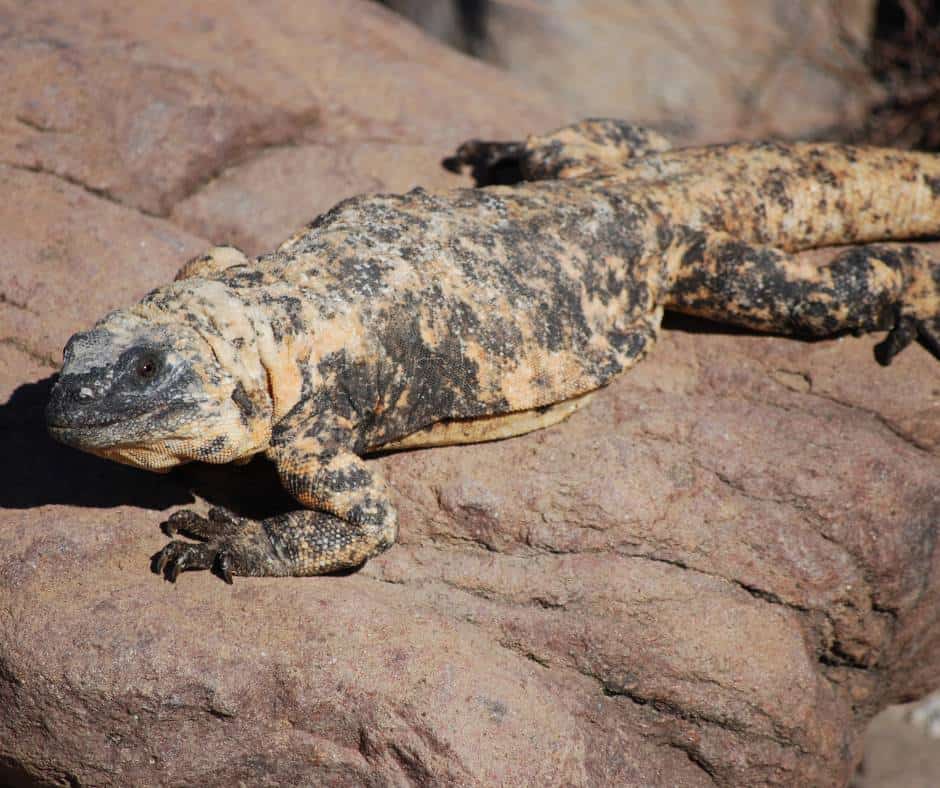
The chuckwalla is a species of lizard found in the southwestern part of the United States, including Death Valley National Park. They are known for their unique appearance, with a stocky body and prominent folds of skin around their neck and shoulders.
In Death Valley, the chuckwallas can often be found basking on rocks or hiding in crevices to avoid the extreme heat of the desert. They are primarily herbivorous, feeding on a variety of plants and occasionally insects.
The chuckwalla has a unique defense mechanism called “tail autotomy,” which allows it to break off its tail if it is caught by a predator. The detached tail will continue to wiggle, distracting the predator while the chuckwalla makes its escape.
These lizards are often brown or gray in color, blending in with their desert surroundings. They can grow up to 16 inches in length and have a lifespan of up to 25 years.
Visitors to Death Valley National Park may be able to spot chuckwallas while hiking or driving through the park, especially in rocky areas or along canyon walls. They are often found basking in the sun on large rocks, especially in the morning hours.
They can be spotted on the rocks around Mesquite Flat Sand Dunes, Mosaic Canyon, Titus Canyon, and around the park’s other canyons and rock formations. They can also be seen along hiking trails, such as the Golden Canyon Trail, Gower Gulch Loop Trail, and Zabriskie Point.
Chuckwallas are generally shy and prefer to avoid humans, so visitors may need to be patient and observant to spot them in their natural habitat. They will hibernate during the winter but are active in high desert temperatures, up to about 102 degrees.
Black-tailed Jackrabbit
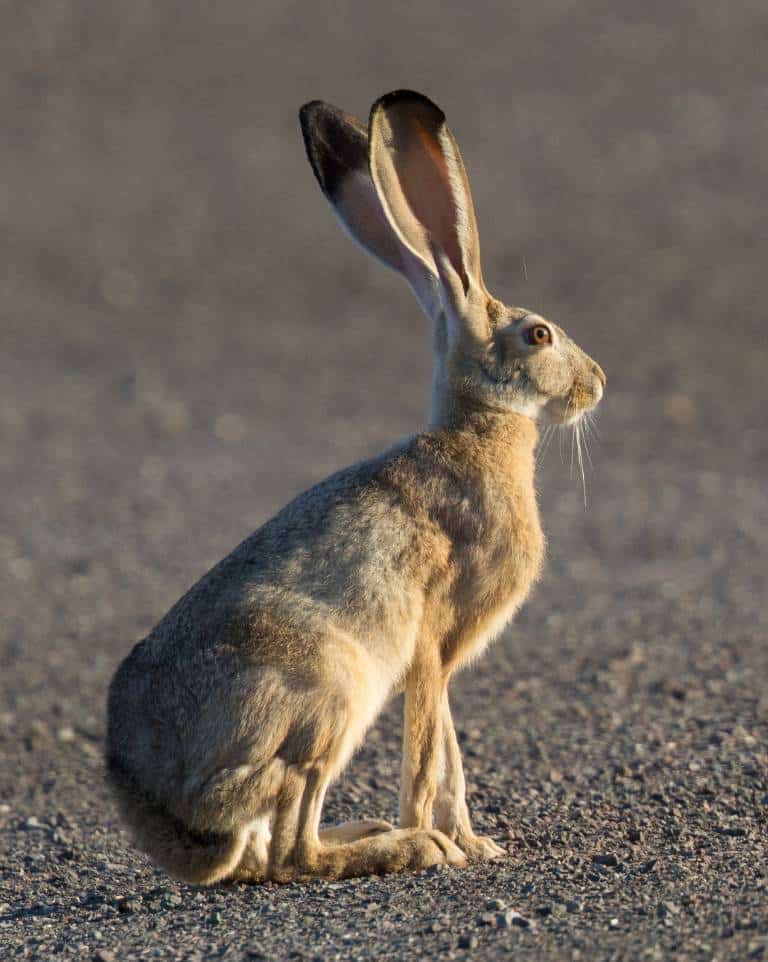
The black-tailed jackrabbit is a common species found in the deserts of California, including Death Valley National Park. They are known for their long ears, powerful hind legs, and distinctive black tail.
In Death Valley National Park, black-tailed jackrabbits are found in a variety of habitats, including desert scrub, grasslands, and rocky areas. They are herbivores, feeding on a variety of plants including grasses, shrubs, and cacti.
Black-tailed jackrabbits are active during the day and are most commonly seen in the early morning or late afternoon hours. They are able to run at speeds of up to 40 miles per hour, which allows them to quickly evade predators such as coyotes and bobcats.
Visitors to Death Valley National Park may be able to see black-tailed jackrabbits in the wild, particularly in the park’s more open and arid areas. One of the most common places to spot them is the Mesquite Flat Sand Dunes where they may be seen hopping through the sand or among the desert vegetation. They can also been along the edges of the salt flat in Badwater Basin and in the canyons and washes of the Stovepipe Wells area.
Desert Cottontail
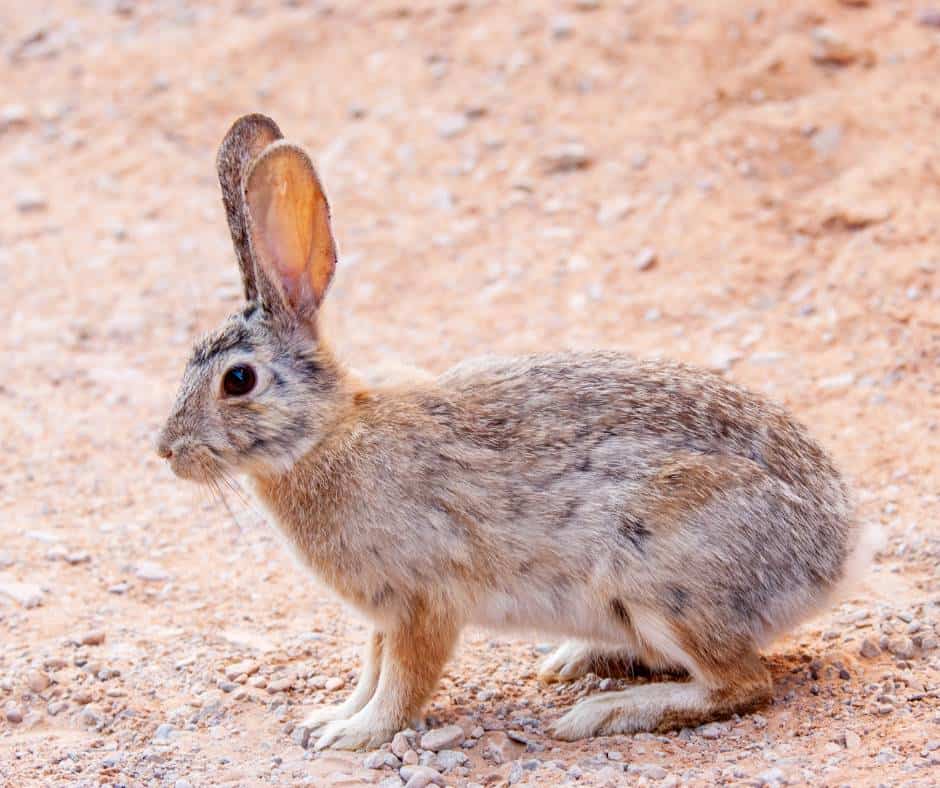
The Desert Cottontail is a common species found in Death Valley National Park. They are a small species of rabbit known for their soft, cotton-like tail and brown or gray fur.
Desert Cottontails are found in a variety of habitats, including desert scrub, grasslands, and rocky areas. They feed on a variety of plants including grasses, shrubs, and cacti They are active during the day and are most commonly seen in the early morning or late afternoon hours. They are able to run at speeds of up to 20 miles per hour.
Visitors to Death Valley National Park may be able to see Desert Cottontails in the wild, particularly in the park’s more open and arid areas. As with all wildlife, it is important to observe them from a safe distance and not to approach or disturb them.
Like the jackrabbit, the cottontail is seen near Mesquite Flat Sand Dunes, Badwater Basin, and Stovepipe Wells. Also keep an eye out for them while visiting Harmony Borax Works. Visitors may see them around the ruins or along the nearby dirt road.
Mojave desert sidewinder rattlesnake
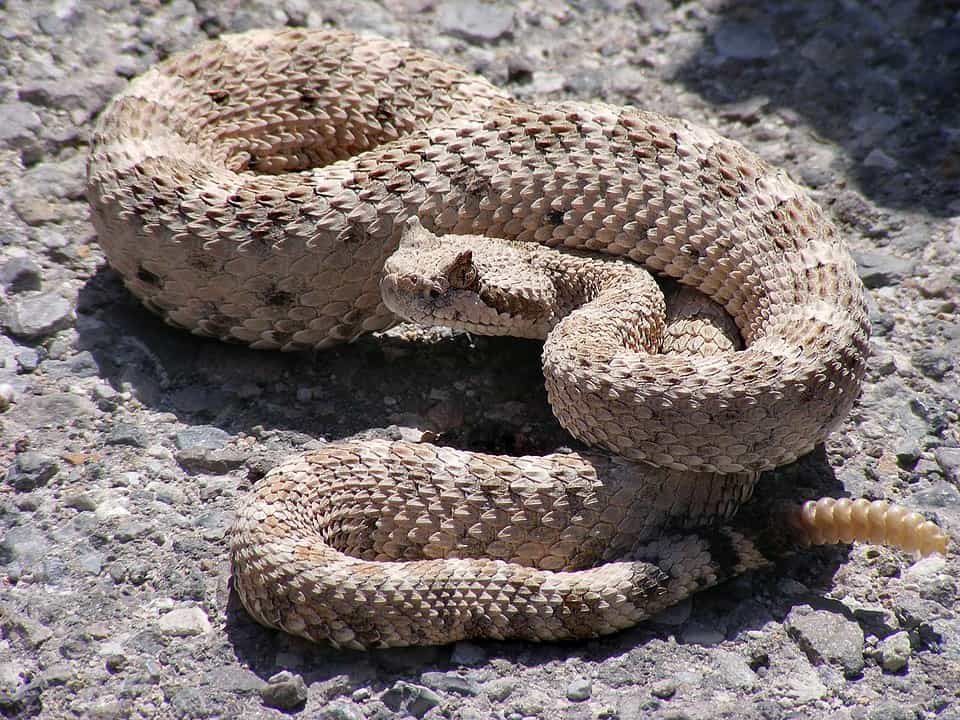
There are nearly 20 different species of snakes that live in Death Valley and you can read about all of them in my extensive guide to the snakes of Southern California. I am going to point out three of the most commonly seen snakes inside Death Valley National Park.
The Mojave desert sidewinder rattlesnake is a venomous snake native to the Mojave and Sonoran deserts, including Death Valley National Park. It gets its name from the distinctive way it moves sideways, with only two points of contact on the ground at any given time, allowing it to move quickly and efficiently across loose sand.
Mojave desert sidewinder rattlesnakes are typically tan or pale brown in color, with darker brown or black diamond-shaped markings along their backs. They are relatively small, typically growing to a length of around two to three feet.
While Mojave desert sidewinder rattlesnakes are venomous, they are generally not aggressive towards humans and will typically try to avoid confrontation if possible. The best places to spot these snakes are in the lower elevations of the park, particularly in areas with loose sand and sparse vegetation. They are most active in the early morning and late afternoon.
Rosy Boa
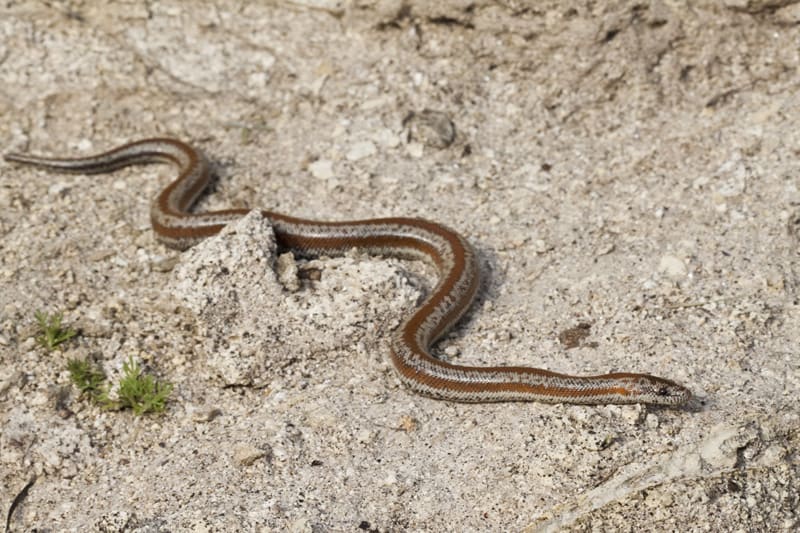
The Rosy Boa is a non-venomous snake species found in Death Valley. These snakes are easily recognized by their characteristic pinkish to reddish-brown dorsal coloration with dark brown or black markings on their back and sides, and a lighter pinkish coloration on their belly.
Rosy Boas are relatively small, with adults typically reaching lengths oftwo to three feet. They are active during the evening and at night, spending most of the day hiding under rocks or in burrows to avoid the heat of the sun. These snakes are carnivorous, feeding primarily on small rodents, lizards, and other snakes.
Rosy Boas are docile and gentle snakes, making them popular as pets, but snakes should never be taken from the wild. These snakes spend most of their time underground, preferring rocky habitats, including boulder piles and crevices, as well as desert scrubland and sandy washes.
Great Basin Gopher Snake
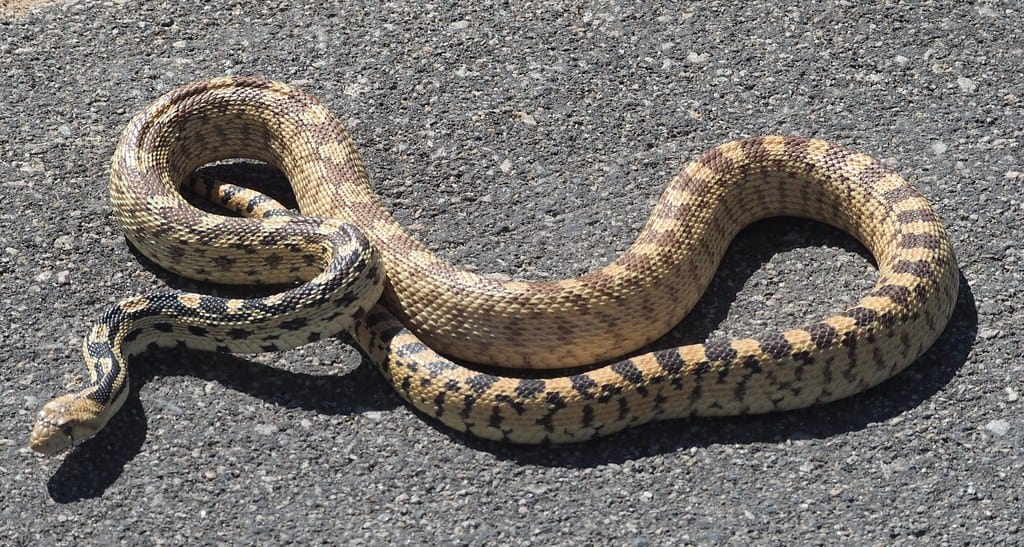
The Great Basin Gopher Snake is a non-venomous snake that grows up to six feet in length. They are primarily found in areas with dry, rocky terrain, such as desert grasslands, sagebrush plains, and rocky hillsides. In Death Valley National Park, they are commonly seen in the higher elevation areas, such as the Panamint Mountains and the Grapevine Mountains.
Great Basin Gopher Snakes are known for their distinctive patterns and colors, which can vary depending on the individual snake and its location. They are usually tan or brown in color with dark brown or black markings that run along their back and sides. They can be mistaken for rattlesnakes but these snakes have no rattle and are not venomous.
The Great Basin Gopher Snake is a carnivore and feeds on a variety of prey including rodents, birds, lizards, and other snakes. They are constrictors, meaning they wrap their bodies around their prey and squeeze until they cannot breathe.
In Death Valley National Park, the best place to spot the Great Basin Gopher Snake is in rocky areas and canyon floors, such as Mosaic Canyon, Titus Canyon, and Golden Canyon. You may also spot them along the trails that lead to the park’s high-elevation peaks, such as Telescope Peak or Wildrose Peak.
Another popular location to see Great Basin Gopher Snakes is along the park’s main roads, particularly in the areas where the road cuts through rocky terrain. These snakes can often be seen basking on the warm pavement during the cooler morning hours so keep an eye out as you drive!
Panamint Rattlesnake

The Panamint Rattlesnake is a rattlesnake found in the Panamint Mountains of Death Valley National Park. It lives on rocky slopes, in canyons, and in the shrublands this arid desert range.
This rattlesnake has a slender body with a distinct diamond-shaped pattern along the back. The coloration of the snake varies, but it typically has a gray or brownish background color with dark brown or black blotches bordered by lighter edges. Adults are usually 3 to 4 feet in length.
The Panamint Rattlesnake is venomous and has a rattle at the end of its tail warning you not to touch. If you get bit by a rattlesnake, seek medical attention immediately.
They are primarily nocturnal and secretive, spending much of their time hidden under rocks or in crevices during the day. They feed on small mammals, lizards, birds, and other snakes.
The Panamint Rattlesnake is considered a species of conservation concern due to its restricted range and habitat fragmentation. It is protected under California state law, and efforts are being made to conserve its habitat and monitor its populations.
Pocket Gophers
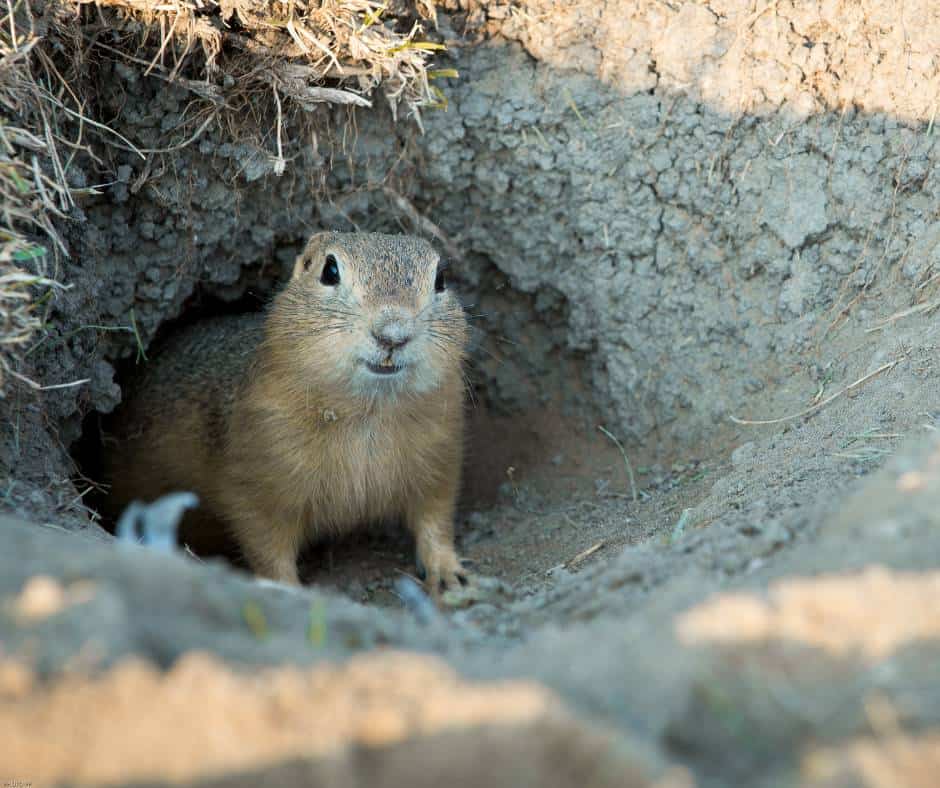
Pocket gophers are small burrowing rodents that are found in Death Valley National Park. These animals are known for their extensive tunneling systems, which they use to obtain food, create shelter, and navigate through their environment.
In Death Valley, pocket gophers are found in a variety of habitats, including desert scrub and open grasslands. They are important ecosystem engineers, as their burrowing helps to aerate the soil, increase water infiltration, and mix organic matter into the soil.
Visitors to Death Valley National Park are unlikely to see pocket gophers, since they spend most of their time underground. However, they may be able to observe their tunneling activity, which is often visible on the surface as mounds of soil or disturbed vegetation.
Ground Squirrel
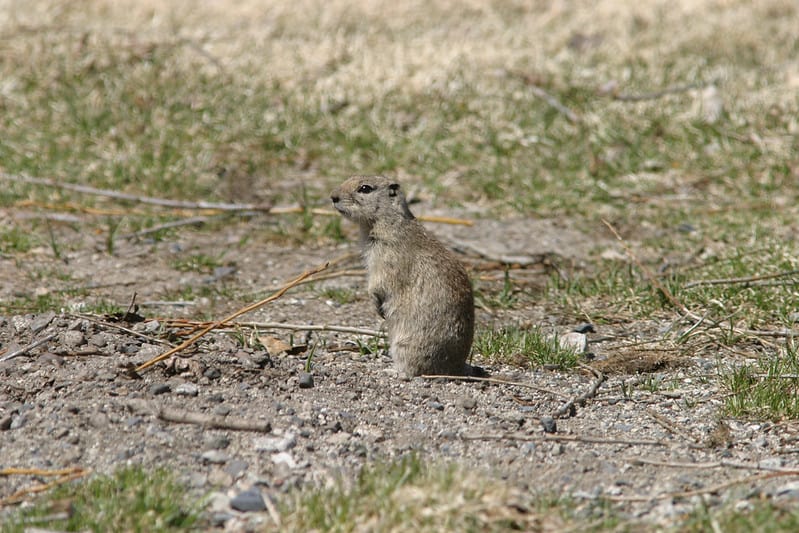
Several species of ground squirrels can be found in Death Valley National Park, including the golden-mantled ground squirrel, the rock squirrel, and the round-tailed ground squirrel. These small rodents are adapted to the desert environment and play an important role in the park’s ecosystem.
Ground squirrels are diurnal, meaning they are active during the day, and can often be seen foraging for food or sunning themselves on rocks or logs. They eat a variety of foods, including seeds, nuts, fruits, and insects.
Visitors to Death Valley may encounter ground squirrels in campgrounds, picnic areas, or along hiking trails. While they may seem cute and harmless, it is important to remember that feeding wildlife is always a bad idea. Feeding ground squirrels can cause them to become habituated to humans, and can also lead to aggressive behavior or the spread of disease like the bubonic plague.
Kit Fox
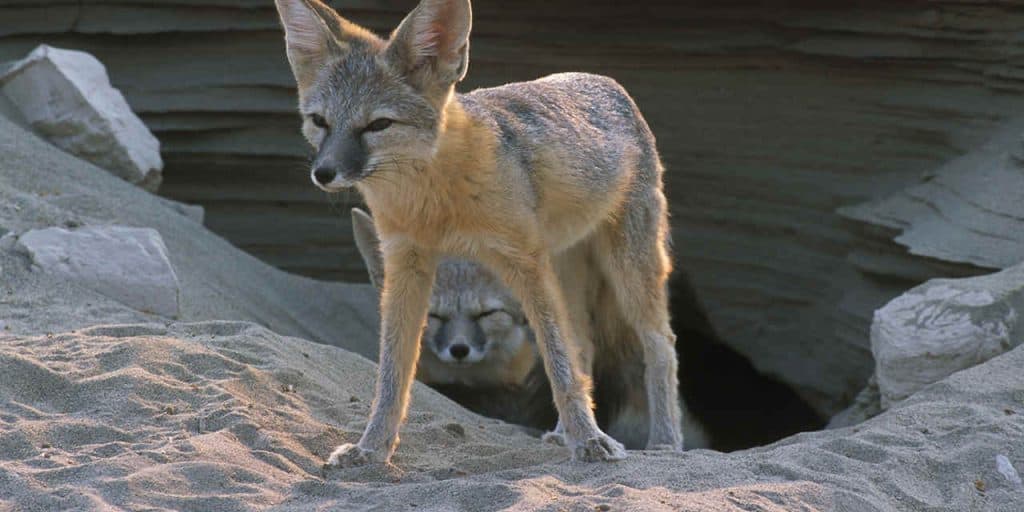
The kit fox is a small, nocturnal canid that can be found in the Mojave Desert, including in Death Valley National Park. They are typically found in arid environments with sparse vegetation, where they feed on small mammals, insects, and fruit.
The kit fox is an important part of the desert ecosystem and helps to control rodent populations. They are also a key prey species for larger predators, such as coyotes and golden eagles.
Kit foxes are well adapted to the harsh desert environment and have several physical and behavioral adaptations that help them survive. For example, they have large ears that help them regulate their body temperature and locate prey, as well as thick fur that insulates them from the extreme temperatures of the desert.
While kit foxes are relatively common in Death Valley National Park, they can be difficult to spot due to their nocturnal habits and the fact that they are generally shy and elusive. Visitors to the park may have the best chance of seeing kit foxes at dawn or dusk, when they are most active. They have been most commonly spotted in the Mesquite Flat Sand Dunes, the Ubehebe Crater area, or along the park’s perimeter.
Gray Fox
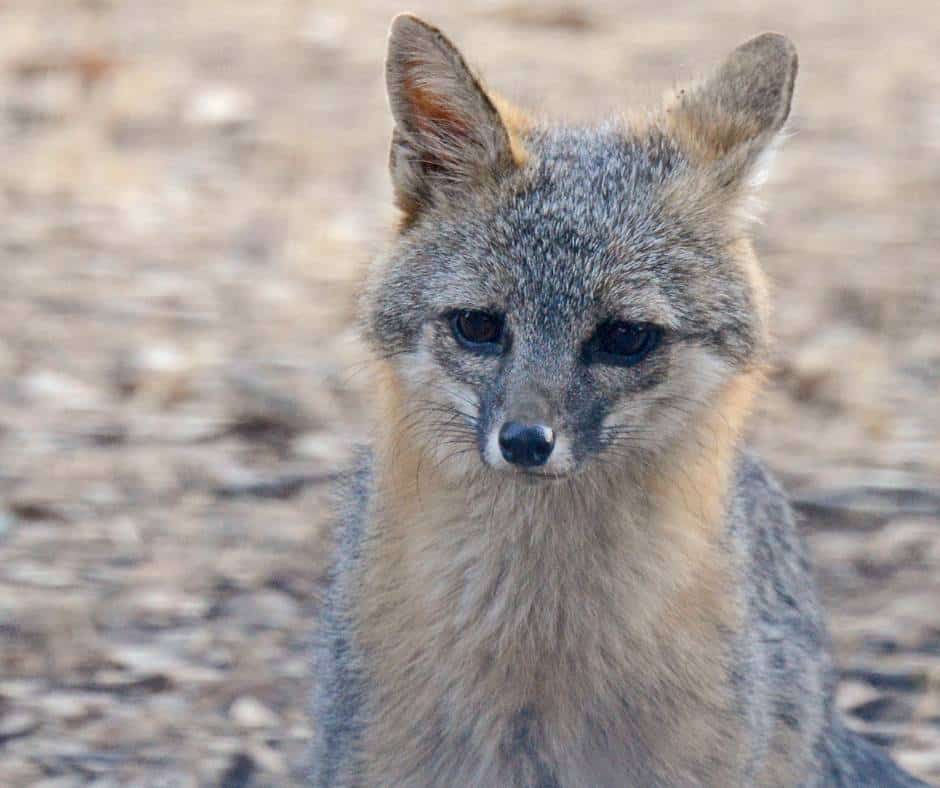
The gray fox is a small to medium-sized canid that can be found throughout much of North America, including the mountainous areas of Death Valley National Park. They are typically found in woodlands, chaparral, and other areas with dense vegetation, where they feed on small mammals, birds, and reptiles.
Gray foxes are notable for their climbing abilities, which are unusual for a member of the canid family. They are able to climb trees and other vertical surfaces using their strong claws and flexible ankles, allowing them to escape predators or access food sources that other animals cannot reach.
In Death Valley National Park gray foxes are most often seen in the Panamint Range and the Grapevine Mountains. They are primarily nocturnal, and are most active at night when they hunt for food.
Badger
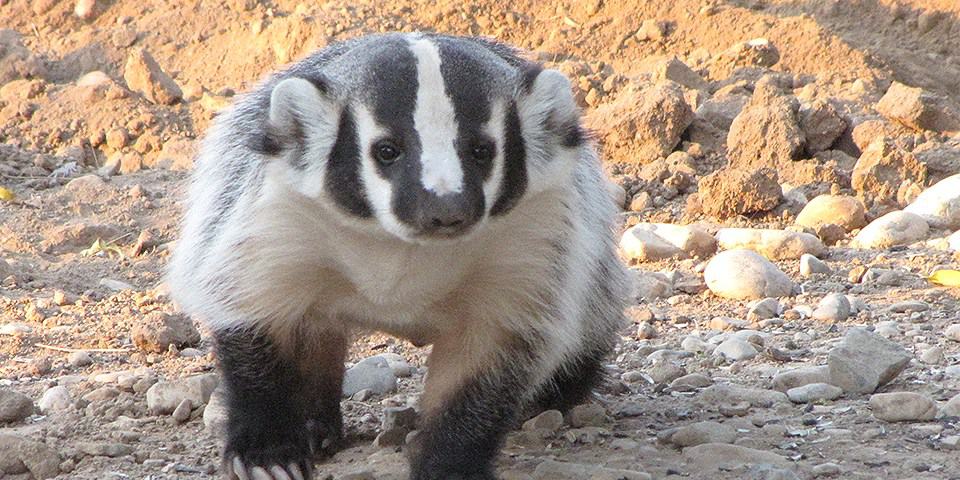
The American badger is a carnivorous mammal known for their stocky, powerful build, and their ability to dig and burrow in search of prey.
In Death Valley National Park, badgers can be found in a variety of habitats, from sandy desert flats to rocky mountain slopes. They are primarily nocturnal and are most active at night when they hunt for prey such as rodents, reptiles, and small mammals.
Visitors to the park may have the opportunity to see badgers while driving or hiking in the early morning or late evening. However, badgers are typically shy and elusive, and are more likely to be heard than seen.
Bobcat

Bobcats are small to medium-sized wild cats that live in Death Valley National Park. They are generally shy and elusive animals, and are most active during dawn and dusk, although they may be active at any time of day.
In Death Valley, bobcats can be found in a variety of habitats, including desert scrub, rocky canyons, and pinyon-juniper woodlands. They are opportunistic hunters and prey on a variety of small mammals, birds, and reptiles, as well as insects and other invertebrates. They may also scavenge on carrion.
They can be difficult to spot due to their secretive nature and their excellent camouflage. However, visitors may be able to spot them at dawn or dusk, especially in areas where prey is abundant. They may also be seen crossing roads or hiking trails, or resting in the shade of rocks or vegetation during the heat of the day.
Burros
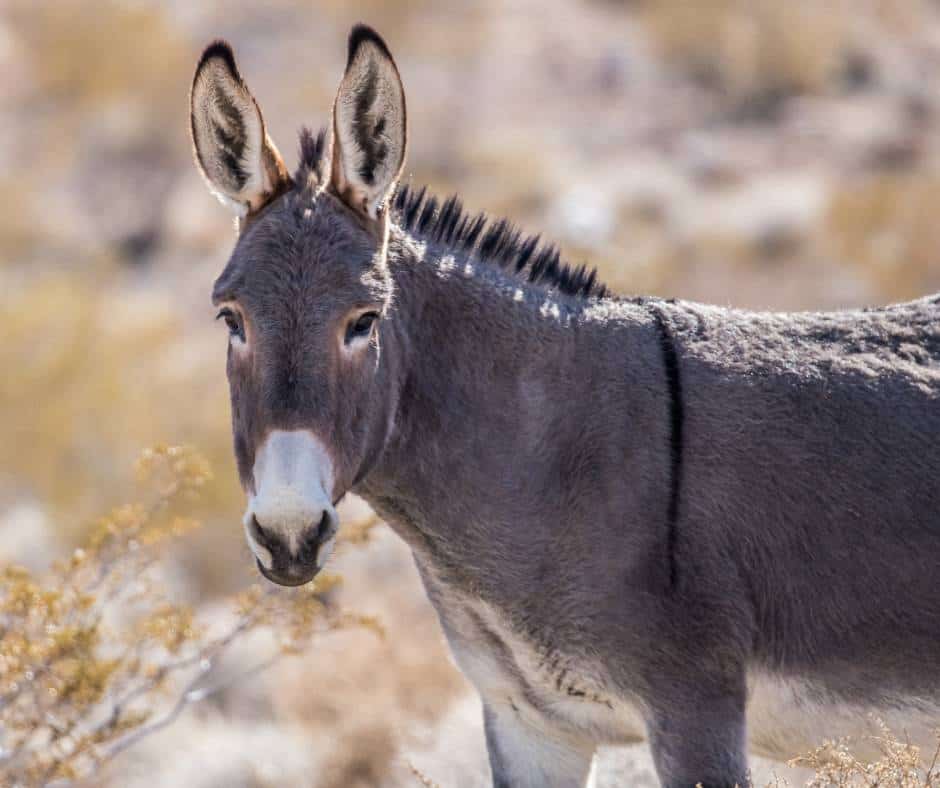
The burro, in Death Valley National Park are descendants of the pack animals brought to the area during the mining era. They are an iconic part of the park’s history and landscape but they are also considerd an invasive species. Today, they experience a population growth of 20% per year!
Burros roam freely throughout the park and can often be seen along the park’s scenic drives and in the surrounding desert areas. They cause damage to the native vegetation and fragile ecosystems as they eat 6,000 pounds of plants per burro per year and compete with native species about desert tortoises and bighorn sheep for resources.
Attempts to remove the burros come at a great cost. In the 1980s $400,000 was spent on a 32 mile fence along the park’s northeastern border. It was ineffective. Useing helicopters to move burros costs about $1,000 per hour- not exactly budget friendly. So, for now, the burros stay.
While these burros may appear friendly, it is important to remember that they are wild animals and should be treated with caution. Feeding or approaching them can be dangerous, and visitors are advised to observe them from a safe distance. It is also illegal to capture, feed, or harass the burros.
Visitors to the park may encounter the burros on the popular Wildrose Charcoal Kilns road or in areas such as Titus Canyon, where the animals sometimes gather around the spring. The burros can also be seen at Furnace Creek Ranch and Stovepipe Wells Village, where they occasionally wander into the parking lots.
Pupfish
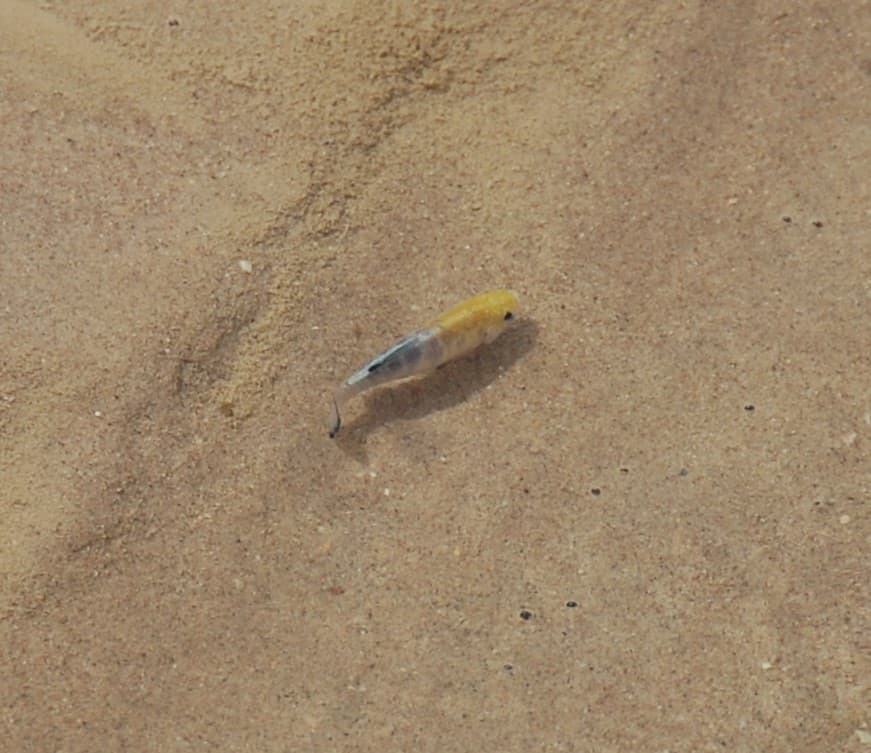
Yes, there are fish in the desert! There are actually several species of pupfish found in Death Valley, all of which are adapted to the extreme conditions of the park’s waterways. These include the Salt Creek pupfish, the Devils Hole pupfish, the Cottonball Marsh pupfish, and the Amargosa pupfish.
The Salt Creek pupfish lives in the shallow, warm waters of Salt Creek and can tolerate high levels of salt and temperatures up to 104°F. They feed on algae and small aquatic insects and have a distinctive breeding behavior where males dig shallow nests in the sand and attract females by flashing their brightly colored fins.
There was a boardwalk known as the Salt Creek Interpretive trail that allowed for easy viewing of the fish in winter and spring but it was destroyed by a massive flash flood in August of 2022. They flood alteres the creek bed and surrounding are and it will take some time to get things rebuilt.
The Devils Hole pupfish, found only in the Devils Hole pool in the Amargosa River basin, is one of the most endangered fish species in the world. They are adapted to the constant, warm temperatures of the pool and have a specialized diet of blue-green algae. hey are heavily protected by park rangers.
A recent study by national park service scuba divers shows that there are about 175 Devils Hole pupfish, up from the low of 35 in 2013.
The Cottonball Marsh pupfish, found in the springs and marshes near the Nevada border, is one of the largest pupfish species in the park and is known for its bright blue coloration during breeding season. They are found in Cottonball Marsh on the west side of central Death Valley.
Finally, the Amargosa pupfish, found in the Amargosa River system, is also adapted to high temperatures and salt levels. They are small and relatively plain in appearance, but are important indicators of water quality in the region. Found in the Amargosa River northwest of Saratoga Springs.
Horned Lizard
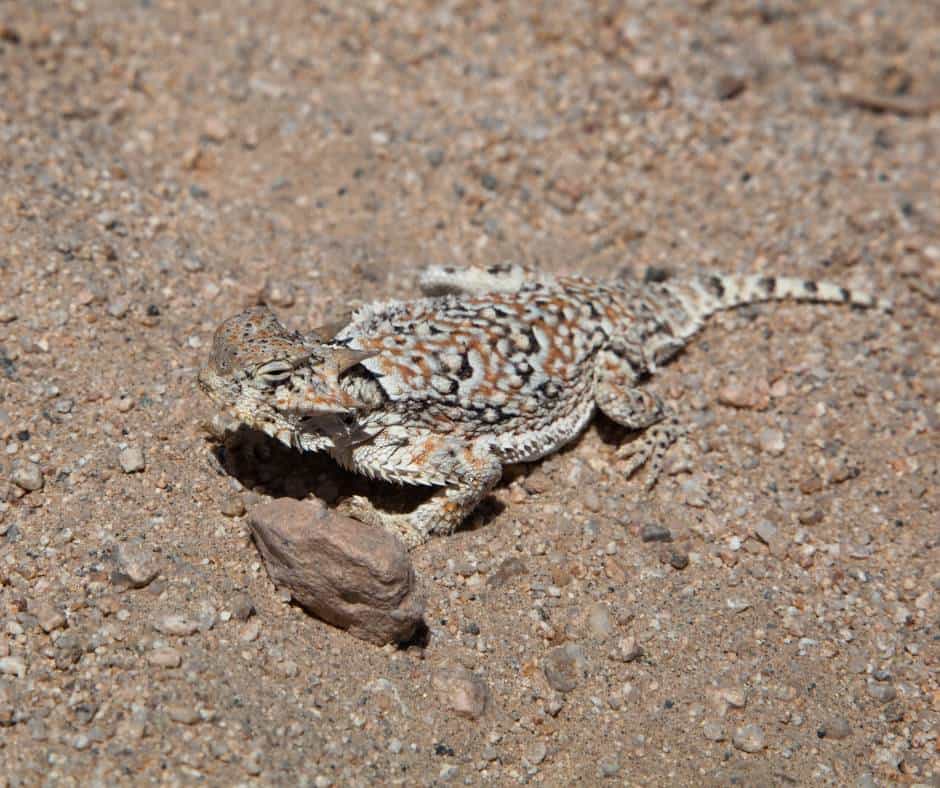
The horned lizard, also known as the horny toad or the horned desert lizard, is a common sight in Death Valley National Park. These unique lizards are easily identified by their distinctive body shape and the rows of horns on their heads and backs.
This small reptile typically grows to be around three to five inches long. They are well adapted to life in the desert, with a wide, flattened body that helps them stay close to the ground and avoid the intense heat of the sun. Their skin is covered in a series of bumpy scales, which help to protect them from predators and conserve water.
One of the most interesting things about the horned lizard is its unique defense mechanism. When threatened, the lizard will puff itself up with air, making it appear larger and more intimidating to predators. Some species of horned lizard are also able to shoot blood from their eyes as a way of deterring predators.
In Death Valley National Park, horned lizards can be found in a variety of habitats, from rocky outcroppings to sandy washes. They are most commonly spotted in the early morning and late afternoon, when they are most active. Look for these fascinating reptiles in rocky areas, or near the base of shrubs and other vegetation.
One of the best places to look for horned lizards in Death Valley is around Mesquite Flat Sand Dunes. Here, visitors may spot the desert horned lizard, which has a distinct pattern of black and white spots and stripes that help it blend in with the sand. Horned lizards can also be found in other areas of the park, including Wildrose Charcoal Kilns and around the Furnace Creek area.
Zebra-tailed Lizard

The zebra-tailed lizard, also known as the “tiger lizard,” is a small species of lizard found in Death Valley. They are easily identified by their distinctive black and white striped tails, which resemble those of a zebra.
These lizards are well adapted to the harsh desert environment, with their flat bodies allowing them to easily move over loose sand and rocky terrain. You may also see them on washes or on the edge of roads. They are primarily active during the daytime, and are often seen basking in the sun or seeking shade under rocks or other objects.
In Death Valley National Park, they can be found in areas with loose sand and rocky outcroppings, such as the Mesquite Flat Sand Dunes and the Badwater Basin. Another great place to see zebra-tailed lizards is in the hills around Titus Canyon.
Zebra-tailed lizards feed primarily on insects such as grasshoppers, beetles, and ants. They are also known to occasionally eat other small lizards.
Desert Iguana
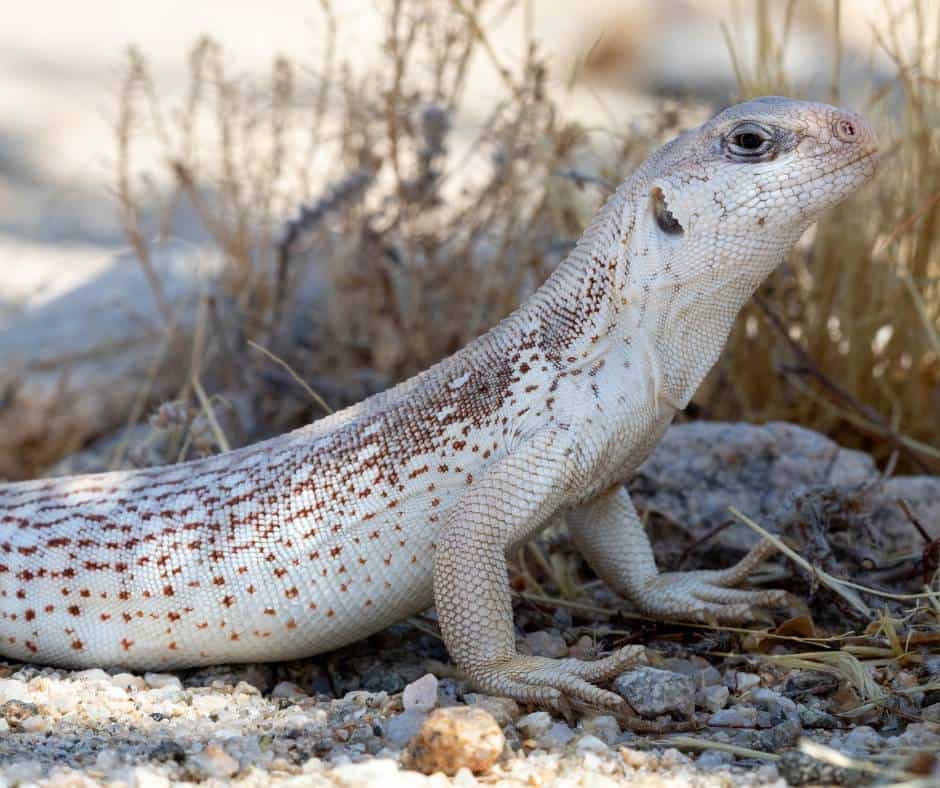
The Desert Iguana is a common lizard species found in Death Valley. It is a medium-sized lizard that can grow up to 10 to 16 inches in length, with a relatively flat body, and a long tail that makes up two-thirds of its total length. They have a unique coloration, with a tan or gray body, and dark spots or stripes on the back, making them well-camouflaged against the sandy desert terrain.
The Desert Iguana is a diurnal reptile, meaning that it is active during the day and rests at night. They are primarily herbivores and feed on various desert plants, such as cactus, flowers, and leaves. However, they occasionally consume insects and other small animals.
During the breeding season, which occurs in the spring and early summer, the male Desert Iguana becomes territorial and will engage in head-bobbing and push-up displays to establish dominance over other males. Females will lay 3-8 eggs in a burrow dug in the sand, where they will incubate for 2-3 months.
Visitors to Death Valley National Park are likely to spot Desert Iguanas in rocky areas or desert terrain where there is ample vegetation. Some of the best places to spot them in the park include the Mesquite Flat Sand Dunes, Mosaic Canyon, and Emigrant Canyon. They are also commonly seen along roadsides, basking in the sun.
Tarantula
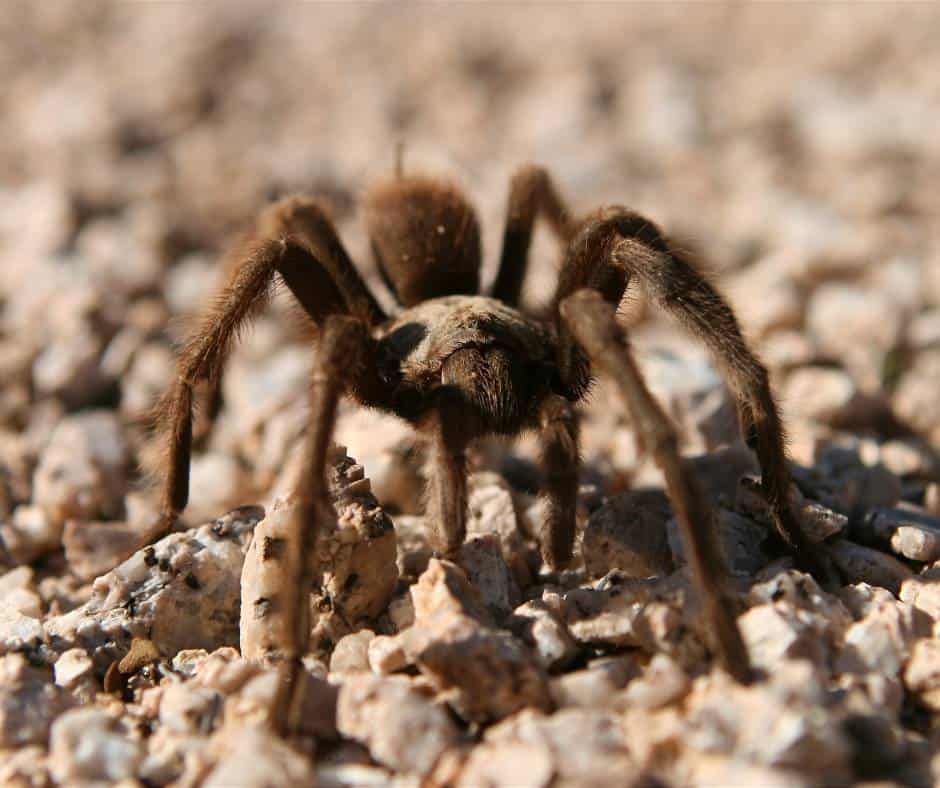
Tarantulas are one of the many interesting creatures found in Death Valley National Park. There are two species of tarantulas in the park, the desert tarantula and the Arizona blonde tarantula. The desert tarantula is the more common of the two and can be found in the lower elevations of the park, while the Arizona blonde tarantula is found in higher elevations.
These tarantulas are generally brown in color with a hairy body and legs. They have eight eyes, but their vision is poor and they rely more on their sense of touch and smell. They are nocturnal and spend their days in burrows that they create in the ground. At night, they venture out to hunt for insects and other prey.
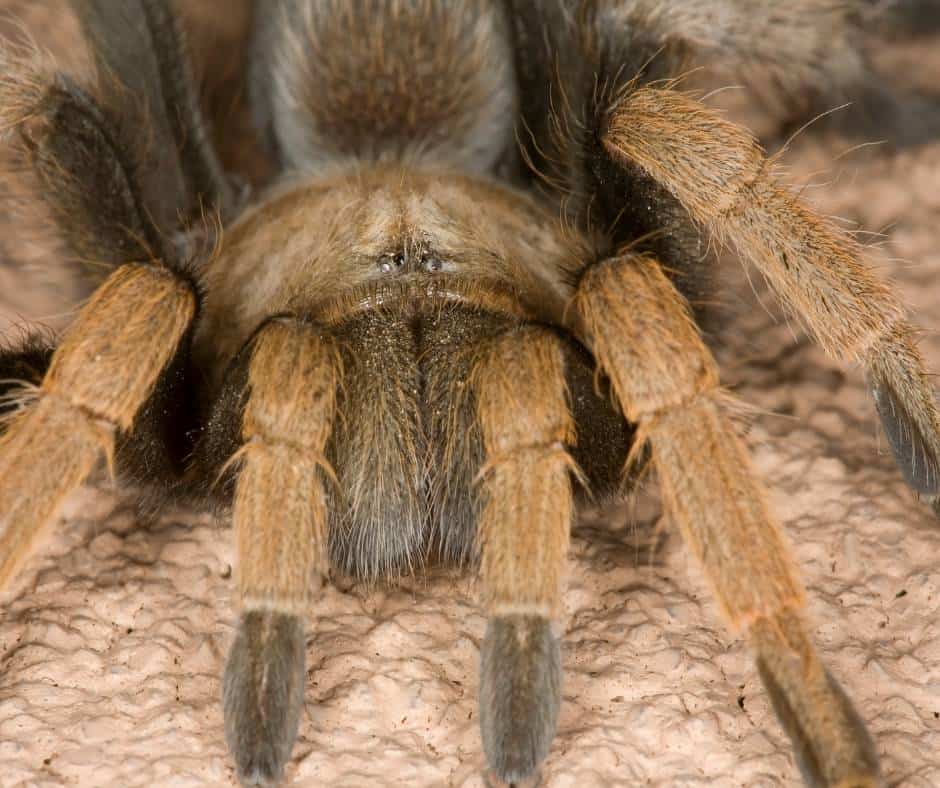
While tarantulas have a fearsome reputation, they are generally harmless to humans. Their venom is not deadly and is mainly used to subdue their prey. However, if provoked or handled roughly, they may bite as a means of self-defense.
The best time to see tarantulas in Death Valley National Park is during the fall when they are out and about looking for mates. They can be found in open areas and along hiking trails. If you come across a tarantula, it is important to give them space and avoid disturbing them.
Scorpion
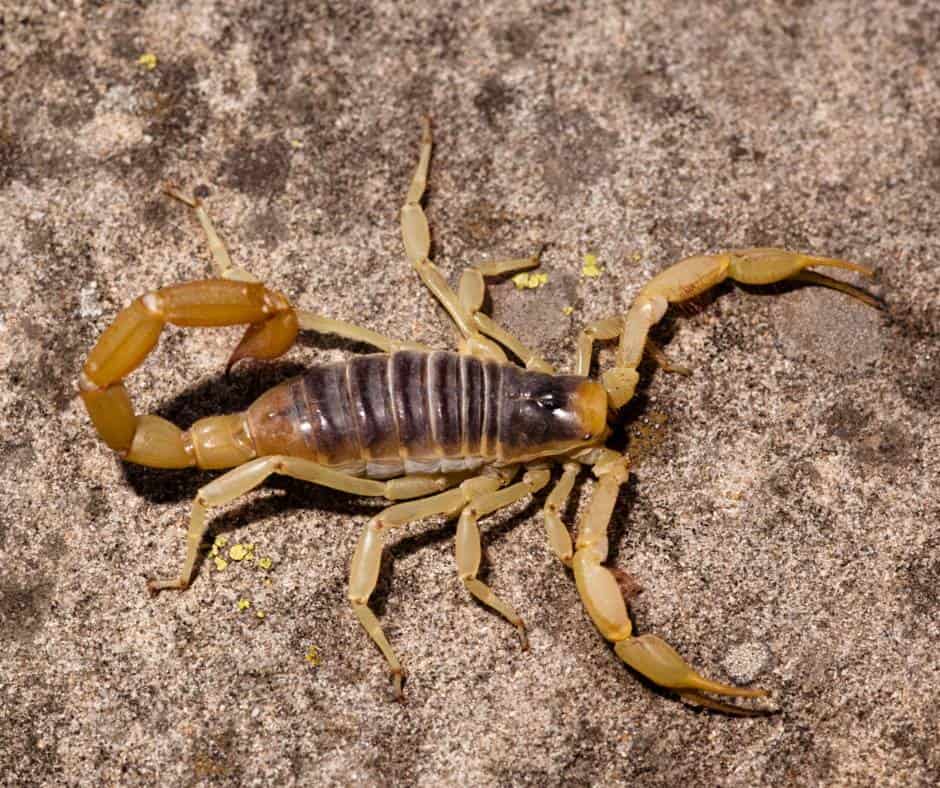
There are two species of scorpions commonly found in Death Valley National Park: the desert hairy scorpion and the stripe-tailed scorpion.
The desert hairy scorpion is one of the largest scorpion species in North America, growing up to six inches in length. They are commonly found in Death Valley, and are known for their hairy appearance. They are nocturnal and feed on insects and other small animals.
The stripe-tailed scorpion is a smaller species, growing up to three inches in length. They are also found in desert regions and are recognizable by the distinctive stripes on their tails. They are also nocturnal and feed on insects and other arthropods.
Both species of scorpions in Death Valley are venomous and should be treated with caution. While their stings are usually not life-threatening, they can cause pain and discomfort, and some individuals may experience an allergic reaction. Visitors should always avoid handling or disturbing scorpions.
Love learning about the animals that live in national parks? Then check out our guide to Animals in Yosemite.
]]>There is one national park unit within the city limits, but there are 11 more national parks that can be easily be reached from San Diego, making them incredible weekend destinations or day trips. This guide gives you the driving distance from San Diego and lots of things to do in each of these national park units.
12 National Parks Near San Diego
Cabrillo National Monument

Distance from Downtown San Diego: 11 miles (25 minutes)
Just 11 miles from downtown San Diego on the southern tip of the Point Loma Peninsula is Cabrillo National Monument, a place to experience the natural beauty and history of San Diego.
This historic site commemorates the arrival of Juan Rodriguez Cabrillo, the first European to set foot on the West Coast of the United States in 1542. Visitors can explore the museum exhibits and learn about the history of the region, including the Kumeyaay people who have lived in the area for thousands of years.
The monument is also home to Old Point Loma Lighthouse, one of the eight original lighthouses built on the West Coast. It served as a beacon for sailors entering San Diego Bay from 1855 to 1891.
Prime time to visit this area is December through March, when gray whales can often be spotted off Point Loma during the migration to and from their birthing grounds off the coast of Mexico.
Visitors can explore the tide pools during low tide and see a wide variety of sea life, including anemones, crabs, and starfish. There are several hiking trails that lead visitors through the park’s diverse landscape. The Bayside Trail is a great option if you are looking for sweeping views of the bay and downtown San Diego.
Joshua Tree National Park
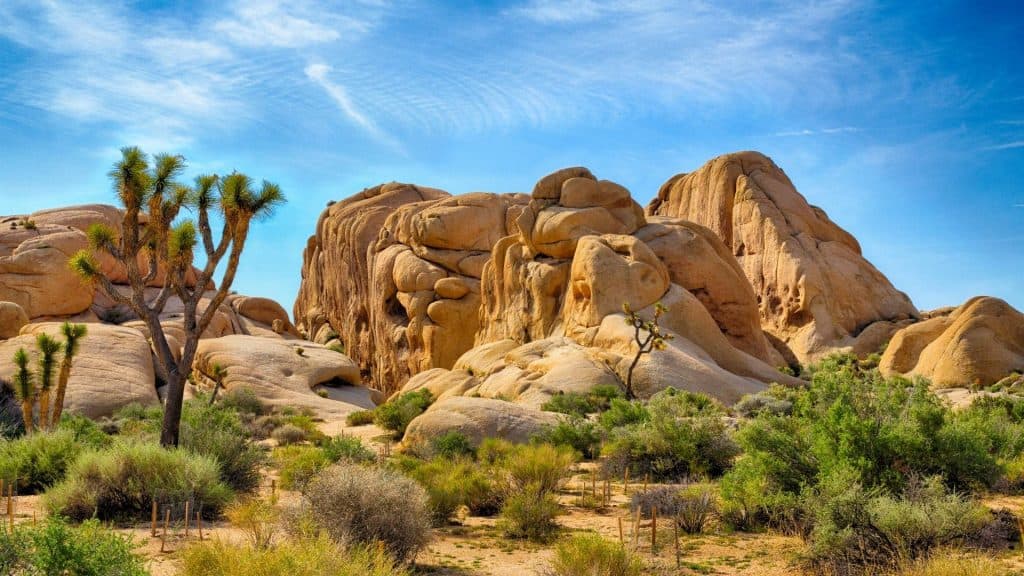
Distance from Downtown San Diego: 160 miles (Three hours)
With its towering boulders, diverse desert life, and iconic namesake trees, Joshua Tree National Park is a special place. The park is home to two different desert environments, the Mojave high desert and the Colorado low desert.
Joshua Tree is a great place to enjoy rock climbing and bouldering, and there are plenty of fun options for novices and experts alike.
One of the most popular things to do in Joshua Tree National Park is hiking. With over 800 miles of trails, visitors can choose from easy nature walks to more strenuous hikes up rocky terrain.
The trail to Barker Dam is a 1.1-mile loop trail with plenty of boulders to climb on, prehistoric rock art, and even the occassional appearance by desert bighorn sheep.
If you want more of a challenge, hike the 1.5-mile trail to the top of Ryan Mountain. It gains 1,000 feet in elevation in that short distance, but the 360-degree views of the park from the 5,461′ summit are worth the effort.
Additional highlights of this park include Skull Rock, the Keys Ranch tour, bouldering in Hidden Valley, and the sprawling vistas at Keys View.
The best time to visit Joshua Tree National Park is the spring when wildflowers are in bloom and the weather is mild. If you visit during the winter, snow is possible but most days are chilly and dry. I would avoid this park in the summer due to the soaring temperatures which make hiking dangerous.
Check out our epic Joshua Tree National Park day trip itinerary.
Santa Monica Mountains National Recreation Area

Distance from Downtown San Diego: 155 miles (Three hours)
The Santa Monica Mountains National Recreation Area spans over 150,000 acres, making it one of the largest urban parks in the world. It encompasses a variety of destinations like Franklin Canyon, Paramount Ranch, Solstice Canyon, Circle X Ranch as well as several more canyons and parks. It also works in collaboration with many of the surrounding state parks and beaches.
One of the best ways to explore the park is by hiking its many trails, which offer stunning views of the surrounding landscape. The Backbone Trail is a 67-mile trail that traverses the entire park and offers breathtaking vistas of the mountains and the Pacific Ocean. Pick a segment of this trail and enjoy the scenery which is especially scenic in the spring when it is covered in greenery and wildflowers.
The hike to Split Rock (3.5 miles RT) at the Circle X Ranch and the Solstice Canyon Trail (2.1 mile RT) which leads to a waterfall and ruins of an old cabin are also popular (and dog friendly!) trails.
If hiking isn’t your thing, there are plenty of other activities to enjoy in the park. The beaches along the coastline are perfect for swimming, sunbathing, and surfing. Point Mugu and Zuma Beach are two popular spots where you can catch some waves and soak up the California sunshine. Leo Carillo is a great place for tide pooling.
Carrizo Plain National Monument

Distance from Downtown San Diego: 270 miles (Six hours)
Carrizo Plain National Monument is a remote park in Central California that is located about ninety minutes from both Bakersfield and San Louis Obispo in between the rolling foothills that separate the Central Valley from the coast. It is the largest native grassland left in the state of California.
This park is known for its wildflower blooms in the spring, which produce a riot of color after a rainy winter. Color tends to peak in late March through April and include yellow daisies, owl’s clover, goldfields, coreopsis, poppies, and phacelia.
Another must-see attraction in the monument is Painted Rock, an ancient Native American site with pictographs and petroglyphs. Visitors can take a guided tour of the site to learn more about its history and cultural significance.
For those looking for a more active adventure, there are several hiking trails in the monument, including the Caliente Ridge Trail, which provides stunning views of the surrounding hills and valleys. You will also want to walk the boardwalk at Soda Lake, which reflects the wildflowers on its waters. If you want to walk on the famed San Andreas Fault, take the 1.3-mile Wallace Creek Trail.
Carrizo Plain National Monument is one of the few places in Califoria where you have a chance of spotting pronghorn antelope. They were once the most common big game animal in California’s Central Valley, but overhunting during the Gold Rush era and agricultural development drastically reduced their range and numbers. You can also spot tule elk inside the park.
Mojave National Preserve
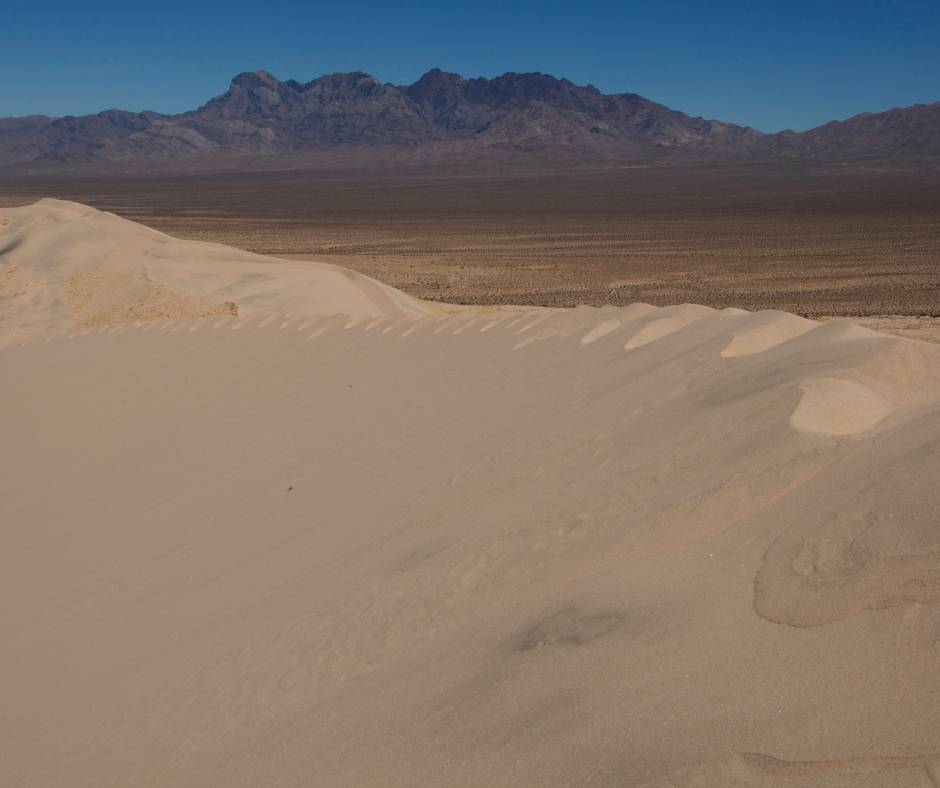
Distance from Downtown San Diego: 240 miles (Four hours)
Mojave National Preserve protects over a million acres of the Mojave Desert. As you can imagine, it is very hot in this park in the summer, so winter and shoulder season visits are the most enjoyable.
It is home to Kelso Dunes, some of the largest sand dunes in the country. These enormous piles of sand rise 600 feet above the desert floor. There is a three-mile trail around the dunes but they are most fun to just climb and slide, snowboard, or even roll down.
These dunes are known to “sing”, making a deep sound that happens when a large amount of sand is pushed off the top of the dunes in hot weather.
Another popular attraction is the Mitchell Caverns, which offers guided tours of an underground cave system. Visitors can explore the unique rock formations and learn about the geological history of the area.
Here are 25 awesome caves in California to explore.
You will also want to check the park’s lava tube. It was created by molten lava 27,000 years ago. There is a beam of light that shines into the lava tube at certain times of day (usually early afternoon in the summer), begging to be photographed.
You also won’t want to miss the 1.5-mile Hole-in-the-Wall Rings Trail where you can use the rock-mounted ringbolts to climb into the rocky amphitheater at the bottom of Banshee Canyon.
Castle Mountains National Monument

Distance from Downtown San Diego: 310 miles (5 1/2 hours)
Castle Mountains National Monument, established in 2016, is located two hours east of Barstow. It protects 21,000 acres of desert northwest of the Colorado River in between Interstates 15 and 40. This desert is very much alive with Joshua trees, rare desert grasslands, seasonal desert wildflowers, and even pinyon-juniper forest at the highest elevations.
The Castle Mountains are protected habitat for a variety of wildife including for desert bighorn sheep, mountain lions, bobcats, golden eagles, gila monsters, and desert tortoise.
One of the highlights of the monument is the Castle Mountains themselves, which offer stunning views of the surrounding desert landscape. The mountains are a popular destination for hikers and provide a challenging but rewarding hike to the summit.
There are several abandoned mines and ghost towns to explore. The Hart Mine and the Oro Belle Mine are both popular destinations as historic sites like the restored Hart Homestead, which provides a glimpse into life in the desert in the early 1900s.
This park is only accessible by dirt roads, so a four-wheel-drive, high clearance vehicle is recommended. There are no maintained trails; simply drive in and hike where you want. Here is a good article on visiting this remote national monument.
Channel Islands National Park
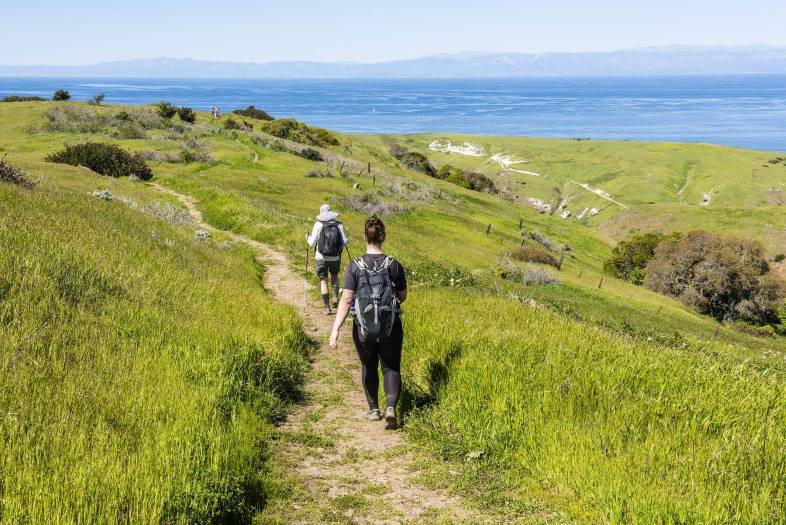
Distance from Downtown San Diego: 190 miles (Three hours)
The Channel Islands National Park may be one of the closest national parks near San Diego, but it is also one of the least visited. This is because reaching these islands involves a boat trip, so only about 400,000 people make the journey each year.
Skipping this national park would be a shame, because these wild and untamed islands are filled with incredible scenery and help us catch a glimpse of what the California coast might have been like generations ago.
The first step to visiting is to book a trip with Island Packers. This boat ferry company has trips to several different islands, including options for campers. Keep your eyes open for whales and dolphins as you cross the channel. Day trips are popular ways to see the islands, and Anacapa and Santa Cruz are the most popular islands to visit.
Sea kayaking is one of the best things to do at Channel Islands National Park. Santa Cruz Island is the most popular place for sea kayaking because of its incredible sea caves. Santa Barbara Adventure Company offers great sea kayaking tours.
Snorkeling is another activity at Channel Islands. The water is cold, so wetsuits are highly encouraged. The kelp forests surrounding the islands are amazing and full of sea life.
Hikers will want to visit during wildflower season in the spring. The bright yellow brilliant yellow coreopsis flowers are showstoppers. Keep your eyes out for the tiny Channel Island fox which stands at just a foot tall and weighs only 4-5lbs.
Death Valley National Park
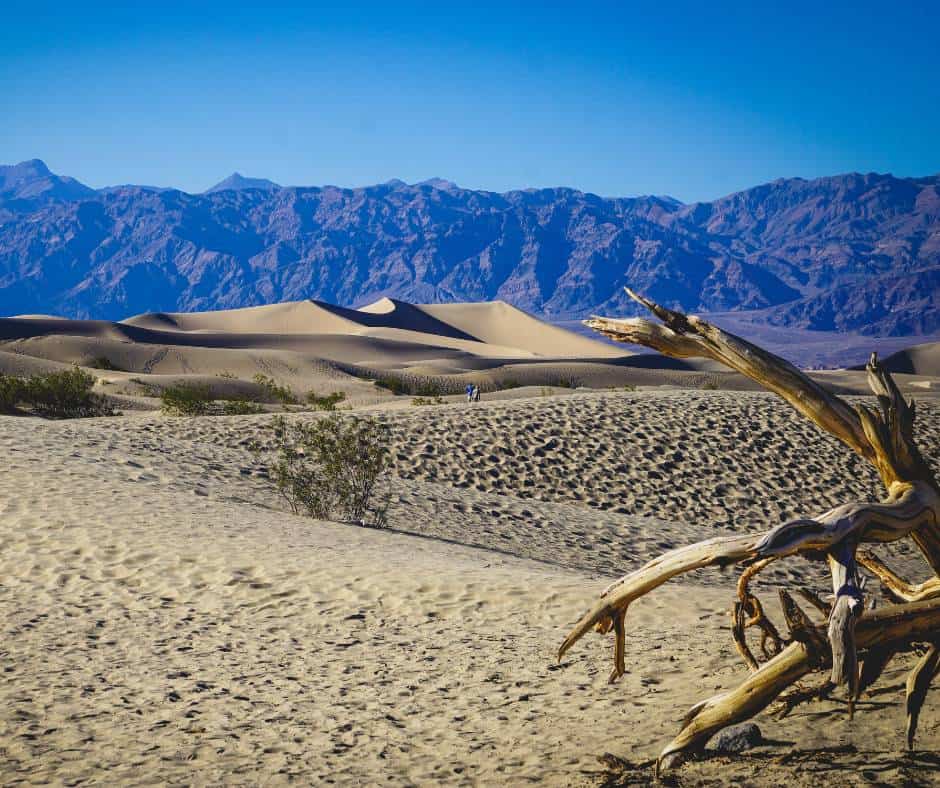
Distance from Downtown San Diego: 283 miles (Five hours)
Death Valley National Park is 3,422,024 acres in size, making it the largest national park outside of Alaska. It is also a park of stark contrast. Badwater Basin, the lowest spot in North America at -282 feet, is impressively offset by Telescope Peak looming 11,331 feet above just 15 miles away.
Death Valley is well known for its fiery summer temperatures which can exceed 130 degrees during a heat wave, but it is a delightful place to visit during the winter, late fall, and early spring when the weather is mild.
There are lots of great places to hike inside of Death Valley National Park, and unlike most national parks, you don’t have to stay on trails while you explore. As a matter of fact, many places don’t have trails at all! We love to explore Golden Canyon, Sidewinder Canyon, and Mosaic Canyon.
One of the most beloved destinations inside the park is the Mesquite Flat Sand Dunes. They are not the tallest in the park, but they are the most accessible and so much fun to play on.
Other park destinations you don’t want to miss are Zabriski Point, Artist’s Drive, and the Devil’s Golf Course. Here are 24 animals in Death Valley that you may encounter on your visit.
Saguaro National Park
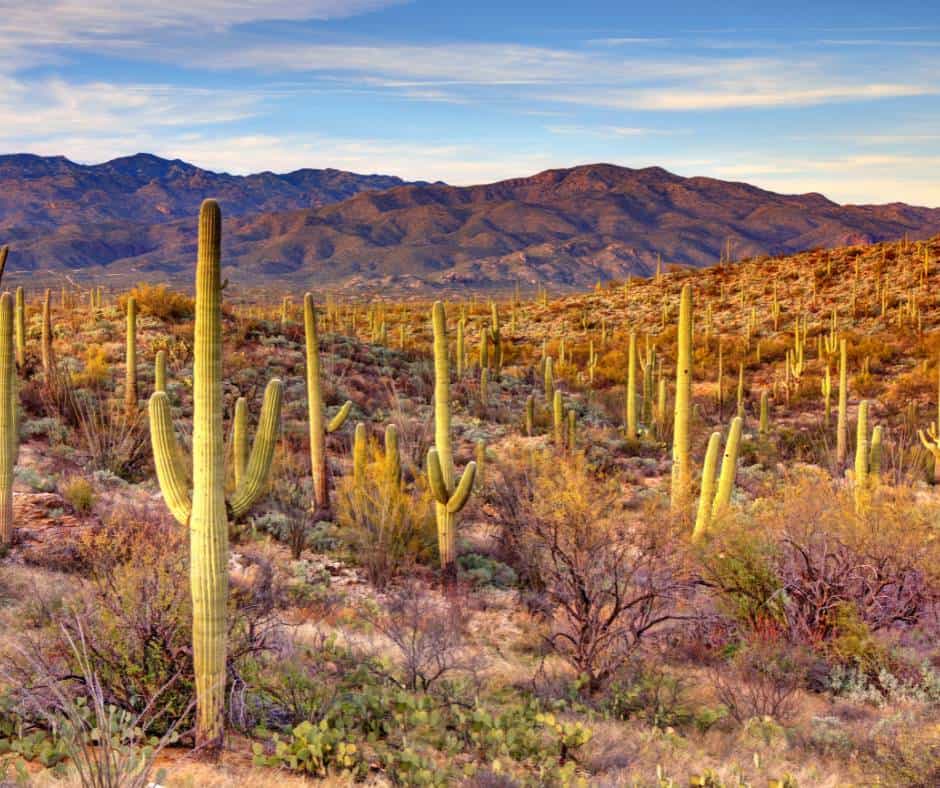
Distance from Downtown San Diego: 398 miles (Six hours)
Saguaro National Park is home to the mighty saguaro cactus, the largest cactus species in the United States. The park is divided into two districts by the city of Tucson, which sits in the middle. The Tucson Mountain District, aka Saguaro West, is closest to San Diego. The Rincon Mountain District, aka Saguaro East, is located on the eastern edge of Tucson.
Both sides of the park have visitors centers with exhibits and great information about current condidtions within the park. The also both have cactus gardens with labeled plants which are great for familiarizing yourself with the park’s flora.
The east side of the park is closer to neighborhoods and feels more suburban. There are often many locals out biking and walking the road, epsecially on weekends. The west side is much more rural and feels more remote.
One of the best things to do in Saguaro National Park during late fall, winter, and early spring is to go hiking. The park has more than 165 miles of hiking trails to explore- but be sure to bring plenty of water before heading out!
On the west side, down the road from the visitor center is the Desert Discovery Nature Trail. It’s only about half mile in length and is paved, so it is stroller and wheelchair friendly.
The Valley View Overlook Trail and the Signal Hill Trail are two easy and popular trails in Saguaro West as well. The Valley View Overlook trail is known for its lovely views, especially during the spring wildflower bloom while Signal Hill is known for both views and impressive petroglyphs.
In Saguaro East, the Mica View Loop Trail (3.7 miles) is an easy trail that is great for viewing wildflowers in the early spring. If you want to see a waterfall in the desert, head out on the Bridal Wreath Falls Trail which gains about 1,000 feet in elevation along the way.
If you are looking for scenic drives, check out the Bajada Loop Drive in the Tuscon Mountain District. It is dirt but graded and suitable for passenger vehicles. A portion of this route is one way.
In the Rincon Mountain District, Cactus Forest Drive is a one-way, paved loop road that leads visitors into the heart of the Saguaro forest and offers great views of the surrounding mountains. It is a total of eight miles in length.
Sequoia National Park

Distance from Downtown San Diego: 325 miles (5 1/2 hours)
Sequoia National Park is known for its namesake trees which are sure to make you feel like as small as an ant when you stand beside them.
One of the main attractions in Sequoia National Park is the General Sherman Tree, the largest known living single-stem tree on earth. Visitors can hike through the Giant Forest, which has more than 8,000 sequoia trees. The further you hike away from General Sherman, the fewer people you will encounter.
Beyond the impressive trees, this park is filled with great hiking and tremendous Sierra Nevada scenery. Don’t miss the trail to Tokopah Falls which follows the refreshingly cold Marble Fork of the Kaweah River. Black bears are commonly spotted in the area.
Another popular attraction is Moro Rock, a granite dome that offers sweeping views of the surrounding landscape. It is quite an adventure to climb the step carved into this granite monolith, and take in views of the treeless mountaintops along the Great Western Divide.
Sequoia National Park is also home to Crystal Cave, which is open for cave tours seasonally. The tours are popular, and it is recommended that you purchase tickets two months in advance of your visit. It is a 1/2-mile walk down the hill to the Crystal Cave entrance. Be sure to bring a sweatshirt because it is a constant 50 degrees inside the cave.
Kings Canyon National Park

Distance from Downtown San Diego: 340 miles (Six hours)
King Canyon is a national park that in many ways, feels like two distinct parks. It is home to Grant Grove, an impressive Sequoia Grove that is home to the General Grant tree, the second largest sequoia in the world and the Fallen Monarch, a fallen sequoia that is cool to walk through and explore.
The other portion of the park is accessed via a winding mountain road which ends in valley that gives Yosemite Valley a run for its money. It is certainly less crowded than Yosemite and has beautiful granite peaks and sprawling meadows to enjoy.
We especially love hiking the Zumwalt Meadow loop, stopping to see Sheep’s Creek Cascade, and playing in the Kings River on warm summer days.
Horseback riding is a fun way to enjoy Kings Canyon as well. Trail rides along the Kings River are offered at the Cedar Grove Pack Station.
Be sure to make a stop at Boyden Cave on your way to or from the valley. This marble cave is located deep in Kings Canyon and is open for tours.
Yosemite National Park
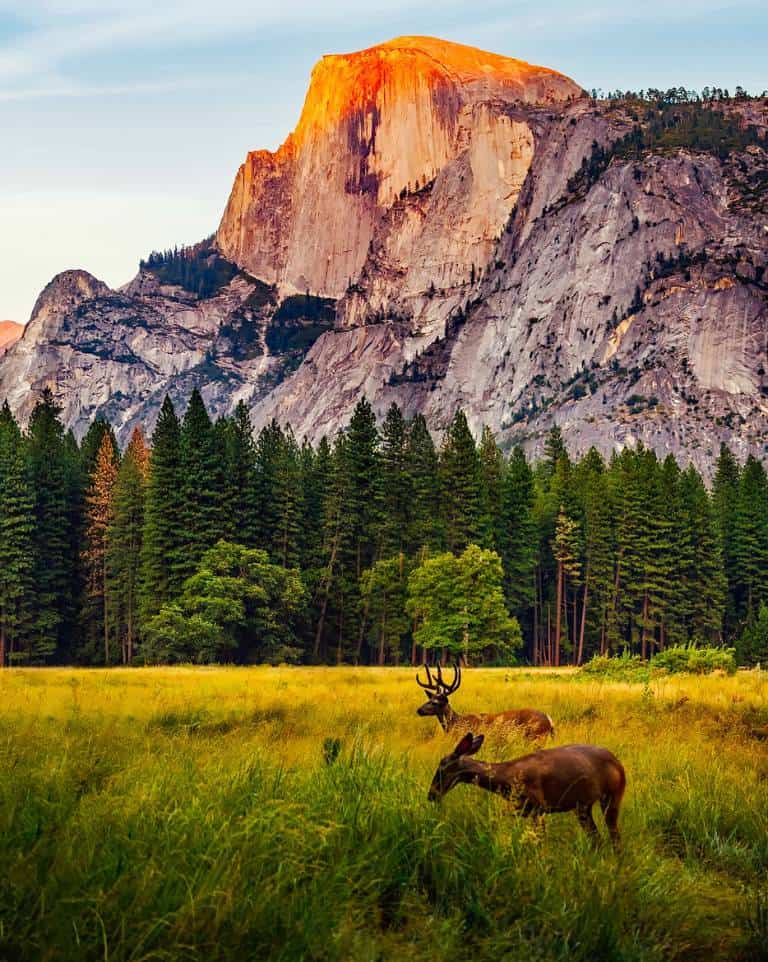
Distance from Downtown San Diego: 400 miles (Seven hours)
Yosemite National Park is the most popular park in California thanks to the magical Yosemite Valley which is home to towering waterfalls, remarkable granite features like Half Dome and El Capitan, abundant wildlife, and pristine meadows.
Read about all the animals in Yosemite you might encounter.
Beyond Yosemite Valley there is still so much more of this special park to discover. Yosemite is home to three Sequoia groves and plenty of high Sierra backcountry to explore. You will definitely want to make time to explore Tioga Pass and the enjoy the panoramic views at Glacier Point.
Given the size and scope of Yosemite, I suggest that you plan on spend at least two to three full days exploring the park. But, I also know that sometimes schedules won’t allow for that which is why I put together this Yosemite in One Day itinerary if you are short on time.
There are so many great day hikes in Yosemite National Park that you won’t want to miss. They include trails to gushing waterfalls, verdant green meadows, and crystal clear waterways. Here are the 16 best easy hikes in Yosemite National Park.
Pinnacles National Park
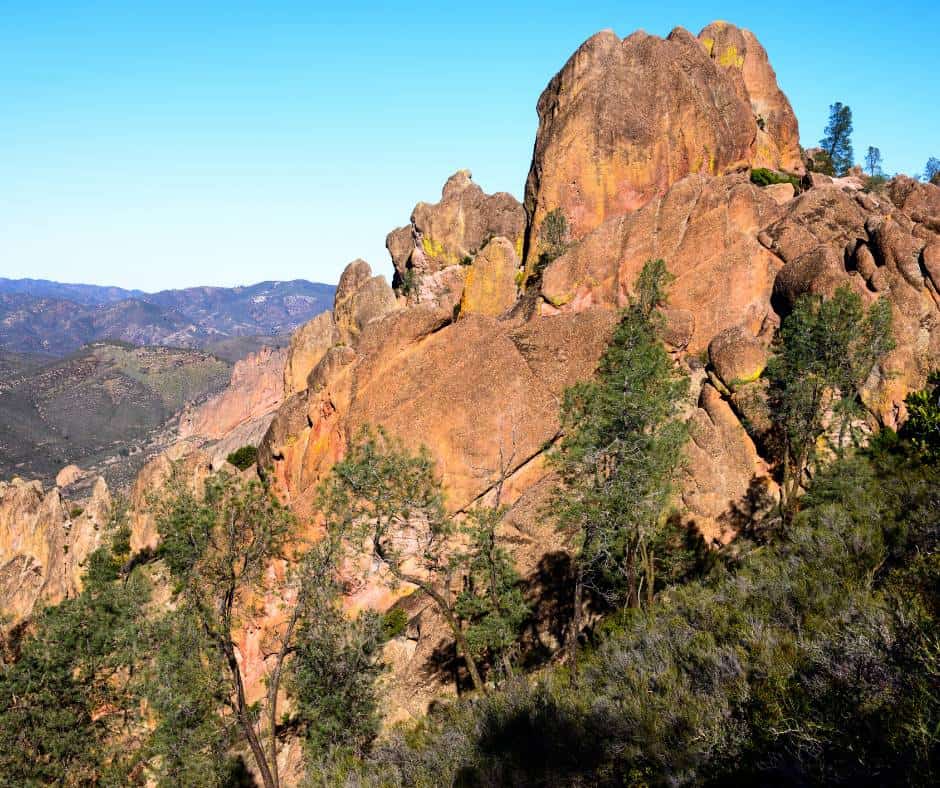
Distance from Downtown San Diego: 405 miles (Seven hours)
Pinnacles National Park is the newest national park in California, known for its famous for its caves, hikes, rock climbing, camping, and condors.
There are two sides of the park, the west and east entrance, and there is no road that goes through the park connecting the two. If you want to explore both sides you will have to go back to Hwy 101 and go around.
On the east side of the park, the Bear Gulch area is home to large talus caves that are formed by massive boulders. It is so much fun to scramble through on your way these caves (bring a flashlight or head lamp) up to Bear Gulch Reservoir. The caves are closed seasonally when bats are roosting, so check the park website before heading out.
If you are on the west side of the park, the 2.4-mile Balconies Cave loop is another cool talus cave to explore. As with the Bear Gulch Cave, flashlights or headlamps are necessary.
As you hike the hills of Pinnacles National Park, keep your eyes out for the rare California condor. There are only about 300 living in the wild so spotting one of these giant birds is quite a treat. Some climbing and hiking routes can be closed during nesting season.
]]>Here are some of the mammals that call this park home. Yosemite animals are varied, given the the park’s many landcapes and elevations. Some are certainly more common than others, but an animal sighting is always something to get excited about. Just be respectful and keep your distance.
In addition to the animals listed below, there are a wide variety of rodents such a mice, voles, woodrats, and gophers living inside the park.
Short on time? Here is your guide to one day in Yosemite.
Animals in Yosemite- 21 Mammals That Call the Park Home
Black Bear
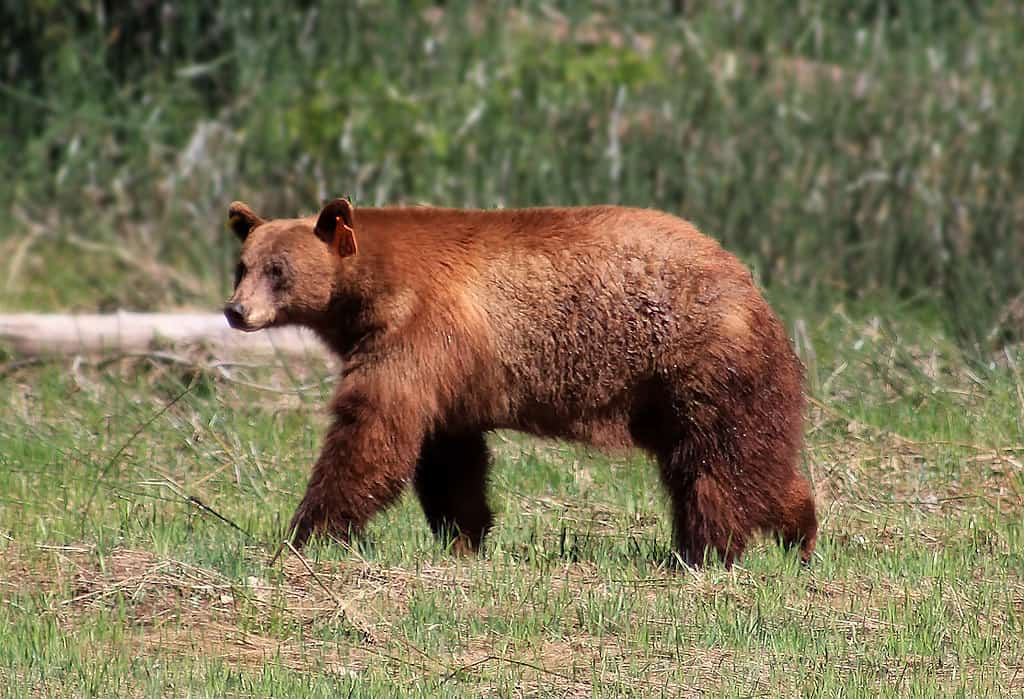
Where to Spot this Animal in Yosemite: I have seen black bears all throughout the park- in the Yosemite Valley, near High Country campgrounds, and in Sequoia Groves.
The animal that most folks come to Yosemite National Park hoping to see is the black bear. There are about 300-500 that live in the park. Keep in mind that the black bear species are not always black; many are brown, reddish brown, or even blond in color. If you see a bear in Yosemite, it’s a black bear as grizzly bears were eradicated from California in 1924.
Black bears are significantly smaller than grizzlies you may have seen in parks like Yellowstone or Glacier. Males tend to weigh around 250lbs and females about 150lbs. Bears in Yosemite tend to mostly eat grass or berries, but they do love snacking on acorns from the local oak trees during the fall.
Black bears do hibernate, and the hibernation season is dependent on weather. They typically hibernate through winter and come back out weighing 1/3 less in March or April. During this time females may also emerge from their dens with one to three cubs. The cubs are adorable, but be sure to never get between a mom and her cubs!
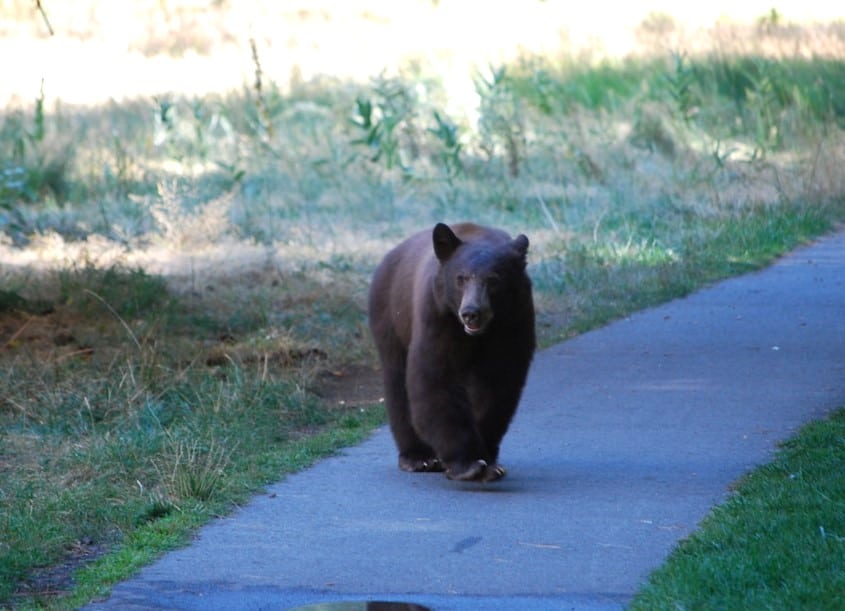
The bears in Yosemite are quite used to people, and nobody has ever been killed or seriously injured by a bear in Yosemite. Still, you want to give them plenty of distance. A good rule of thumb is to give them 50 yards of space.
Bears are known to invade campgrounds, break into cars, and raid unattended backpacks. You can avoid this by never leaving food in your car and using the metal bear boxes inside the park to store your food.
Here are the best easy hikes in Yosemite National Park.
Mule Deer

Where to Spot this Animal in Yosemite: You have a great chance of spotting mule deer along roads and in meadows of the Yosemite Valley. During the summer you may also spot them in the higher elevations, like in Tioga Meadow.
Did you know that more injuries in Yosemite are inflicted by mule deer than any other animals in Yosemite? These gentle looking animals may appear docile, but getting close to wildlife is never a good idea, especially during mating season.
Mule deer are the only deer species that call Yosemite home. They are known for their large ears and eat leaves, shurbs, berries, acorns, and grasses. These are large dear, typically measuring about four feet tall. Females are 150lbs, and males average around 200lbs.
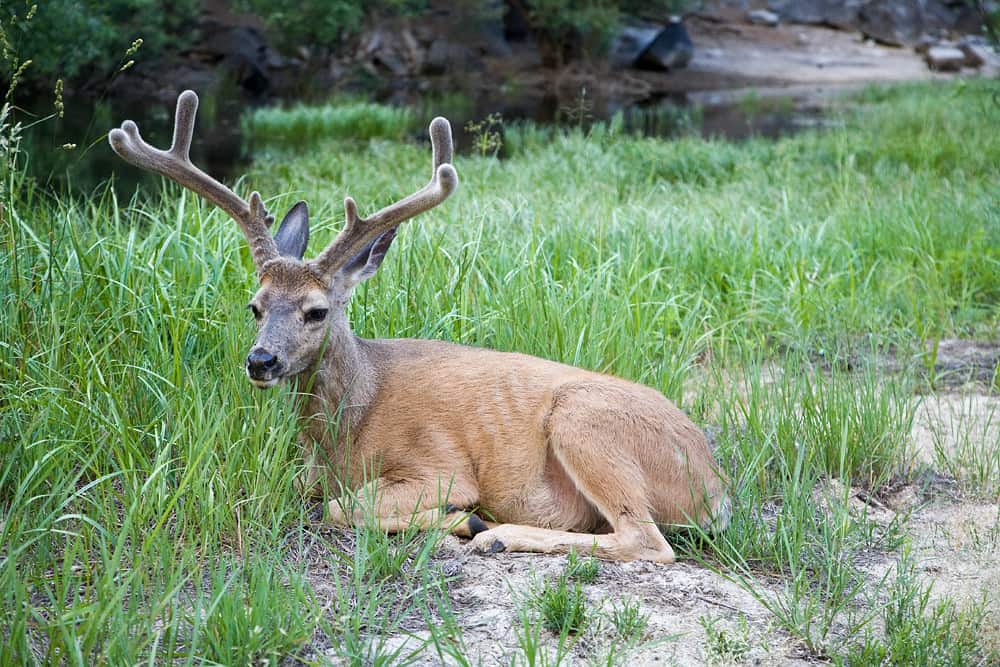
Only males grow antlers and they shed them annually in the winter after “rut” which is the time when they fight for mates. Fawns are born in the spring after a long, 200 day gestation period. They stay with their mothers until the fall.
Squirrel
Where to Spot this Animal in Yosemite: All over the park. Squirrel sightings are guaranteed.
There are several different squirrels that call Yosemite National Park. This is, by far, the most common animal you will see while exploring. They are especially common near parking lots, food establishments, and popular trails. Though they will beg, it is important not to feed the squirrels.
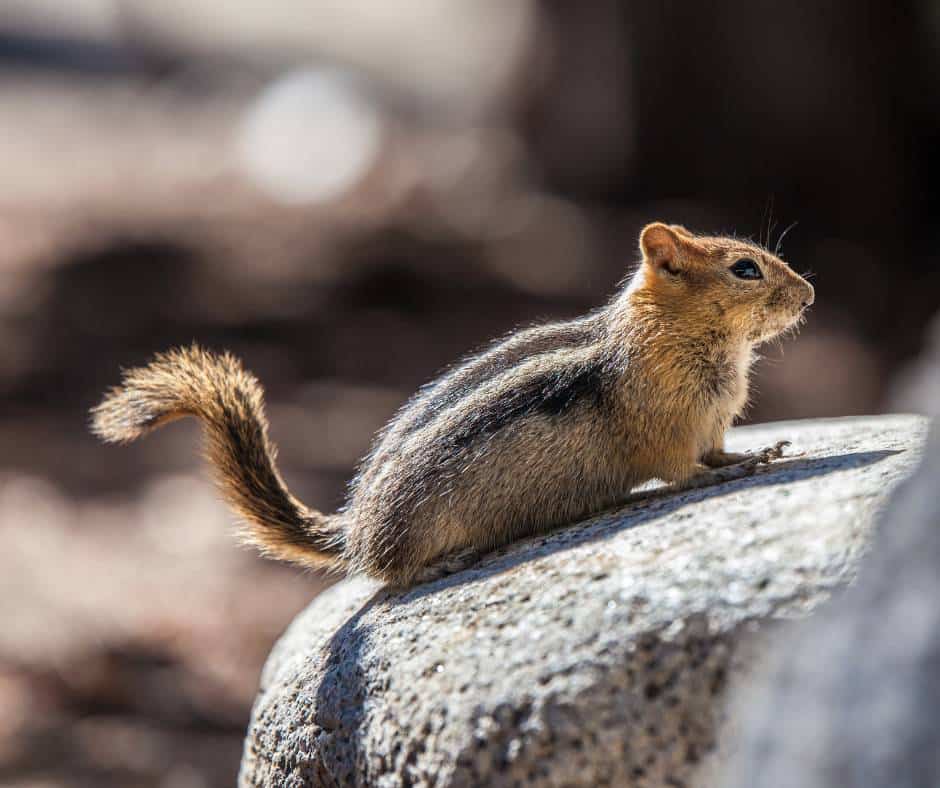
The golden-mantled ground squirrel is often mistaken for a chipmunk because of the distinct stripes on its back and its small size (adults weigh less than a pound). However, there are no chipmunks in California, so if you see anything resembling a chipmunk in the park, its a golden-mantled squirrel!
These ground squirrels hibernate during the winter so they spend much of the year building up fat storage. They can be quite the little beggars, but it is important for them to not gain a dependence on humans and remain wild, so please resist the urge to feed them.
They are found all over the park including on trails, in meadows, in rocky areas, and even in the higher elevation tundra.
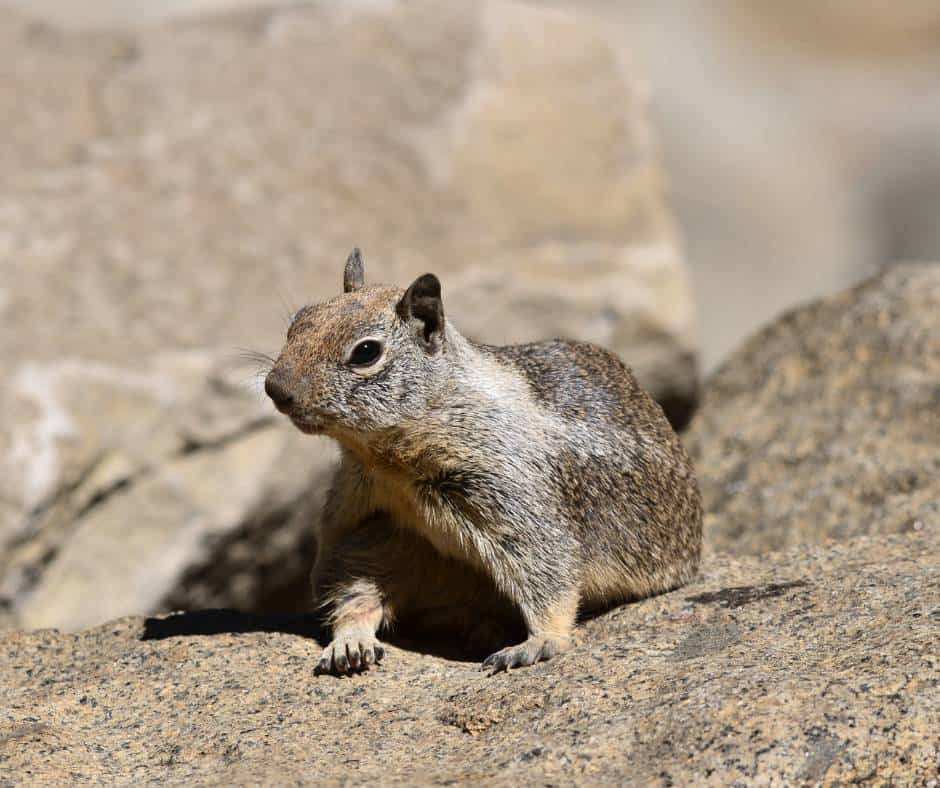
The California ground squirrel is the most commonly seen squirrel in Yosemite. As the name implies, it lives in burrows underground. It does hibernate during the winter and will certainly attempt to beg for food from park visitors.
These squirrels are mostly brown with mottled, light brown or white flecks.

The Western gray squirrel is know for its bushy gray tail. It is probably the squirrel species you are least likely to see since it spends nearly all of its time in trees and has a smaller population density in the Yosemite Valley than other varieties. It does stick to the lower elevations of the park.

The Douglas’s squirrel is a reddish tree squirrel that you will likely hear before you see. The squirrel has a distinct squeak. Its has darker brown fur with a distinct reddish-orange belly and light eye ring.
This squirrel lives in conifer trees like pine or fir because it loves to eat conifer seeds as well as the fungi that grow on the trees.
Listen to the sounds of the Douglas’s squirrel:
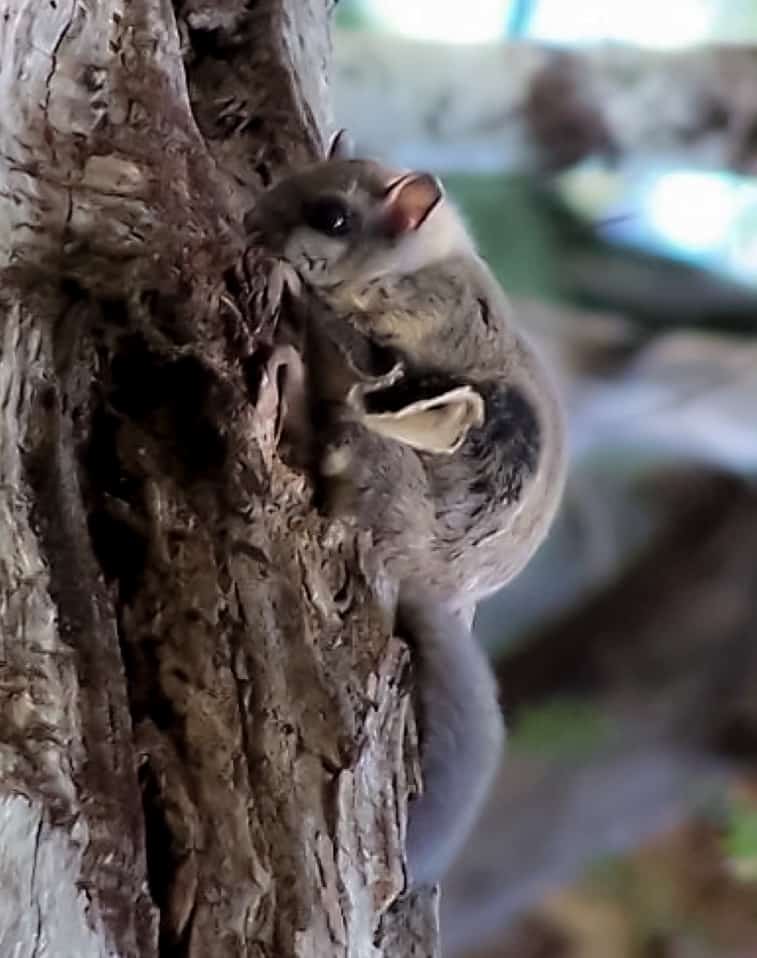
Humboldt’s flying squirrel, which is native to the West Coast, got its own species classification in 2017, due to its mitochondrial DNA being different from other North American flying squirrels.
This is a nocturnal species which uses the web of skin connectins its wrists and ankles to help it glide with ease from tree to tree. They can “fly” as much as 150 feet at a time. You are most likely to see them when light is shown into a tree and they are caught mid glide, looking like little shadows in the distance.
Coyote

Where to Spot this Animal in Yosemite: You are most likely to see coyotes hunting in the Yosemite Valley meadows during winter.
Many of us living in California are quite familiar with the coyote, and regularly see them living among us in both urban as well as rural areas. The coyotes that call my area of Orange County home tend to be much smallers and scrawnier than the beautiful mountain coyotes of Yosemite.
Living in a cooler climate and higher elevations has caused them to adapt with a thicker coat and a size closer to that of a wolf. Alas, wolves have not been spotted in Yosemite for over 100 years (except for one loan gray wolf passing through in 2021).
Coyotes head to lower elevations, like the Yosemite Valley, during the winter to hunt for prey like rodents and other small mammals. They listen for the sounds of these critters under the snow in meadows, and then pounce to snag a meal.
Skunk

Where to Spot this Animal in Yosemite: You are likely to see it in the Yosemite Valley or foothill regions of the park like Wawona.
The striped skunk is most commonly smelled before it is ever seen, but this adorable little animal is still seen rather commonly by Yosemite visitors, especially in the evening. Skunks are the size of a house cat and eat a variety of insects, worms, eggs, small amphibians and even small mice and voles. They will even forage on plants.
Skunks often don’t seem too concerned by the presence of humans, so it is best to give them a wide birth when encountered to avoid getting sprayed.
Spotted Skunk
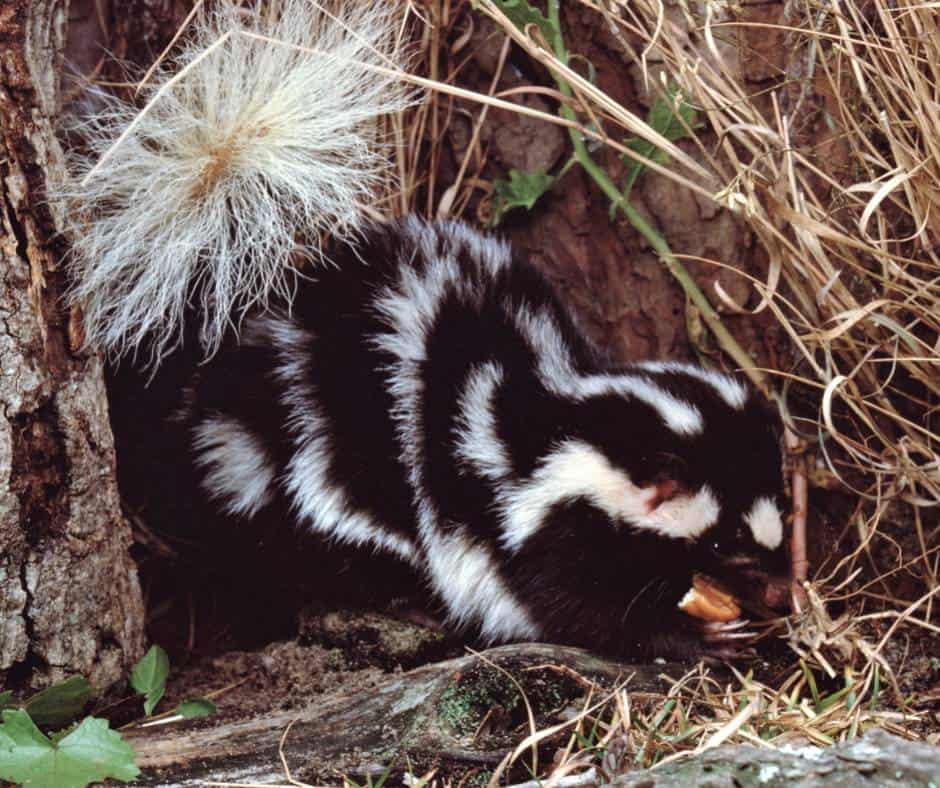
The spotted skunk is a far less commonly viewed species of skunk that also lives in Yosemite. It is most often seen in the lowest evelations of the park but does sometime make an appearace in the Yosemite Valley.
Spotted skunks are smaller than striped skunks, but they share their cousin’s nocturnal habits and food preferences. If they are threatened they have been know to stamp their feet and then stand on front feet and advance towards the threat in a handstand before spraying!
Grey Fox

Where to Spot this Animal in Yosemite: In lower elevations of the park, like Wawona. You might catch one with your car’s headlights in the lower parts of the park at night.
The gray fox is the most commonly spotted member of the canine family in Yosemite. It lives in the park’s lower elevations (including the Yosemite Valley at times), is quick, and is an excellent hunter.
They prefer to livein more shrubby areas where they can hunt their preferred prey, rodents and birds, easily. They are tree climbers and will eat some plants like berries, making them omivores. They are also known to scavenge garbage littered in the park.
Pika
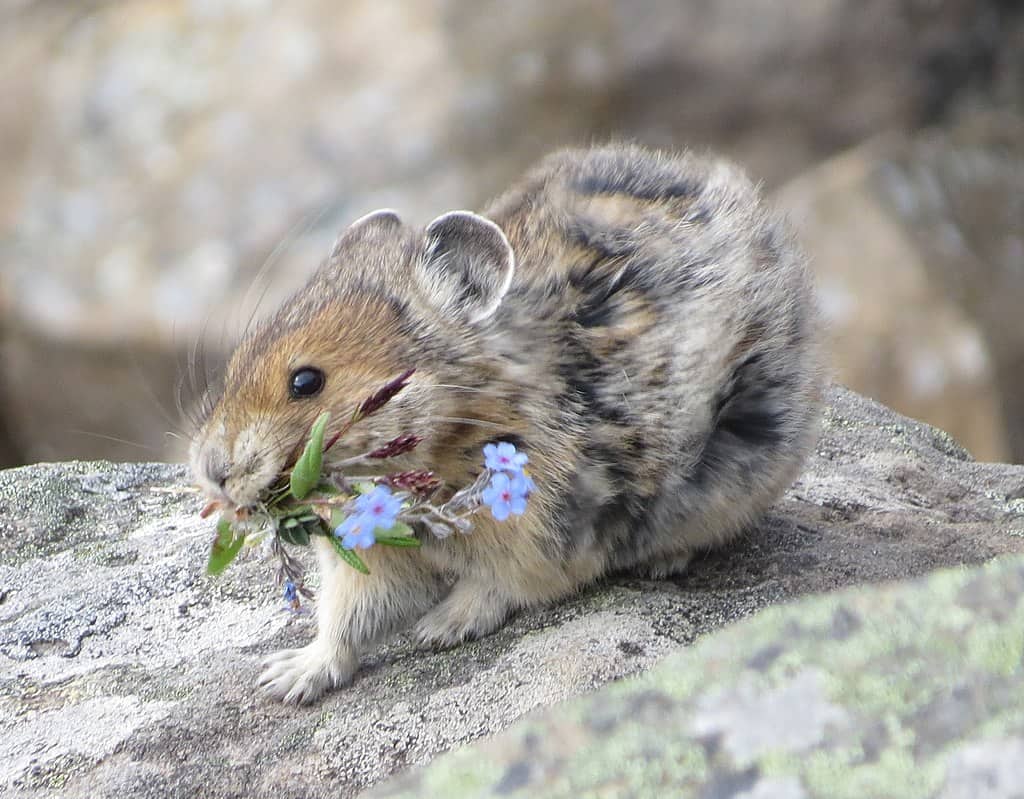
Where to Spot this Animal in Yosemite: Above the tree line in rock slides and rock outcrops. Check for them on the high portions of the trail to Mount Dana.
While the pika may look like a rodent in many ways, it is actually a lagomorph and closely related to rabbits. It is much smaller than a common rabbit, about a third of the size, and has much smaller ears and eyes. Still, it has rabbit-like fur and a similar jaw structure.
The rock rabbit, as it is sometimes called, is typically spotted by High Sierra hikers who know that if they remain quiet and patient near a rock slide ,then are likely to see them. They emit a loud, squeaking call and often sit atop a perch of boulders, squeaking away.
Pikas are experiencing shrinking territory due to global warming. Higher temperature in their high elevation home cause them to overheat. These days you won’t spot one below 9,500 feet.
Ringtail
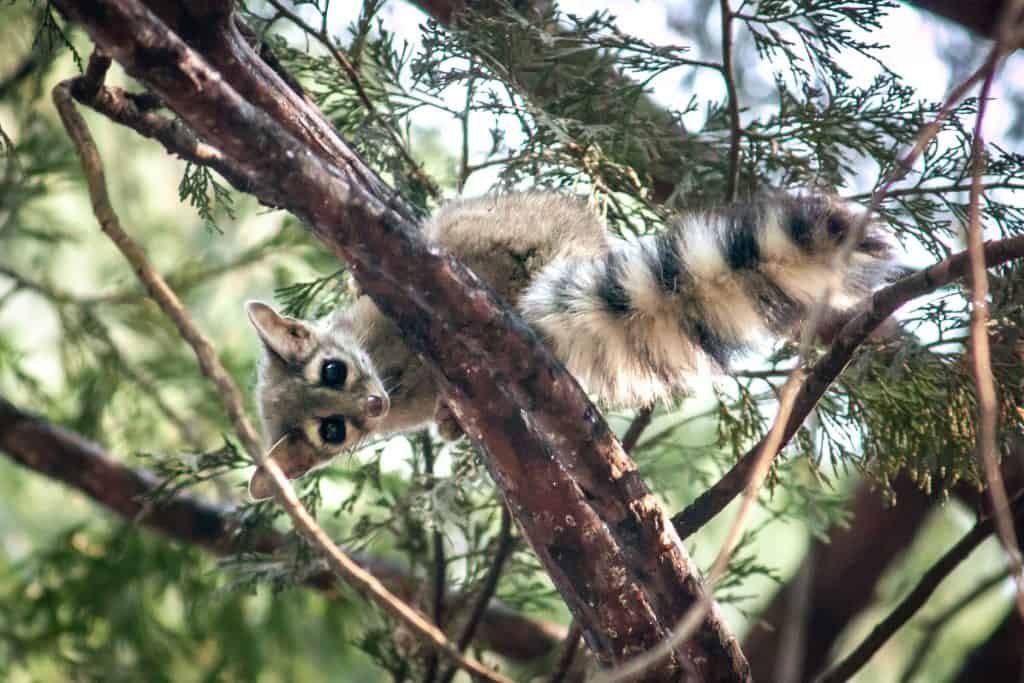
Where to Spot this Animal in Yosemite: Climbing around in a pine tree at night.
The ringtail is one of the most common animals in Yosemite that you may not see. This is because the ringtail is fully noctural. It looks part lemur, part raccoon, part fox, and part squirrel. It is most closely related to the raccooon, but is small like a squirrel.
The body is typically brown to brownish gray and as the name implies, it has a ringed tail. They are carnivores that primary eat rodents, though they will eat nuts and fruits as well. You are most likely see them while flashing a light into the trees in the evening.
Ringtails are known for getting into the attics of buildings inside the park in search of rodents, much like their raccoon cousins.
Raccoon

Where to Spot this Animal in Yosemite: The south entrance near Wawona and in the Yosemite Valley.
Raccoons are a species many suburban and rural residents are already familiar with. Those that live in Yosemite tend to do so in the lower portions of the park. Still, raccoons are far less common inside the park than ringtails.
They are being observed more and more in the Yosemite Valley these days, likely because of the presence of human food. Many visitors have reported that raccoons don’t seem particularly afraid of people and are willing to beg for food. Don’t give in to their adorable advances.
Here is a video of a raccoon hanging out on a balcony at Yosemite Valley Lodge.
Yellow Bellied Marmot
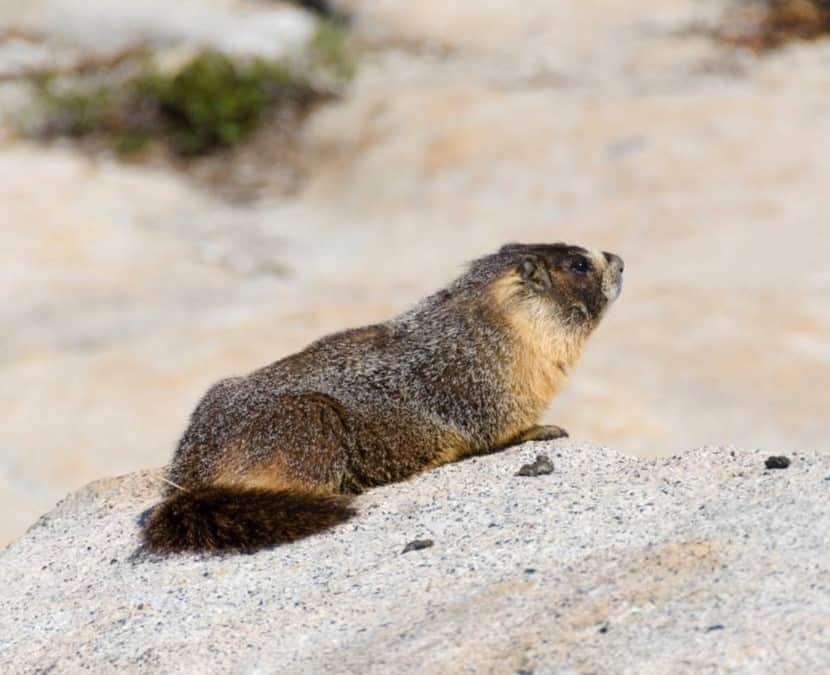
Where to Spot this Animal in Yosemite: In high elevations, sunning themselves on rocks. Check Olmstead Point, Mount Hoffman, or Gaylor Lakes off Tioga Road.
The largest rodent in park is the yellow-bellied marmot, a 5-11lb critter found bathing in the sunshine on rocks at higher elevations. Marmots hibernate for most of the year, staying in their burrows from September to May, so you will only see them in the summer.
Marmots eat plants, insects, and even bird eggs. They are usually quite alert, keeping an eye out for predators like eagles and then quickly darting to safety inside piles of rock. Yellow-bellied marmots let out a shrill whistle to alarm other marmots when they spot a threat and also defend their territory.
Bobcat
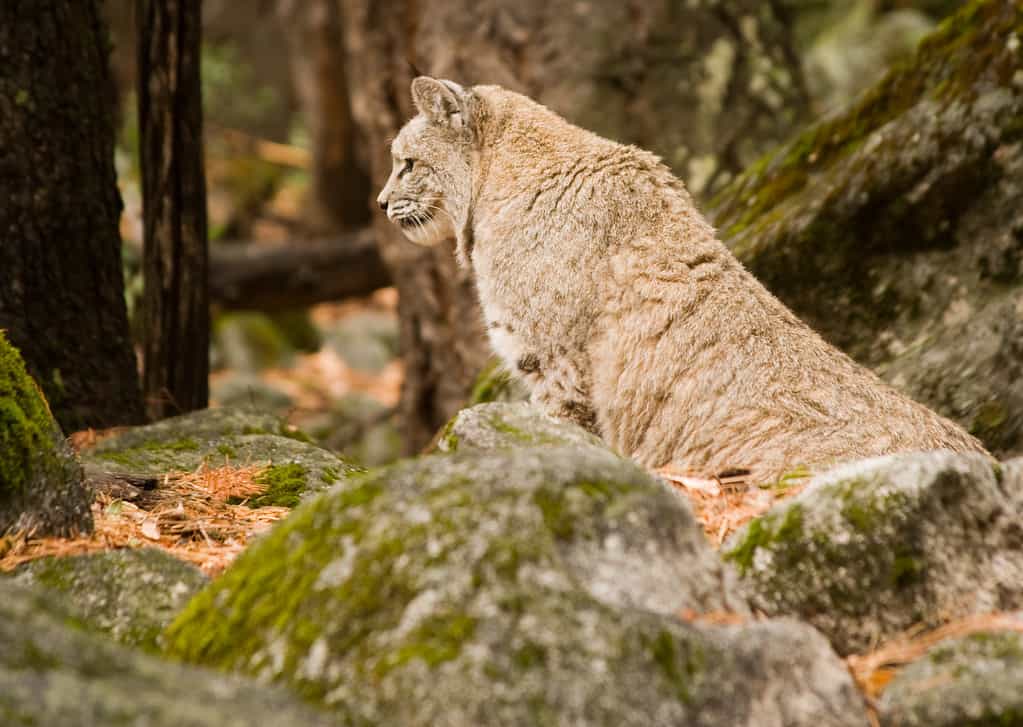
Where to Spot this Animal in Yosemite: In open meadows hunting rodents.
The bobcat is a small but agile cat living in Yosemite. Though they aren’t commonly spotted, they are seen far more often than their much larger counterpart, the mountain lion. I once saw one crossing a meadow near the Ahwahnee hotel.
Bobcats are typically two to three feet in length, tannish in color, and known for their distinctively short bobbed tails. I would compare a bobcat in size that of a large housecat like a Main Coon.
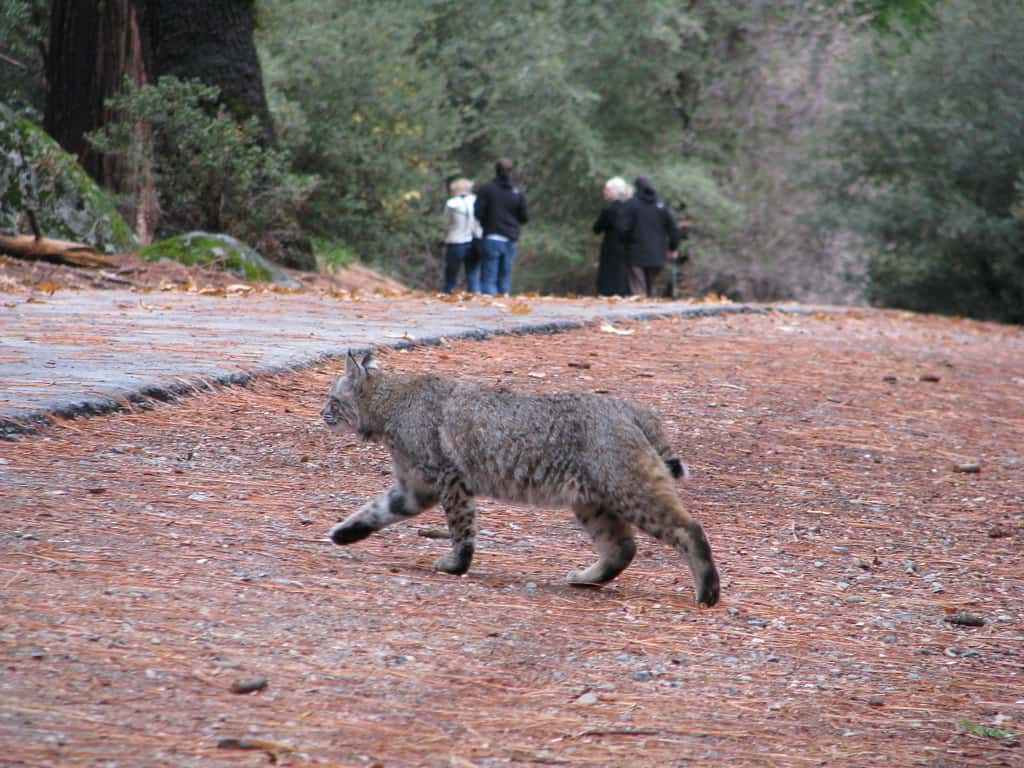
Bobcats can easily climb trees and will hunt in the daytime as well as at night. Like the coyote, them have been seen jumping and diving into the snow to catch rodents. They also like to eat birds and have even been known to occassionally attack deer in deep snow.
Want a guaranteed animal sighting? These are the best zoos in California.
Bats
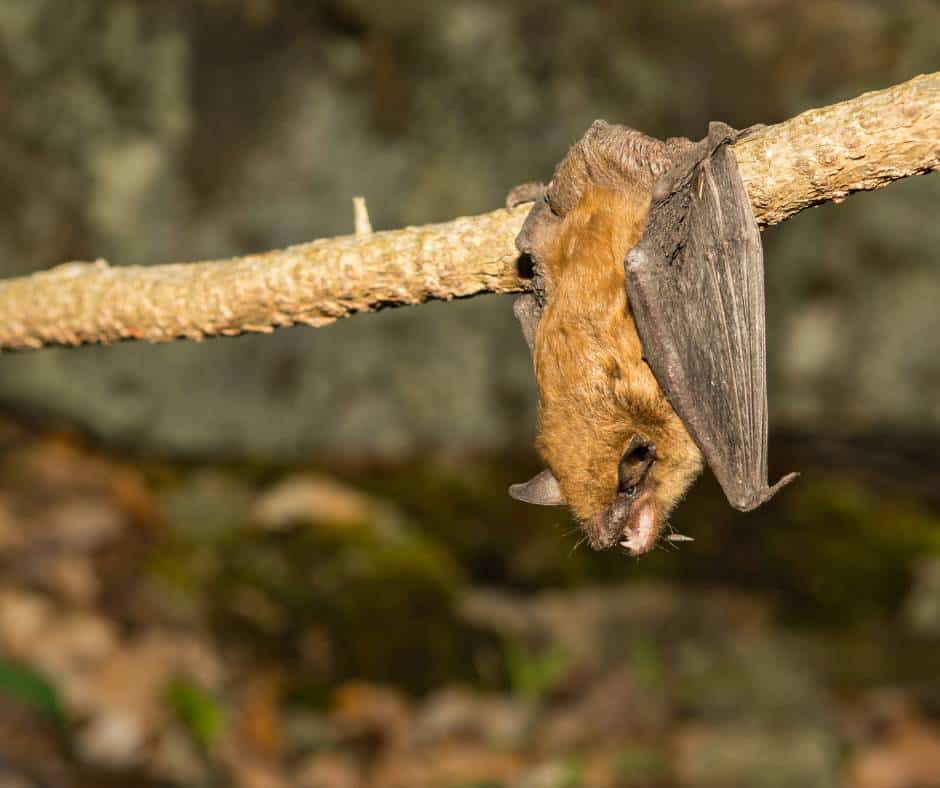
Where to Spot this Animal in Yosemite: In the night’s sky. If you see a “bird” flying in the evening sky, it is likely a bat, the only flying mammals.
Most Common Bat in Yosemite: Big brown bat
Yosemite National Park is home to 17 of the 25 species that exist in California. They are found all over the park, from the lowest elevations to summits above 10,000 feet.
Bats use echo location to find their prey, mainly insects, as they fly across the night sky. They can fly over 15 miles during their 6-7 hour evening hunt.
The largest bat species in North America, the Western mastif, calls Yosemite National Park home. It has a wingspan of 22 inches but is still incredibly light, weighing just over two ounces.
Mountain Lion
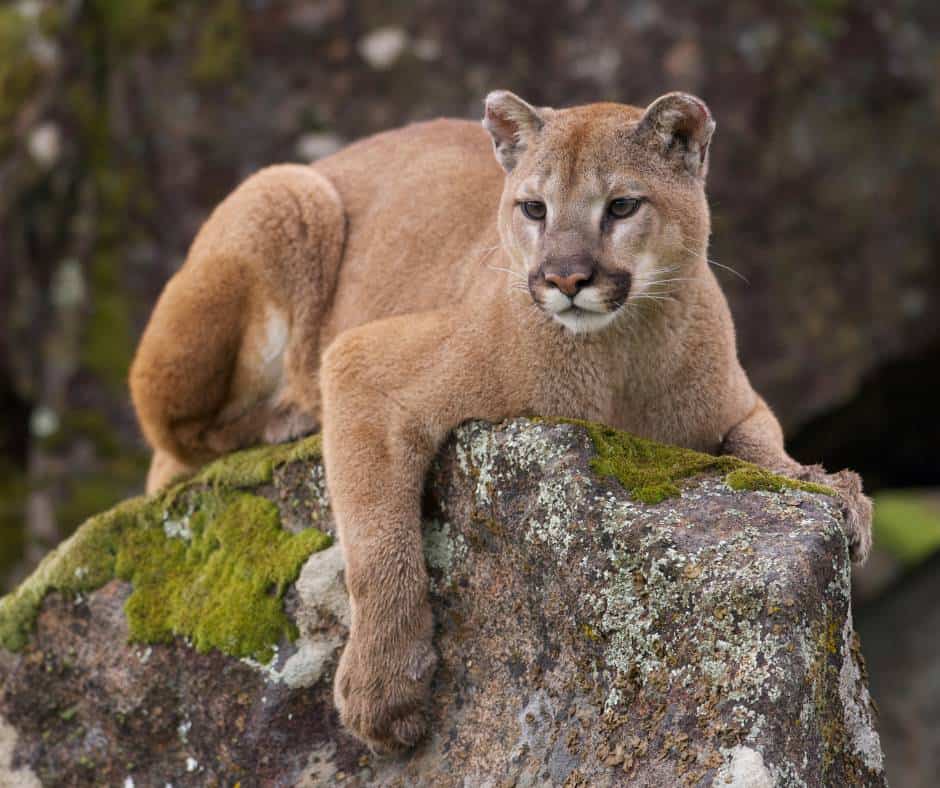
Where to Spot this Animal in Yosemite: Spottings are very rare, but these cats have been seen in the Yosemite Valley as well as the high country.
The mountain lion goes by several names- cougar, puma, panther- but no matter what you call it, this feline is most definitely the largest cat to call Yosemite and the rest of California home. Males are about 130-150lbs and females are much smaller at around 65-90lbs. Mountain lions eat small mammals and tend to hunt at night.
California mountain lions have not had an easy time over the past couple hundred years. Their population has been reduced by hunting and territory loss, but things do seem to be rebounding a bit in the park.
For several years, it was thought that maybe only a dozen cougars lived inside the park, but after an extensive study in 2019, the current number has been estimated to be around 35. Since Yosemite covers 1,169 square miles, that means there is only one mountain lion per 25 miles.
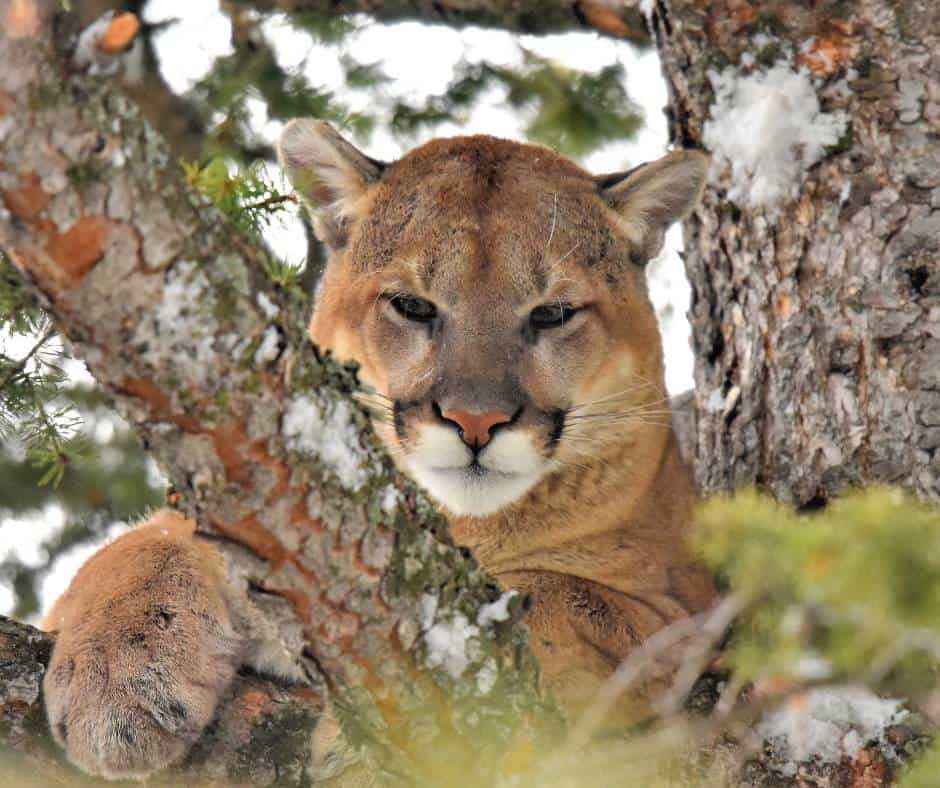
Your chances of ever encountering a mountain lion are quite slim. Still, the cats have been spotted all over the park, from the Yosemite Valley to the Grand Canyon of the Tuolumne River, a wildlife corridor where large mammals have been spotted regularly searching for food, shelter, and mates.
I live in mountain lion country and they have been spotted on the trails that run behind my neighborhood. Dozens of people walk these trails daily without incident. The reality is, a mountain lion is much more likely to see you than you are to see it, and it almost never wants anything to do with a human.
Regardless, if you ever do see a mountain lion DON’T RUN. This will just activate their prey drive. If one starts to approach you act big. Shout in a deep voice. Throw rocks and sticks and maintain eye contact. And remember than whenever you hike with small children you want to keep them close so they don’t get mistaken for prey.
Check out this amazing standoff between a pair of coyotes and a mountain lion near the Ahwahnee Hotel.
Sierra Nevada Bighorn Sheep
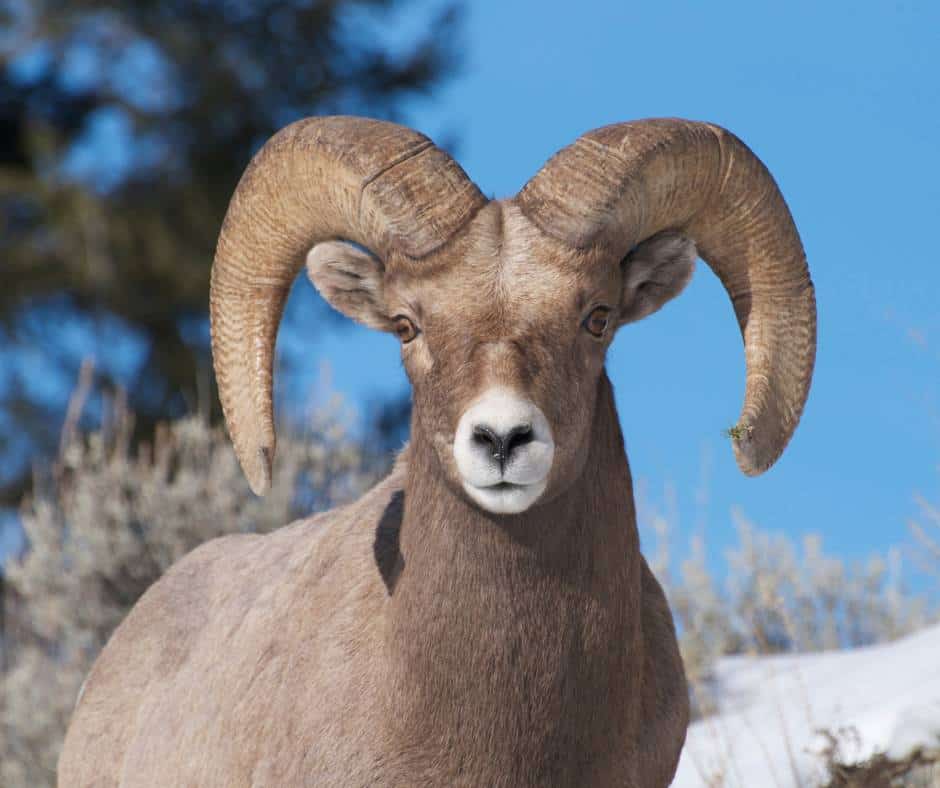
Where to Spot this Animal in Yosemite: Above the 10,000-foot level, mainly in the northeastern corner of the park.
The Sierra Nevada bighorn sheep are an example of a relocation success story. These agile animals went extinct within the park after the first two decades of its formal existence due to over hunting and diseases from domestic sheep brought in by Gold Rush settlers.
In 1986, a small population of just 27 animals were relocated inside the park after a 100 year absence. At first, it didn’t look like the sheep were thriving. But thanks to the Sierra Nevada Bighorn Sheep Recovery Program which was funded by the California legislature, there are now 600 sheep living in Yosemite’s Cathedral Range. They are aso often seen at Summit lake just outside of the park near Mono Pass.
Sierra Nevada Red Fox
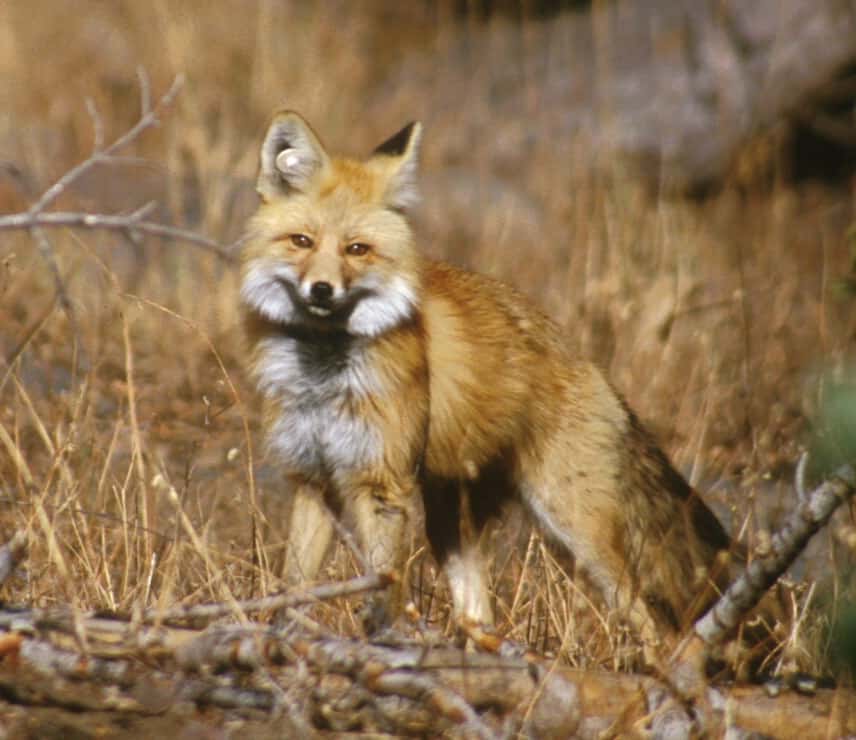
Where to Spot this Animal in Yosemite: You are very unlikely to see this animal, but they do prefer to live at about 6,000 feet in elevation.
After not being seen inside the park since 1916, a motion sensor camera detected the Sierra Nevada red fox inside the park in December 2014. There were thought to be only about 20 of these foxes in their historic range at that point.
This fox is the size of a small house cat, weighing only about eight pounds. It is an effective hunter of rodents, and the fox’s exceptional hearing allows it to hear rodents under the snow to hunt.
The Sierra Nevada red fox is another animal that was the victim of human intervention- as their soft, dense fur was coveted by fur trappers at the turn of the 20th century. Fur trapping has been illegal in California since the mid seventies and the species is endangered.
There have been at least 20 confirmed sightings within the park in the past several years, an encouraging development. If you are lucky enough to spot one, report your sighting online with photo documentation to the state’s wildlife officials.
Fisher
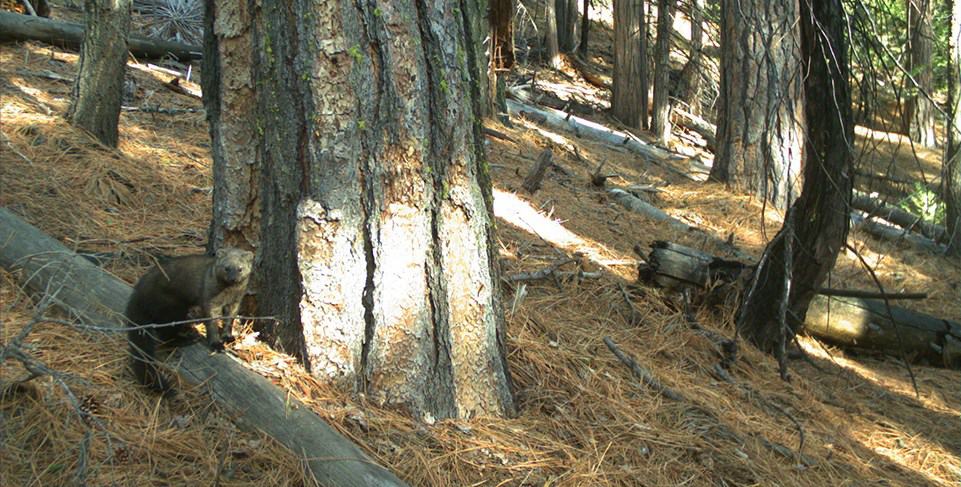
Where to Spot this Animal in Yosemite: Along the Merced River, closer to the southern reaches of the park.
The population of fishers that live in Yosemite National Park and the neighboring Sequoia National Forest is both small and isolated. There are about 200 of these cute critters in what is known as the “southern Sierra Nevada population”.
Just like the Sierra Nevada fox, fishers were victims of fur trappers, but they have also been victimized by habitat loss and logging. Unfortunately, the fishers do not currently have any federal protection, though they are considered a sensitive species by the U.S. Forest Service and the Bureau of Land Management.
Fishers are a member of the weasel family and despite their name, they don’t actually fish. They mainly eat rodents and birds, and are excellent climbers. They are technically omnivores and will eat nuts and berries as well. An adult fisher weighs 8-12 pounds and is three feet long.
Weasel

Where to Spot this Animal in Yosemite: It is possible to see them in the Yosemite Valley, as well as . The range is from the red fir forest up to the timberline.
Weasels are seen more often than one would think, in part because they are known from being fearless. There are both long-tailed and short-tailed weasels inside the park.
Long-tailed weasels are small in size, about the size of a squirrel, with a long tail that makes up half their body length. In the winter, they are primarily white except for the tip of its tail which is white. In the summer, they are mostly brown with lighter creamy yellow underparts.
The short-tailed weasel (also known as a stoat or ermine) is small as well. Only about nine inches in length with, you guessed it, a short tail. Their coloring is similar to the other species of weasel- white in the winter and brown atop and cream underneath in the winter.
Weasels hunt rodents and can do down into their burrows to snag them. They will also eat grasshoppers and frogs.
If you are looking for either of these creatures in the Yosemite Valley they have been known to be spotted near the Yosemite Museum, and the meadows near Swinging Bridge and Sentinel Bridge. The have also been spotted up high near Tioga pass.
Pine Marten
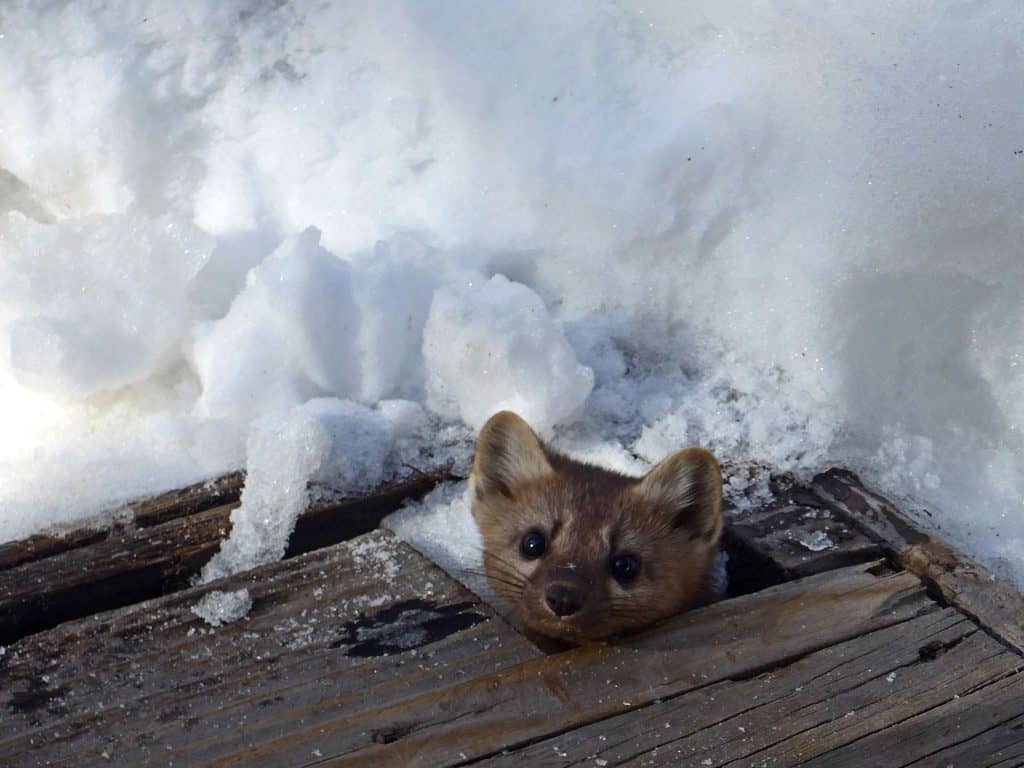
Where to Spot this Animal in Yosemite: Chances of spotting are rare, but they have been seen in Tuolumne Meadows.
Pine martens are another member of the weasel family that lives in Yosemite. It can live anywhere in the red fir belt up to the tree line, but is rarely spotted due to declining populations.
Pine martens are larger than the other weasels, but are still quite small. They weigh 2-3 pounds and are typically 1.5 – 2 feet long. They have a more fox-like face than the other weasels within Yosemite.
Pine martens love to eat voles, but they will eat variety of small rodents including tree squirrels thanks to their strong tree climbing skills. They will also birds when they can catch them.
Martens are active day or night, summer and winter. Though forest animals, they are found in Yosemite around high country rockslides and rocky meadows in summer. They eat small rodents and such birds as they can catch.
Unfortunately, pine martens are not protected by the Endangered Species Act but they are considered a is considered a “species of special concern” by the state of California.
California Badger
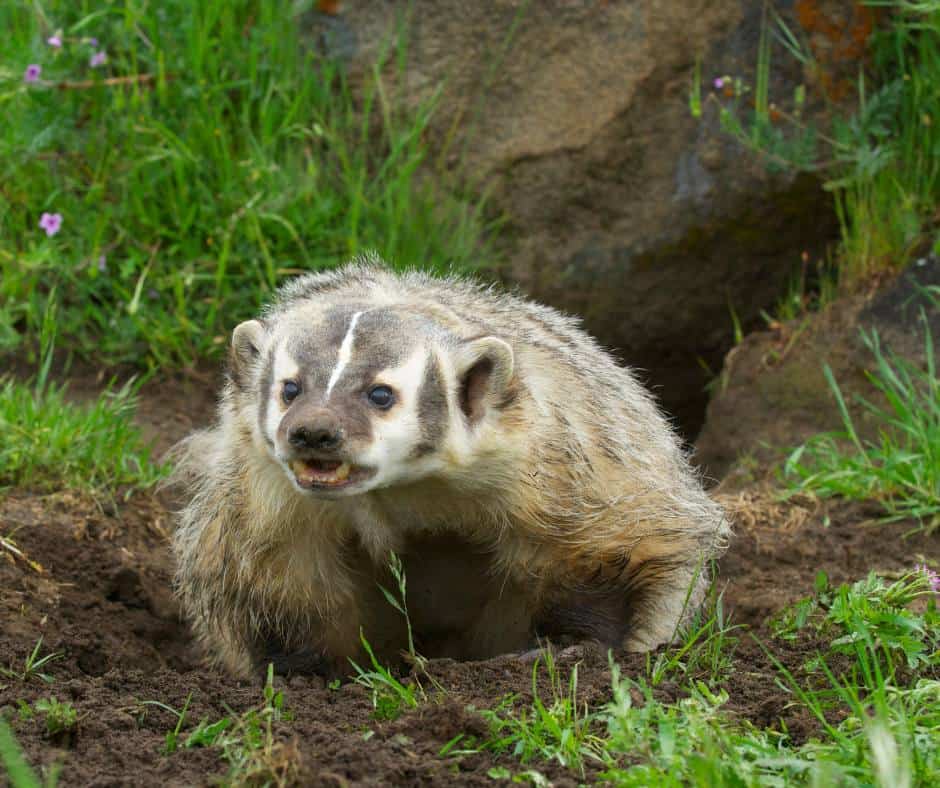
Where to Spot this Animal in Yosemite: Badgers are extremely rare to spot but are most likely found in the open areas of higher elevations. If you do see a badger, be sure to report it.
They look cute as they waddle along the ground but trust that badgers are ferocious predators, with strong claws and powerful jaws. Definitely steer clear if you happen to spot one.
Adult badgers are 2.5 feet loong and weigh about 20 pounds. They are primarily tan with a strong white streak along the center of their head and neck. They use their impressive claws to dig up ground squirrel nests and other rodent tunnels to catch their prey.
Fun Fact: Badger Pass Ski Resort, named for the California badger, is one of only three ski areas inside of a national park.
River Otter
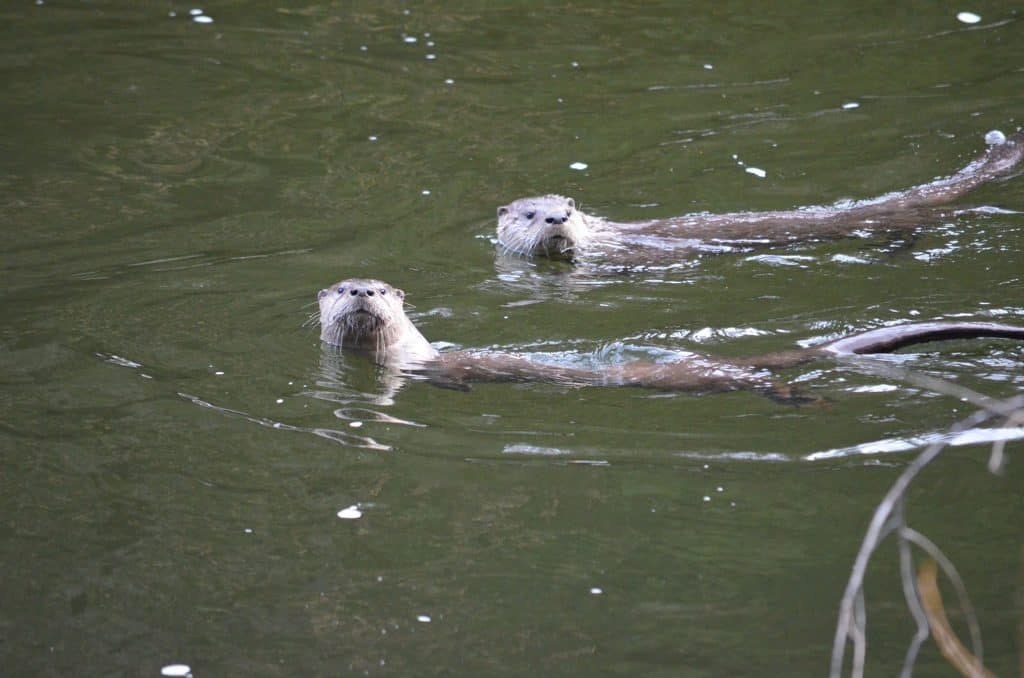
Where to Spot this Animal in Yosemite: In the Merced River both in the Yosemite Valley as well the more western portions of the park.
River otters are relatively recent residents of the Yosemite Valley. They were first seen in the Valley in the Merced River in 2014. There are some theories that they have moved up to these higher elevations because of the drought.
There are currently two known groups (a group of otters on land is a “romp”) known to move in and out of the Yosemite Valley along the river.
The California river otters are dark brown, 11 – 30 pounds, and about four feet in length. They primarily eat fish crayfish, and frogs. If you do see an otter, it will likely be in the water or along the shore.
Love otters? Here are the best places to see sea otters in California.
Beaver

Where to Spot this Animal in Yosemite: In the Merced River at Yosemite Valley, at Mirror Lake, and near Wawona.
There are not many beavers in the Yosemite, but there are a few. They tend to stick to the lower elevations of the park, as well as the Yosemite Valley. Beavers eat the bark of small trees like the cottonwood, and build dams and dens in the waterways.
There is a theory that the river otters have moved into the Yosemite Valley in part because of the beavers. Otters like to take over abandoned beaver lodges.
]]>Given all there is so see and do, it is no wonder that over 2.5 million people visit the park each year, most of them on a day trip to Joshua Tree from Los Angeles metro or Palm Springs.
I have made this trip several times and discovered that if I get an early start, there is quite a bit to do and see in one day. Here is how to make the most of your Joshua Tree day trip.
Joshua Tree made our list of 20 Amazing Weekend Getaways in Southern California. See what else made the list!
Your Complete Guide to a Joshua Tree Day Trip
When Should I Take My Joshua Tree Day Trip?
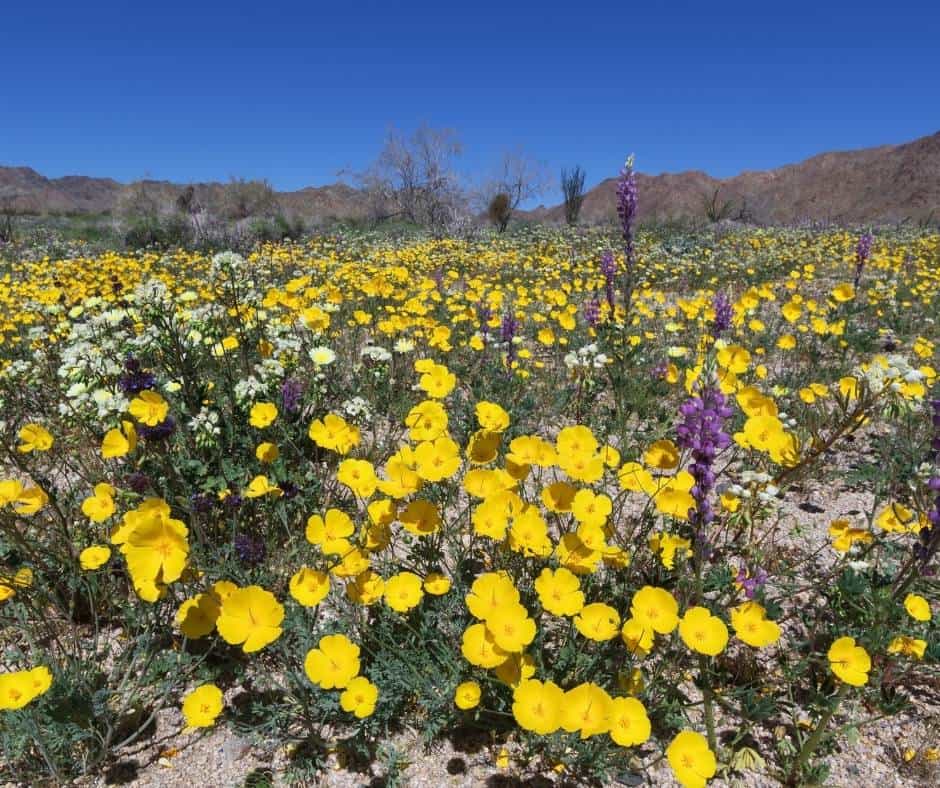
I consider Joshua Tree to be a three season park. I have visited in the winter, spring, and fall but the summer months are just too darn hot! There isn’t much shade in Joshua Tree National Park and trying to climb on the sun-backed rocks can result in some serious burns when temperatures soar above 100 degrees.
Visit in mid-October through mid-April for Joshua Tree National Park visit that allows you to enjoy all that wonderful hiking and bouldering without the oppressive heat.
In my opinion, the perfect time to enjoy a Joshua Tree day trip is a weekday in the spring after a rainy winter. If you are lucky enough to time things right, you will not believe just how much colorful Joshua Tree can be. Everything blooms with such urgency and exuberance.
Winter can actually be very chilly in Joshua Tree National Park, and snow is certainly possible. But, most days are cool and clear and wonderful for exploring.
Start Your Joshua Tree Day Trip Early
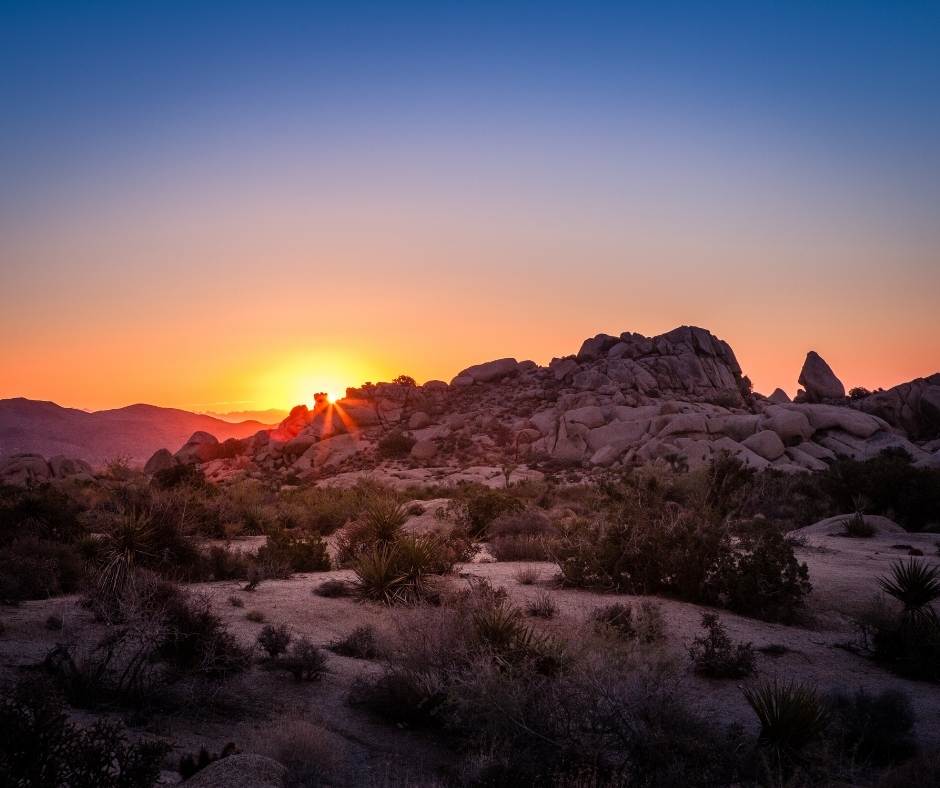
Those of us who live in Southern California know that planning our days around traffic is a way of life.
For this reason, I suggest you leave the LA area by 6am so you have plenty of time to enjoy the park and don’t spend your morning stuck in rush hour traffic. Joshua Tree is about 2 1/2 hours away from downtown LA.
If you are coming from Palm Springs, which is only an hour away, you can leave by 7am and still have plenty of time to make the most of your day in Joshua Tree.
San Diego and Las Vegas are also within a day trip’s drive from Joshua Tree. Given the park’s proximity to so many metropolitan areas, it is no wonder that Joshua Tree is one of the 10 most visited national parks in the United States.
If you want to enjoy sunrise in Joshua Tree National Park (and trust me, you do) to capture the best photos of Joshua Trees glistening in golden light framed with soft-colored boulders, check for sunrise times and leave your home base even earlier.
What Should I Bring on My Joshua Tree Day Trip?
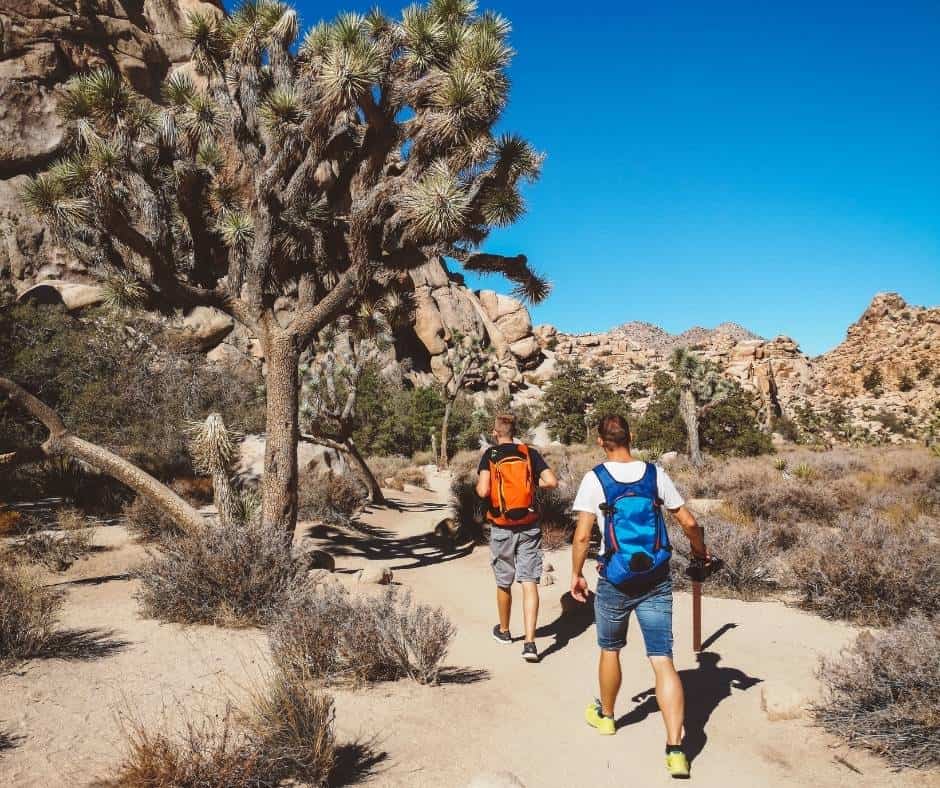
A car is essential for a Joshua Tree day trip because there is no public tranportation to the park or within the park.
Make sure that you have plenty of fuel in your tank before entering Joshua Tree National Park because there are no gas stations inside the park’s boundaries. There are gas stations along Hwy 62 in Yucca Valley where you can top off.
There are no food services within the park. I like to bring a cooler full of sandwiches, drinks, and snacks whenever I visit the park.
There are several spots with picnic tables inside the park. My favorite place to picnic is among the boulders at Hidden Valley.
When I visit Joshua Tree National Park I also like to bring along a daypack with sunscreen, a hat, plenty of water (plus refills in the car), and a first aid kit.
The weather in the high desert can have big temperature swings, so come prepared with layers and always check the weather report before you go. Sturdy footwear is also recommended, especially if you plan on hiking or climbing around in the boulders. Hiking shoes give you much better grip than tennis shoes.
Keep in mind that there is virtually no cell service inside the park, so print out you itinerary. You can always pick up a park map at the visitor center or print a map out before you head out.
Admission to Joshua Tree National Park is $15 per car. Your entrance fee gives you access to the park for seven days. You can purchase your admission ahead of time via Recreation.gov.
Which Joshua Tree Entrance Should I Use?

I avoid entering via west entrance to Joshua Tree National Park because a large portion of the day trippers coming from Los Angeles and Palm Springs use this entrance and the lines for entry can back up for a mile during the busy season.
I suggest entering the park at the north entrance in Twentynine Palms. The main visitor center (Oasis Visitor Center) and park headquarters are located at this park entrance so you can fill up your reusable water bottles, check out the visitor center exhibits, talk to park rangers, and use the restroom before heading out into the park.
You can also enter park via the Joshua Tree entrance but there is no visitor center at this entrance. This may or not may not matter to you. If it doesn’t, entering via Joshua Tree and exiting at the west entrance is another great strategy for a Joshua Tree day trip.
If you enter the park in the high desert and exit in the low desert, this will give you a chance to see a large portion of the park’s main attractions without backtracking.
10 Things to do on Your Joshua Tree Day Trip
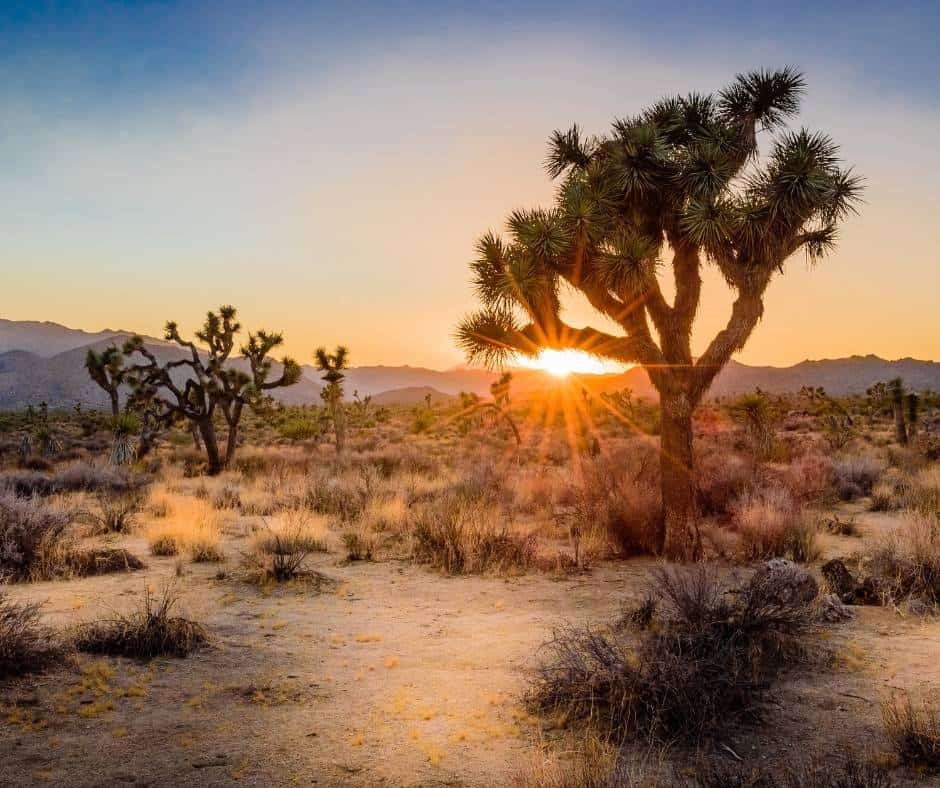
Joshua Tree is one of those parks where it is actually quite easy to hit all the major highlights in one day. Of course, we would all love to have multiple days to fully immerse ourselves in the national parks, but sometimes that just isn’t possible.
Here are 10 things I have done in a day trip to Joshua Tree National Park. Unless you are a really fast hiker, you may have to pick and choose between all the hikes I mention, but most are short so it is possible to do most of them in a single day.
Remember part of the joy of Joshua Tree National Park is enjoying the views on your scenic drive through the park. It is also important to take time climb the boulders. They make for a natural playground that simply can’t be resisted!
1. Start Your Day With a Hike

The Oasis of Mara is located next to the Oasis Visitor Center. There is a short, paved, nature trail (0.6 miles) which loops around the oasis and is a nice place to stretch your legs after your drive.
Another great early morning hike option is the scenic hike to 49 Palm Oasis. This hike is found on a spur road off Highway 62 in between the Joshua Tree and Twentynine Palms entrances.
This hike gains 620 feet in elevation while making its way through classic high desert scenery to the palm oasis about 1.5 miles form the trailhead. There are plenty of boulders to scramble on along the way.
2. Stop at Skull Rock
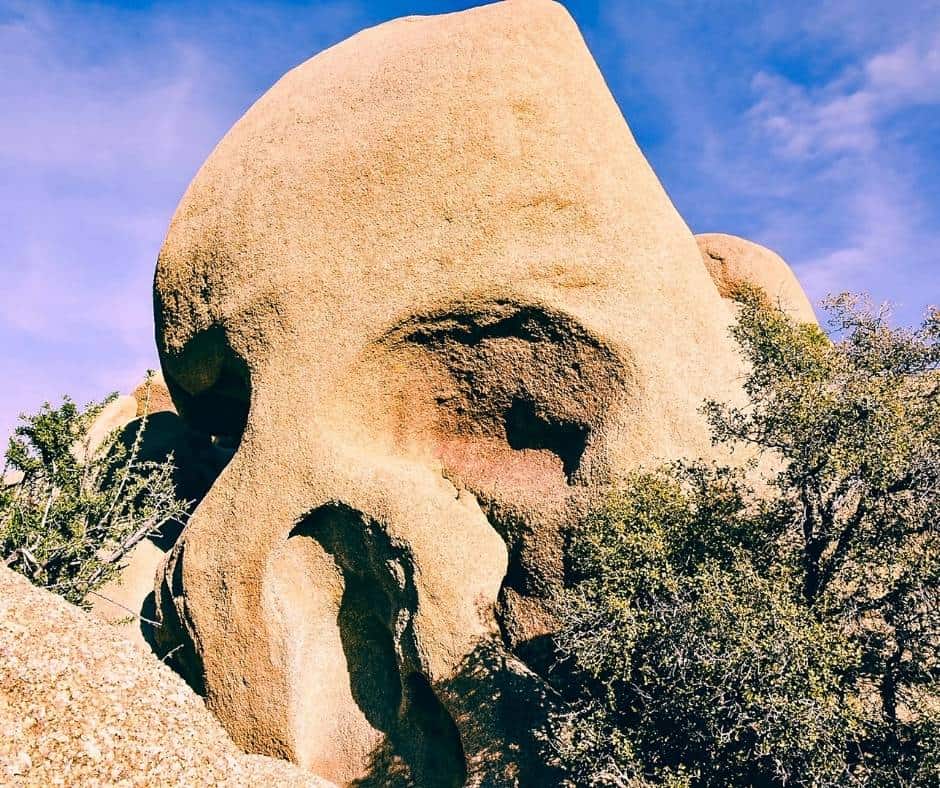
Skull Rock is a massive boulder off Park Boulevard that really does look like a skull! Park alongside the road and enjoy scrambling and exploring the piles of boulders in this area.
There is a 1.7-mile trail from the Jumbo Rocks campground, but I think it is far more fun to just climb on the rocks and create my own trail through the boulders. Just pay attention to your surroundings so you don’t get lost!
3. Go Bouldering in Hidden Valley
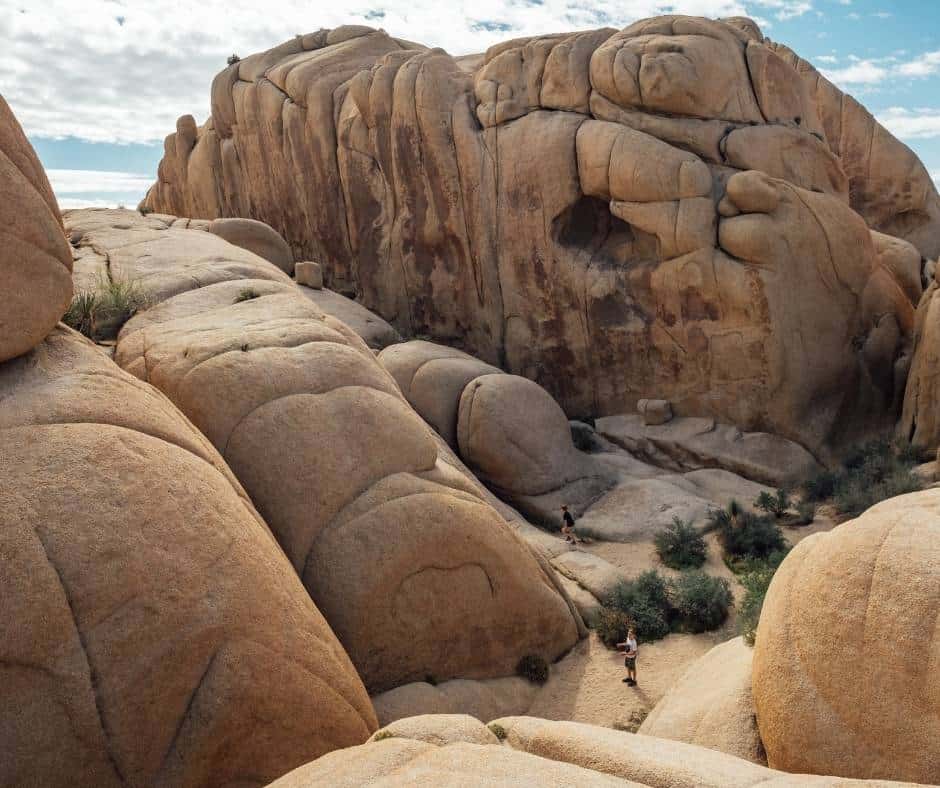
Hidden Valley is another great spot to climb and scramble over massive boulders. There is a nice 1-mile loop trail which circles around the Hidden Valley area, but you will likely be tempted to wander among the boulders instead of staying on the trail.
Just be careful and make sure you know how to get out of any of the spaces you climb into (speaking from experience with my son).
Hidden Valley has several picnic tables near the parking lot, making it a great spot to stop for lunch. There are also bathrooms.
4. Climb Ryan Mountain
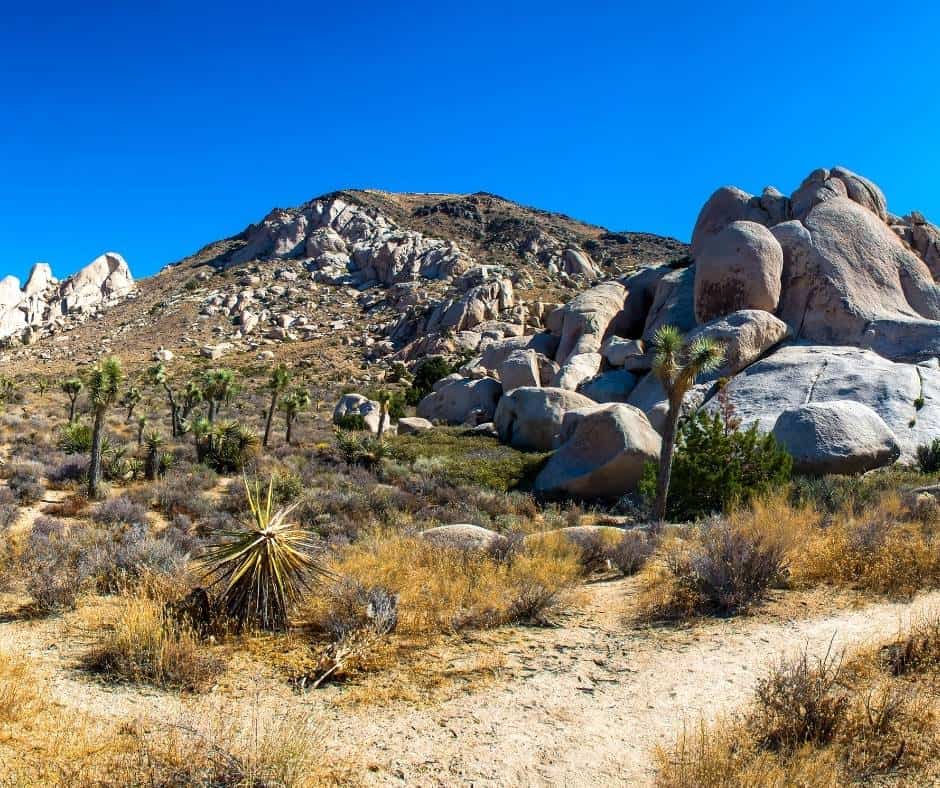
If you are looking for a hike that will get you huffing and puffing and reward you with amazing views at the top, head up to the top of Ryan Mountain’s 5,461 summit.
This popular hike gains 1,000 feet in 1.5 miles. Once at the top, you will be able to take in 360 degree views of the desert. If you are adding this hike to your Joshua Tree day trip itinerary, I suggest doing it when temperatures are cooler, either early or late in the day.
5. Visit Barker Dam

Water comes at a premium in the desert so it is no surprise that the local bighorn sheep use Barker Dam as a watering hole.
Barker Dam is accessed via an easy, 1.1-mile loop trail. There are plenty of boulders to scramble on along the way, as well as some interesting prehistoric rock art. Remember- look but don’t touch!
6. Tour Keys Ranch
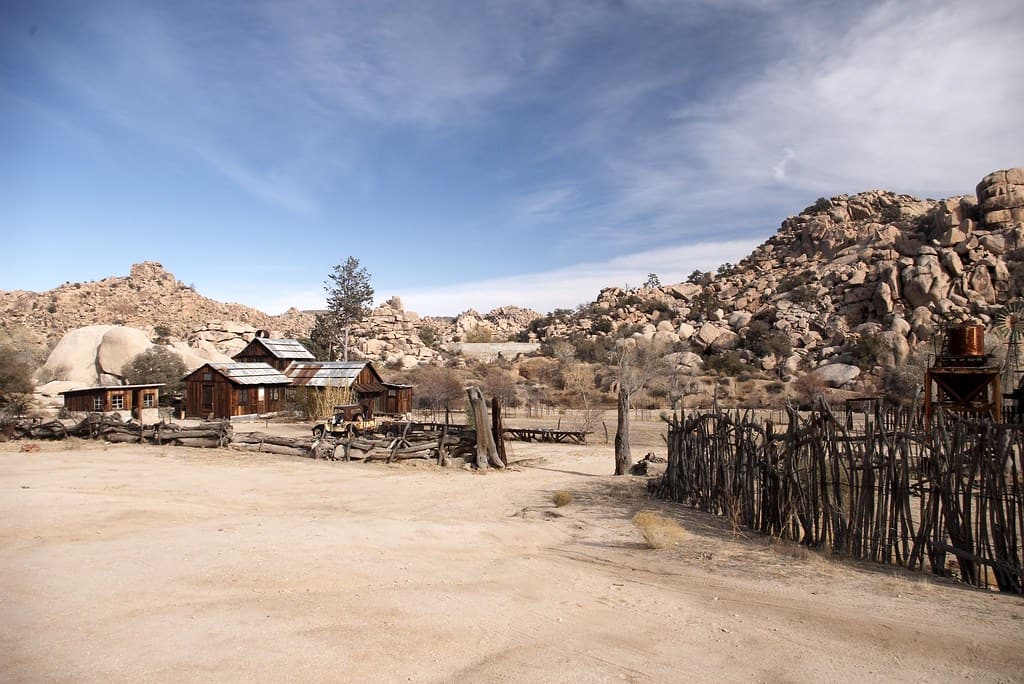
Ranger-led tours are great ways to learn about the history or national park. The Keys Ranch Tour is no exception.
This 90-minute guided walking tour takes visitors to the former homestead of Bill and Frances Keys, one of the hearty families that called this part of the country home long before it became a national park.
The homestead includes a ranch house, schoolhouse, and store, as well as several artifacts still at the ranch. It is fascinating to learn about what it took to live in such a remote and harsh environment long before the days of air conditioning and wifi.
You can only buy tickets at the Oasis Visitor Center in Twentynine Palms, beginning at 8:30am each day. Tours are limited to 25 people and do sell out.
The cost is $10 for adults and children 12 and older, $5 for seniors, $5 for children 6 to 11, and free for 5 and under. Visit the park’s calendar page for tour times.
7. Drive Up to Keys View
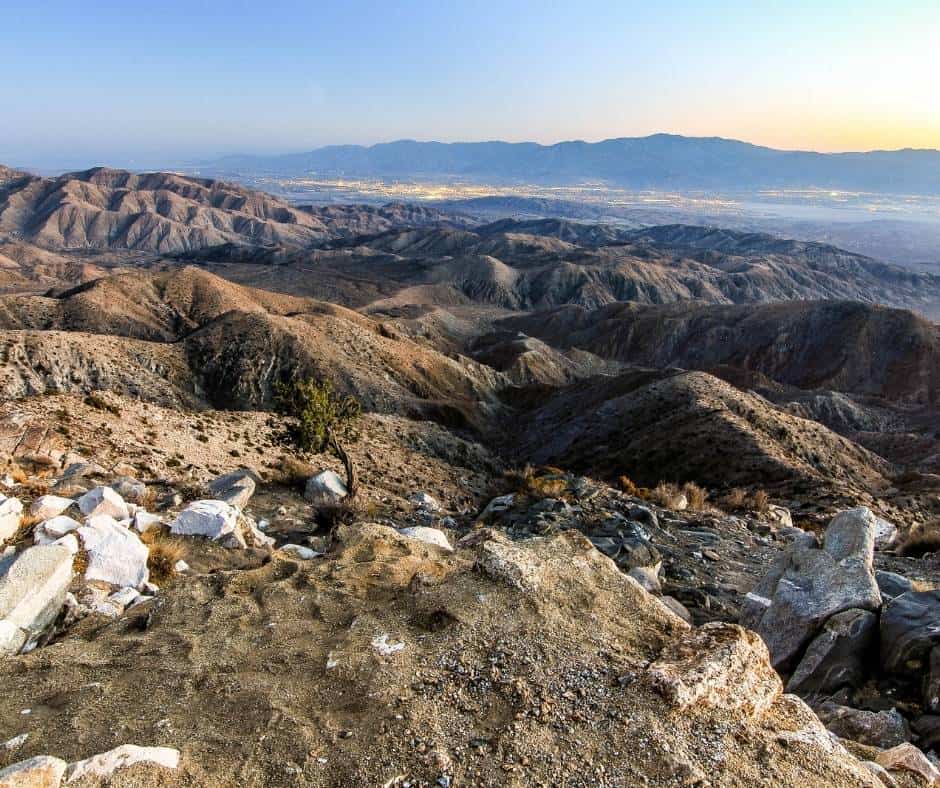
One of the most popular things to do on a Joshua Tree Day Trip is drive up to Keys View and take in the sprawling views of the Coachella Valley, Mt. San Jacinto, Mt. San Gorgonio, the Salton Sea, and even the San Andreas Fault. Rumor has it that on clear days you can see all the way to Mexico but I have never been that lucky.
Keys View sits at 5,000 feet above sea level on the crest of the Little San Bernardino Mountains. You can basically park right at the viewpoint so this can be a quick pit stop.
8. Climb Arch Rock
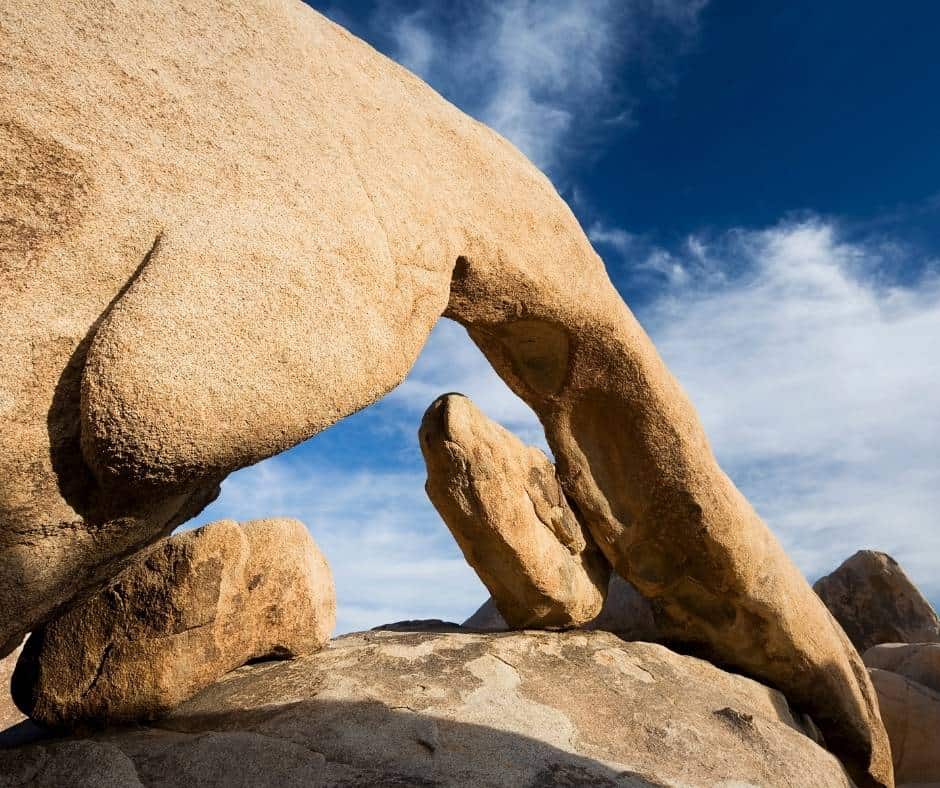
As you start to make your way towards the low desert potion of the park, make time to stop at (and climb) Arch Rock. Unlike the arches formed by erosion that are common in Utah, this arch was created by lava pushed up through a fault line!
The trail to Arch Rock is flat, easy (provided you aren’t hiking in the heat!), and only 1.2 miles in length round trip.
Note: Arch Rock is a popular spot for photos so will likely have to wait your turn to get that perfect shot.
9. Look But Don’t Touch at the Cholla Cactus Garden
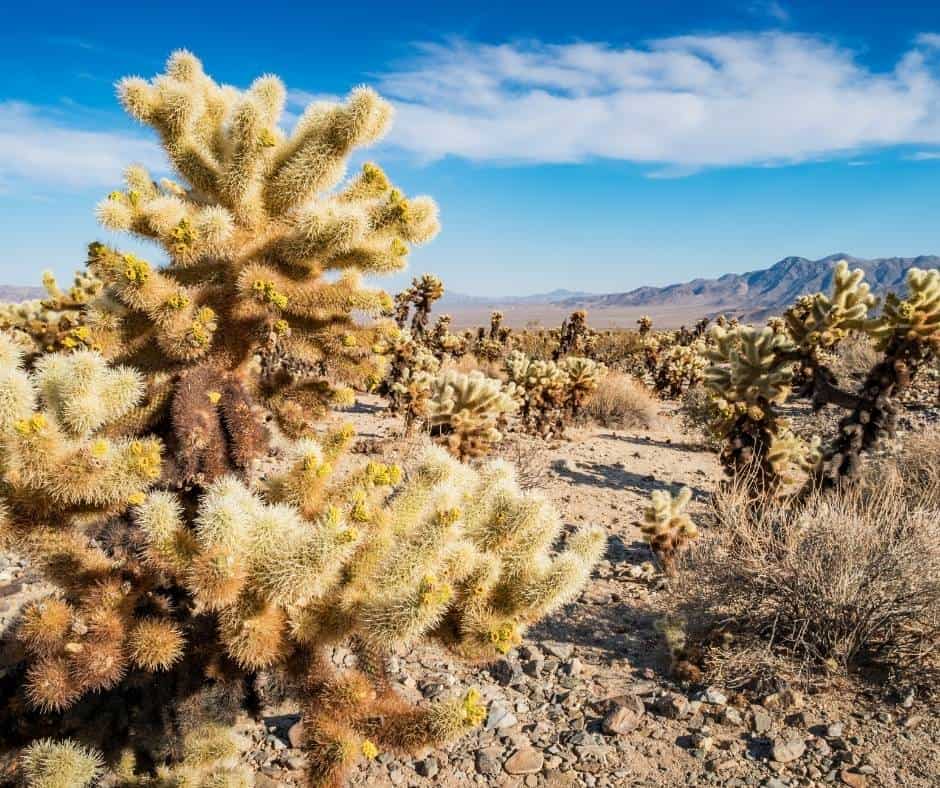
Located near where the high desert and low desert converge, the Cholla Cactus Garden is home to a large parch of cactus that look cuddly- but resist your urges to touch!
In actuality. the “Teddy Bear Cactus” has needles that will attach to anything that touches them using curved barbs on their tips. They attach quite easily, giving them the nickname of “jumping cholla” because some people swear that needles jump right off the cacti (psst… they don’t).
There is short, .25-mile trail that meanders through the patch. It is quite photogenic during sunrise and sunset.
10. Admire the Ocotillos at Ocotillo Patch
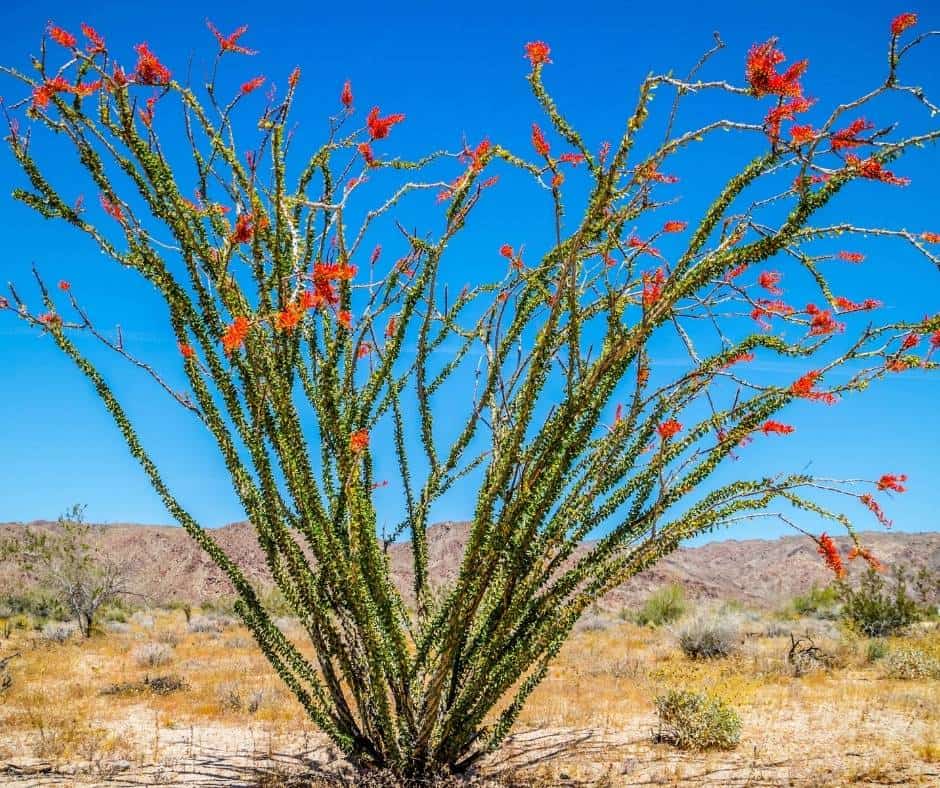
A short drive from the Cholla Cactus Garden is the Ocotillo Patch, an impressive collection of these tall and elegant desert plants. The ocotillos are particularly beautiful in the spring when they are adorned with red-orange blossoms.
Experience the Milky Way on Your Joshua Tree Day Trip
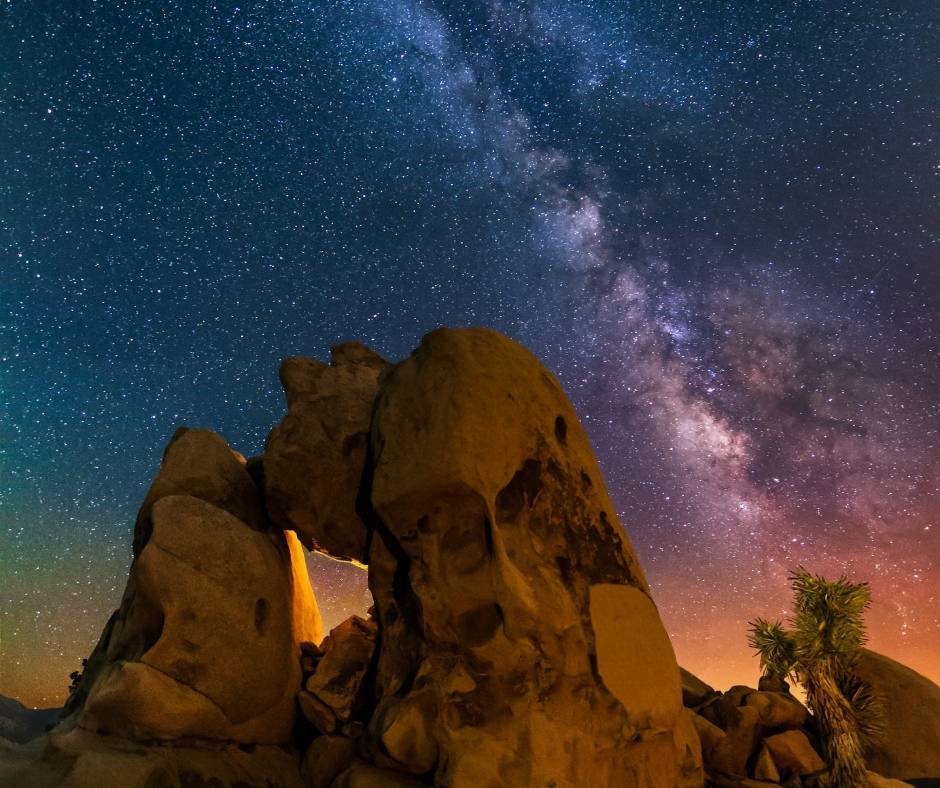
If the sky is clear (as it often is in the desert), consider staying to enjoy the desert at night. The night sky in Joshua Tree National Park is far diffrerent than most of us experience in the metropolitan areas we call home. The Milky Way is visible in Joshua Tree National Park, and the black sky is brilliantly dotted with stars.
Rangers will often host night sky programs and have their telescopes out for visitors to use. Check at the visitor centers to see if any programs are scheduled during your visit.
Explore more of California’s national parks. Check out our guide to the perfect Yosemite day trip.
]]>